LG Electronics USA 9QKE40530 HDD/DVD Recorder User Manual RH7927CML AA1CLL 0309
LG Electronics USA HDD/DVD Recorder RH7927CML AA1CLL 0309
Users Manual
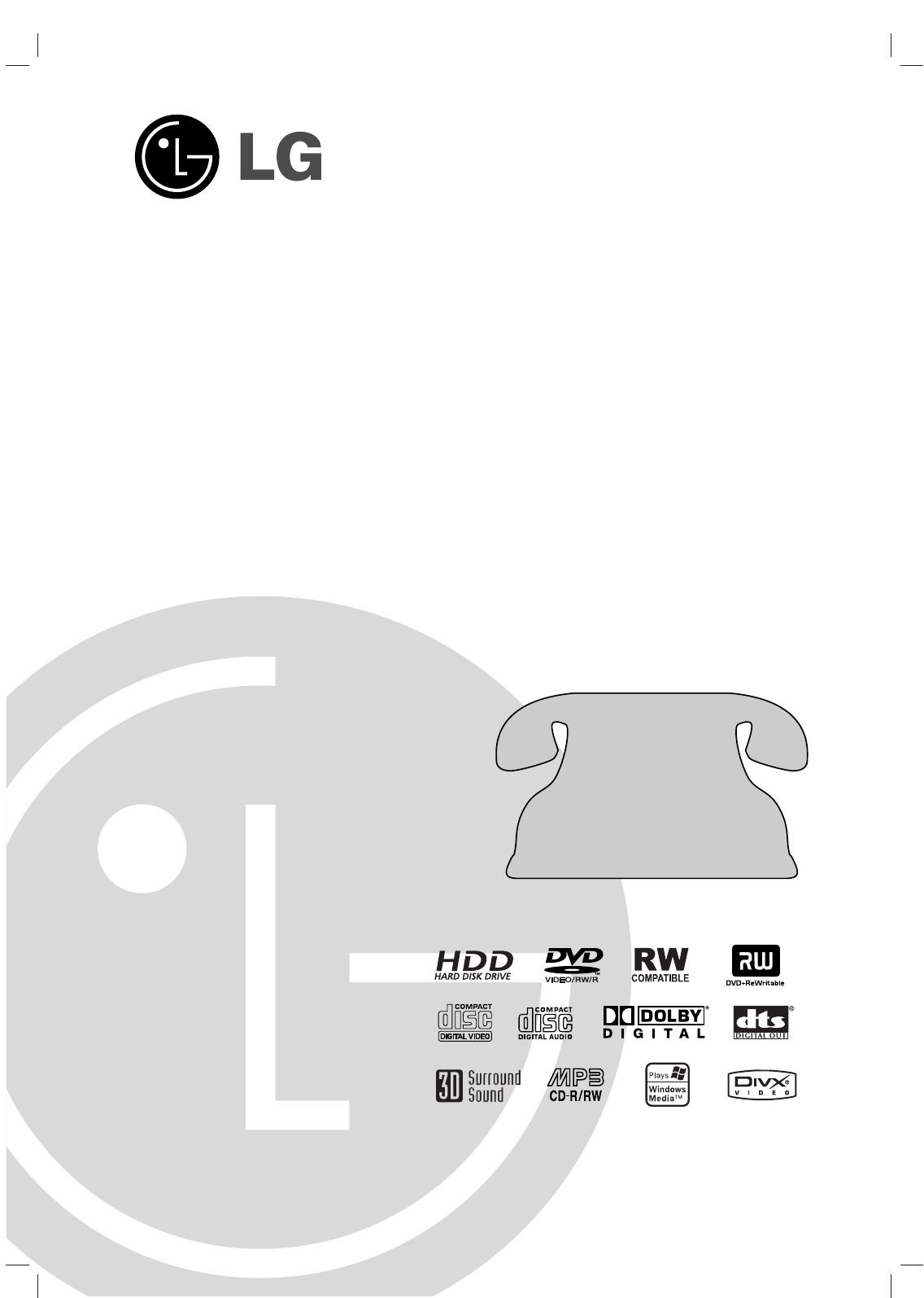
HDD/DVD
RECORDER
OWNER’S MANUAL
MODEL : LRH-539
Before connecting, operating or adjusting this product,
please read this instruction booklet carefully and completely.
RH7927CML.AA1CLL_EVNT
Call us and we will
guide you through
your first recording,
for free.
1-888-542-2623
(LGCANADA)
http://www.lg.Ca
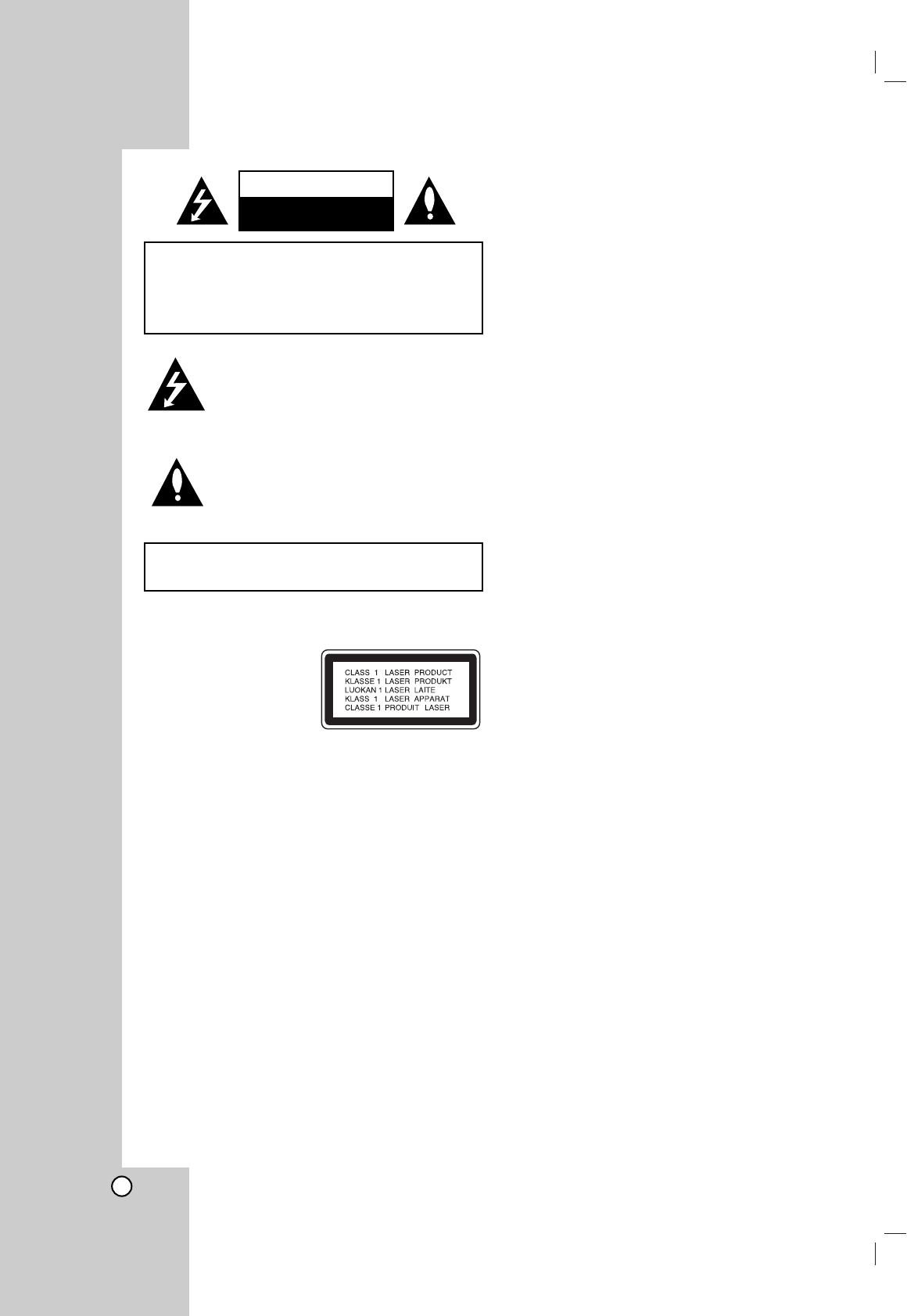
2
This lightning flash with arrowhead symbol within
an equilateral triangle is intended to alert the user
to the presence of uninsulated dangerous voltage
within the product’s enclosure that may be of
sufficient magnitude to constitute a risk of electric
shock to persons.
The exclamation point within an equilateral
triangle is intended to alert the user to the
presence of important operating and maintenance
(servicing) instructions in the literature
accompanying the product.
WARNING: Do not install this equipment in a confined space
such as a bookcase or similar unit.
CAUTION:
This product employs a Laser System.
To ensure proper use of this product, please read this
owner’s manual carefully and retain it for future reference.
Should the unit require maintenance, contact an authorized
service center.
Performing controls, adjustments, or carrying out procedures
other than those specified herein may result in hazardous
radiation exposure.
To prevent direct exposure to laser beam, do not try to open
the enclosure. Visible laser radiation when open. DO NOT
STARE INTO BEAM.
CAUTION:
VISIBLE AND INVISIBLE LASER RADIATION WHEN OPEN
AND INTERLOCKS DEFEATED.
CAUTION: The apparatus should not be exposed to water
(dripping or splashing) and no objects filled with liquids, such
as vases, should be placed on the apparatus.
FCC WARNING: This equipment may generate or use radio
frequency energy. Changes or modifications to this
equipment may cause harmful interference unless the
modifications are expressly approved in the instruction
manual. The user could lose the authority to operate this
equipment if an unauthorized change or modification is
made.
REGULATORY INFORMATION: FCC Part 15
This epuipment has been tested and found to comply with
the limits for a Class B digital device, pursuant to Part 15 of
the FCC Rules. These limits are designed to provide
reasonable protection against harmful interference when the
product is operated in a residential installation. This product
generates, uses, and can radiate radio frequency energy
and, if not installed and used in accordance with the
instruction manual, may cause harmful interference to radio
communications. However, there is no guarantee that
interference will not occur in a particular installation. If this
product does cause harmful interference to radio or
television reception, which can be determined by turning the
product off and on, the user is encouraged to try to correct
the interference by one or more of the following measures:
•Reorient or relocate the receiving antenna.
•Increase the separation between the product and
receiver.
•Connect the product into an outlet on a circuit
different from that to which the receiver is connected.
•Consult the dealer or an experienced radio/TV
technician for help.
CAUTION concerning the Power Cord
Most appliances recommend they be placed upon a
dedicated circuit;
That is, a single outlet circuit which powers only that
appliance and has no additional outlets or branch circuits.
Check the specification page of this owner's manual to be
certain.
Do not overload wall outlets. Overloaded wall outlets, loose
or damaged wall outlets, extension cords, frayed power
cords, or damaged or cracked wire insulation are dangerous.
Any of these conditions could result in electric shock or fire.
Periodically examine the cord of your appliance, and if its
appearance indicates damage or deterioration, unplug it,
discontinue use of the appliance, and have the cord replaced
with an exact replacement part by an authorized servicer.
Protect the power cord from physical or mechanical abuse,
such as being twisted, kinked, pinched, closed in a door, or
walked upon. Pay particular attention to plugs, wall outlets,
and the point where the cord exits the appliance.
SERIAL NUMBER:
You can find the serial number on the back of the unit. This
number is unique to this unit and not available to others. You
should record requested information here and retain this
guide as a permanent record of your purchase.
Model No. ______________________________
Serial No. ______________________________
CAUTION: TO REDUCE THE RISK
OF ELECTRIC SHOCK
DO NOT REMOVE COVER (OR BACK)
NO USER-SERVICEABLE PARTS INSIDE
REFER SERVICING TO QUALIFIED SERVICE
PERSONNEL.
WARNING: TO PREVENT FIRE OR ELECTRIC SHOCK
HAZARD, DO NOT EXPOSE THIS PRODUCT TO RAIN
OR MOISTURE.
CAUTION
RISK OF ELECTRIC SHOCK
DO NOT OPEN

3
Introduction
Contents
Introduction . . . . . . . . . . . . . . . . . . . . . . . . . . . .4-11
Symbol Used in this Manual . . . . . . . . . . . . . . . .4
Notes on Discs . . . . . . . . . . . . . . . . . . . . . . . . . .4
Recordable and Playable Discs . . . . . . . . . . . . .5
Playable Discs . . . . . . . . . . . . . . . . . . . . . . . . . .6
Remote Control Operation . . . . . . . . . . . . . . . . .6
About the internal hard disk drive . . . . . . . . . . . .7
Card useable on this unit . . . . . . . . . . . . . . . . . .7
Disc-related terms . . . . . . . . . . . . . . . . . . . . . . .8
Front Panel . . . . . . . . . . . . . . . . . . . . . . . . . . . . .9
Remote Control . . . . . . . . . . . . . . . . . . . . . . . .10
Rear Panel . . . . . . . . . . . . . . . . . . . . . . . . . . . .11
Hookup and Settings . . . . . . . . . . . . . . . . . . . .11-24
Connecting an Antenna or Cable TV . . . . . . . . .12
Connections to Your TV . . . . . . . . . . . . . . . . . .12
Connecting to an Amplifier . . . . . . . . . . . . . . . .13
Using the Home Menu . . . . . . . . . . . . . . . . . . .15
Initial Settings . . . . . . . . . . . . . . . . . . . . . . . . . .15
General Settings . . . . . . . . . . . . . . . . . . . . .15-18
Language Settings . . . . . . . . . . . . . . . . . . . .18-19
Audio Settings . . . . . . . . . . . . . . . . . . . . . . . . .19
Lock (Parental Control) Settings . . . . . . . . . .20-21
Recording Settings . . . . . . . . . . . . . . . . . . .21-22
Disc Settings . . . . . . . . . . . . . . . . . . . . . . . .22-23
General Explanation of On-Screen Display . . . .24
Playback . . . . . . . . . . . . . . . . . . . . . . . . . . . . .25-37
Playing a HDD, DVD, DivX file or Video CD .25-28
Playing a DivX Movie File . . . . . . . . . . . . . .29-30
Playing an Audio CD or MP3/WMA file . . . . .31-32
Program Playback with Audio CD and
MP3/WMA file . . . . . . . . . . . . . . . . . . . . . . . . . .33
Viewing a JPEG File . . . . . . . . . . . . . . . . . .34-35
Editing a MP3/WMA, JPEG, DivX file . . . . . .36-37
Recording . . . . . . . . . . . . . . . . . . . . . . . . . . . .38-43
About DVD recording . . . . . . . . . . . . . . . . . . . .38
About HDD recording . . . . . . . . . . . . . . . . . . . .38
Timeshift . . . . . . . . . . . . . . . . . . . . . . . . . . . . . .39
Basic Recording from a TV . . . . . . . . . . . . . . . .40
Instant Timer Recording . . . . . . . . . . . . . . . . . .40
Timer Recording . . . . . . . . . . . . . . . . . . . . . . . .41
Simultaneous recording and playback . . . . . . . .41
Checking Timer Recording Details . . . . . . . . . .42
Recording from an External Input . . . . . . . . . . .42
Recording from DV Input . . . . . . . . . . . . . . . . .43
Editting . . . . . . . . . . . . . . . . . . . . . . . . . . . . . .44-50
Title List and Chapter List Menu Overview . . . .44
HDD, VR Mode: Original and Playlist Editing . . .45
Adding Chapter Markers . . . . . . . . . . . . . . . . .45
Changing Title Thumbnails . . . . . . . . . . . . . . . .45
Making a New Playlist . . . . . . . . . . . . . . . . . . . .46
Adding Additional Title/Chapters to the Playlist .46
Deleting an Original or Playlist Title/Chapter . . .47
Deleting a Part . . . . . . . . . . . . . . . . . . . . . . . . .47
Naming a Title . . . . . . . . . . . . . . . . . . . . . . . . .48
Sort . . . . . . . . . . . . . . . . . . . . . . . . . . . . . . . . .48
Undoing/Redoing the Last Deletion . . . . . . . . . .48
Combining Two Titles Into One . . . . . . . . . . . . .49
Divide One Titles Into Two . . . . . . . . . . . . . . . .49
Combining Two Chapters Into One . . . . . . . . . .49
Moving a Playlist Chapter . . . . . . . . . . . . . . . . .50
Hide a Chapter/Title . . . . . . . . . . . . . . . . . . . . .50
Protect a Title . . . . . . . . . . . . . . . . . . . . . . . . . .50
Dubbing . . . . . . . . . . . . . . . . . . . . . . . . . . . . . .51-53
Before Dubbing . . . . . . . . . . . . . . . . . . . . . . . . .51
Dubbing from HDD to DVD . . . . . . . . . . . . . . .52
Dubbing from DVD to HDD . . . . . . . . . . . . . . . .52
One Touch Copy (HDD to DVD) . . . . . . . . . . . .53
One Touch Copy (DVD to HDD) . . . . . . . . . . . .53
Reference . . . . . . . . . . . . . . . . . . . . . . . . . . . .54-59
Additional Information . . . . . . . . . . . . . . . . . . . .54
Overwriting Recording . . . . . . . . . . . . . . . . .54
Viewing Title List menu displayed on other
DVD Recorders or Players . . . . . . . . . . . . .54
Playing Your Recordings on Other DVD
Players (Finalizing a Disc) . . . . . . . . . . . . . .54
Language Codes . . . . . . . . . . . . . . . . . . . . . . .55
Area Codes . . . . . . . . . . . . . . . . . . . . . . . . . . .55
Controlling Your TV with the Supplied
Remote Control . . . . . . . . . . . . . . . . . . . . . . . .56
Troubleshooting . . . . . . . . . . . . . . . . . . . . . .57-58
Specifications . . . . . . . . . . . . . . . . . . . . . . . . . .59
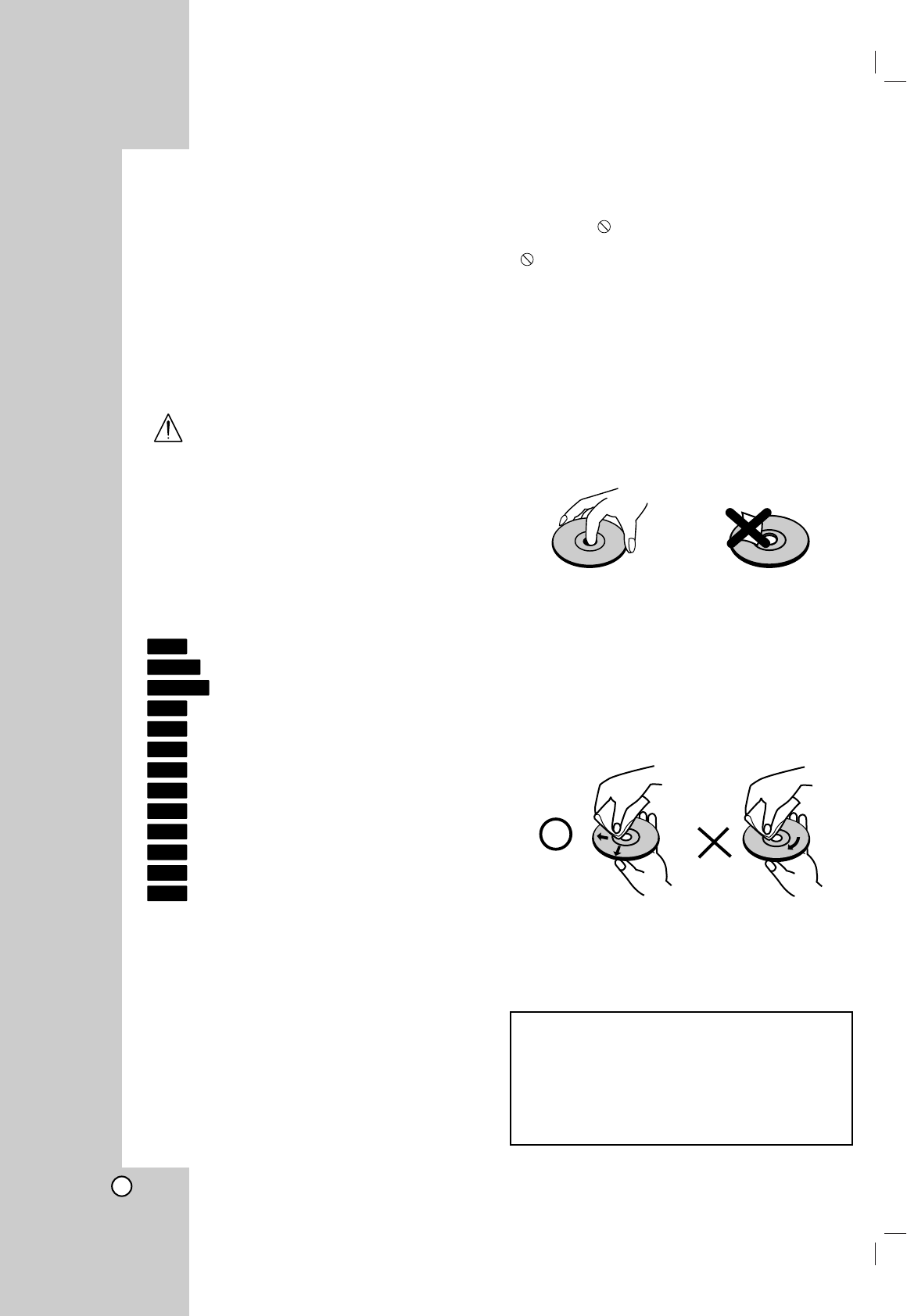
4
To ensure proper use of this product, please read this
owner’s manual carefully and retain for future
reference.
This manual provides information on the operation
and maintenance of your recorder. Should the unit
require service, contact an authorized service location.
Symbol Used in this Manual
Indicates hazards likely to cause harm to the
unit itself or other material damage.
Note:
Indicates special notes and operating features.
Tip:
Indicates tips and hints for making the task easier.
Asection whose title has one of the following symbols
is applicable only to the disc represented by the
symbol.
Titles recorded on the HDD
DVD-RW with VR recording mode
DVD-RW with Video recording mode
DVD+RW disc
DVD-R disc
DVD+R disc
DVD-Video disc
Video CDs
Audio CDs
DivX files
MP3 files
WMA files
JPEG files
About the Symbol Display
“ ” may appear on your TV display during
operation and indicates that the function explained in
this owner’s manual is not available on that specific
DVD video disc.
Notes on Discs
Handling Discs
Do not touch the playback side of the disc. Hold the
disc by the edges so that fingerprints do not get on
the surface. Never stick paper or tape on the disc.
Storing Discs
After playing, store the disc in its case. Do not expose
the disc to direct sunlight or sources of heat and never
leave it in a parked car exposed to direct sunlight.
Cleaning Discs
Fingerprints and dust on the disc can cause poor
picture quality and sound distortion. Before playing,
clean the disc with a clean cloth. Wipe the disc from
the center out.
Do not use strong solvents such as alcohol, benzine,
thinner, commercially available cleaners, or anti-static
spray intended for older vinyl records.
JPEG
WMA
MP3
DivX
ACD
VCD
DVD
+R
-R
+RW
-RWVideo
-RWVR
HDD
Introduction
Moisture Condensation
Never operate this product immediately after
moving it from a cold location to a warm location.
Leave it for two or three hours without operating it.
If you use this product in such a situation, it may
damage discs/tapes and internal parts.
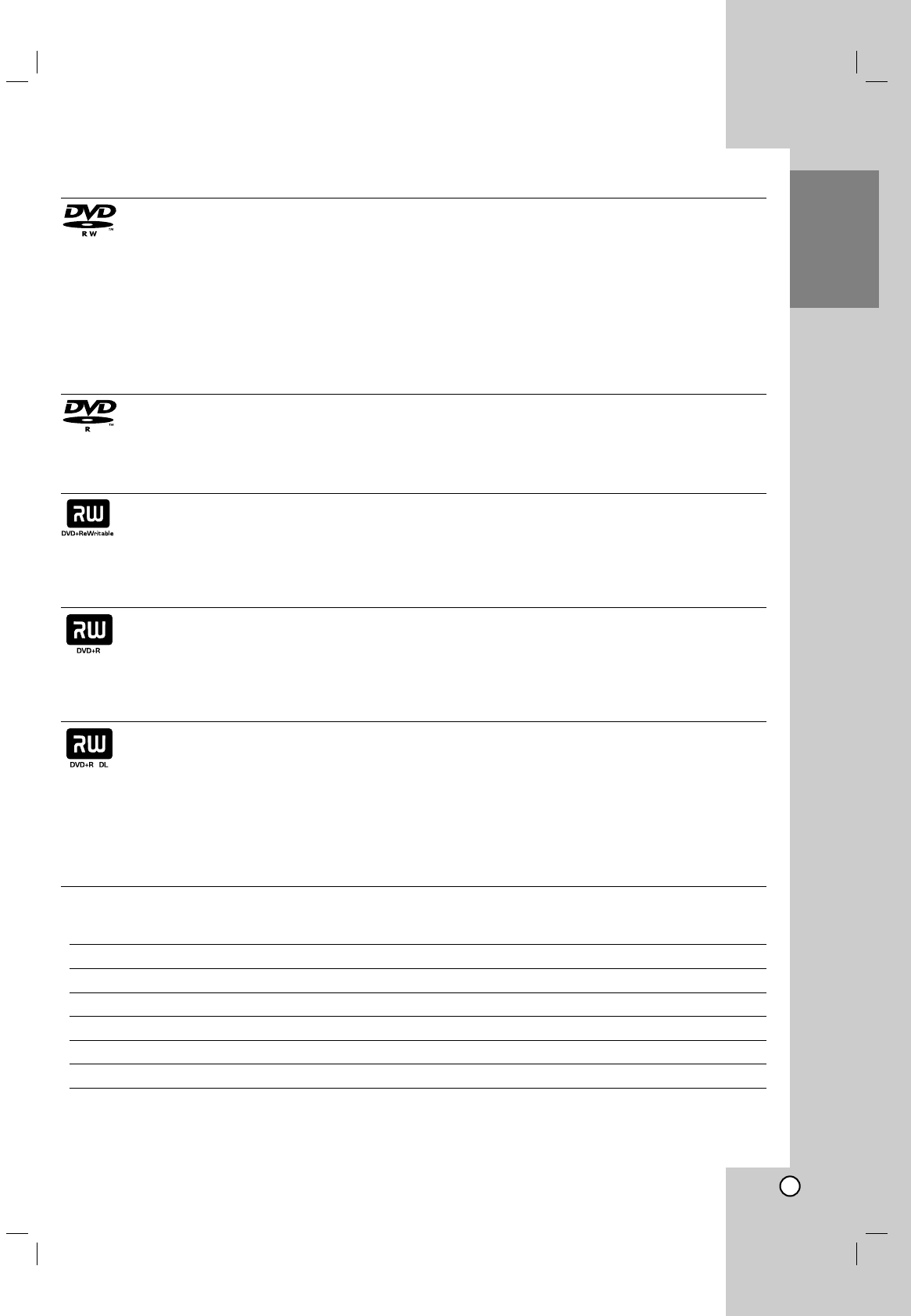
5
Introduction
Recordable and Playable Discs
DVD-RW (DVD - ReWritable)
DVD-RW discs can be formatted for VR mode recording or Video mode recording.
These Discs can be recorded on repeatedly. Recordings can be erased, then you can record again on the same
Disc.
[VR mode]
Recordings can be extensively edited
Playable only on VR mode compatible players (after finalization)
[Video mode]
Playable on regular DVD players (after finalization)
Limited editing features
DVD-R (DVD - Recordable)
These Discs can be recorded only once. After you finalize a DVD-R, you cannot record on it or edit it.
DVD-R discs can be only formatted to Video mode.
Playable on regular DVD players (after finalization)
Limited editing features
DVD+RW (DVD+ ReWritable)
These Discs can be recorded on repeatedly. Recordings can be erased, then you can record again on the same
Disc.
Playable on DVD+RW compatible players (automatically finalization)
The edited contents is playable on DVD+RW compatible players only after finalizing
Recordings can be edited the title/chapter
DVD+R (DVD + Recordable)
These Discs can be recorded only once. After you finalize a DVD+R, you cannot record on it or edit it any more.
Playable on DVD+R compatible players (after finalization)
Any edited contents are not be compatible on DVD+R compatible players. (Hide, chapter combine, added
chapter mark, etc.)
Limited title/chapter editing features.
DVD+R DL (DVD + Recordable; Double Layer)
These Discs can be recorded only once. After you finalize a DVD+R DL, you cannot record on it or edit it any
more.
Storage space is nearly doubled with double layer DVD+R media, allowing consumers to burn up to 8.5GB of
video on a single DVD+R DL disc.
Playable on DVD+R compatible players (after finalization)
Any edited contents are not be compatible on DVD+R DL compatible players. (Hide, chapter combine, added
chapter mark, etc.)
Limited title/chapter editing features.
The recommendable recordable DVD discs
DVD-R DVD+R DVD-RW DVD+RW DVD+R(DL)
SONY (8x, 16x) SONY (2.4x, 4x, 8x, 16x) Victor (1x, 4x) SONY (2.4x) Mitsubishi (2.4x)
TDK (4x, 8x) TDK (4x) Maxell (1x, 2x, 4x) TDK (2.4x) Maxell (2.4x)
Imation (2x, 4x) Imation (2.4x, 4x, 8x) Imation (2x) Philips (4x) Verbatim (2.4x)
Verbatim (4x, 8x) Mitsubishi (4x, 8x) VerbatimTDK (2x) Ricoh (2.4x) -
Panasonic (2x, 4x) Ricoh (2x, 4x, 8x) Mitsubishi (2x) HP (2.4x, 4x) -
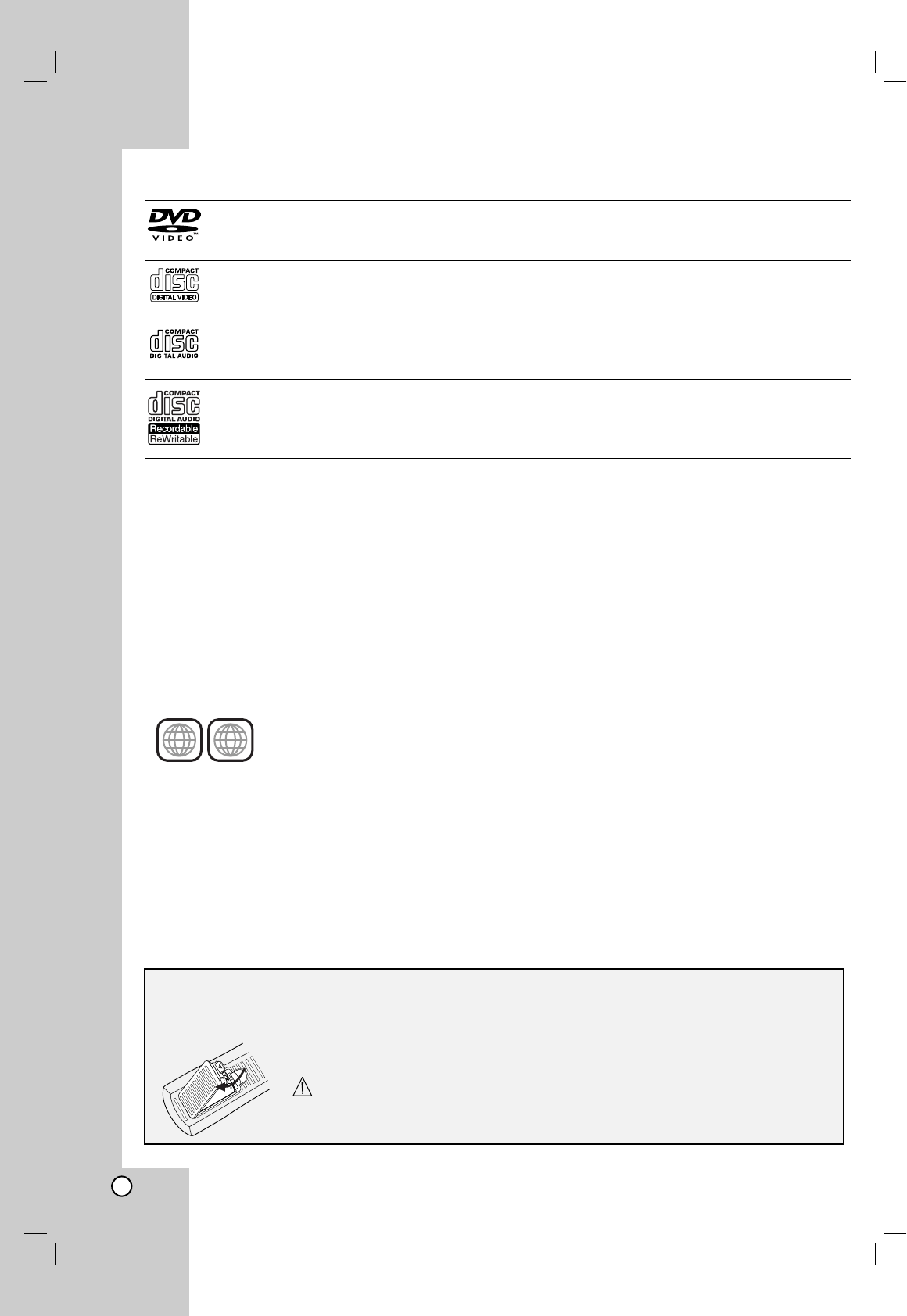
6
Playable Discs
DVD (8 cm / 12 cm disc)
Discs such as movies that can be purchased or rented
Video CD (VCD) (8 cm / 12 cm disc)
VIDEO CDs or CD-Rs/CD-RWs in VIDEO CD/Super VIDEO CD format
Audio CD (8 cm / 12 cm disc)
Music CDs or CD-Rs/CD-RWs in music CD format that can be purchased
CD-R/CD-RW (8 cm / 12 cm disc)
CD-R/CD-RW discs that contain audio titles, MP3, WMA, JPEG or DivX files.
Notes:
•Depending on the conditions of the recording equipment or the CD-R/RW (or DVD±R/±RW) disc itself, some
CD-R/RW (or DVD±R/±RW) discs cannot be played on the unit.
•Do not attach any seal or label to either side (the labeled side or the recorded side) of a disc.
•Do not use irregularly shaped CDs (e.g., heart-shaped or octagonal). Doing so may result in malfunctions.
•Depending on the recording software & the finalization, some recorded discs (CD-R/RW or DVD±R/RW) may
not be playable.
•DVD-R/RW, DVD+R/RW and CD-R/RW discs recorded using a personal computer or a DVD or CD Recorder
may not play if the disc is damaged or dirty, or if there is dirt or condensation on the Recorder’s lens.
•If you record a disc using a personal computer, even if it is recorded in a compatible format, there are cases
in which it may not play because of the settings of the application software used to create the disc. (Check
with the software publisher for more detailed information.)
Regional code of the recorder and DVDs
This recorder is designed and manufactured for playback of Region 1 encoded DVD software.
The region code on the labels of some DVD discs indicates which type of the recorder can
play those discs. This unit can play only DVD discs labeled 1 or ALL. If you try to play any
other discs, the message “Incorrect region code. Can’t play back” will appear on the TV screen. Some DVD
discs may not have a region code label even though their playback is prohibited by area limits.
Notes on DVDs and Video CDs
Some playback operations of DVDs and Video CDs may be intentionally fixed by software manufacturers. As
this unit plays DVDs and Video CDs according to disc content designed by the software manufacturer, some
playback features of the unit may not be available or other functions may be added.
Refer also to the instructions supplied with the DVDs and Video CDs. Some DVDs made for business purposes
may not be played on the unit.
1
ALL
About the Remote Control
Point the remote control at the remote sensor and press the buttons.
Battery installation
Detach the battery cover on the rear of the remote control, and insert two (R03/AAA)
size batteries with 3and #aligned correctly.
Caution
Do not mix old and new batteries and never mix different types of batteries such as
standard, alkaline, etc.
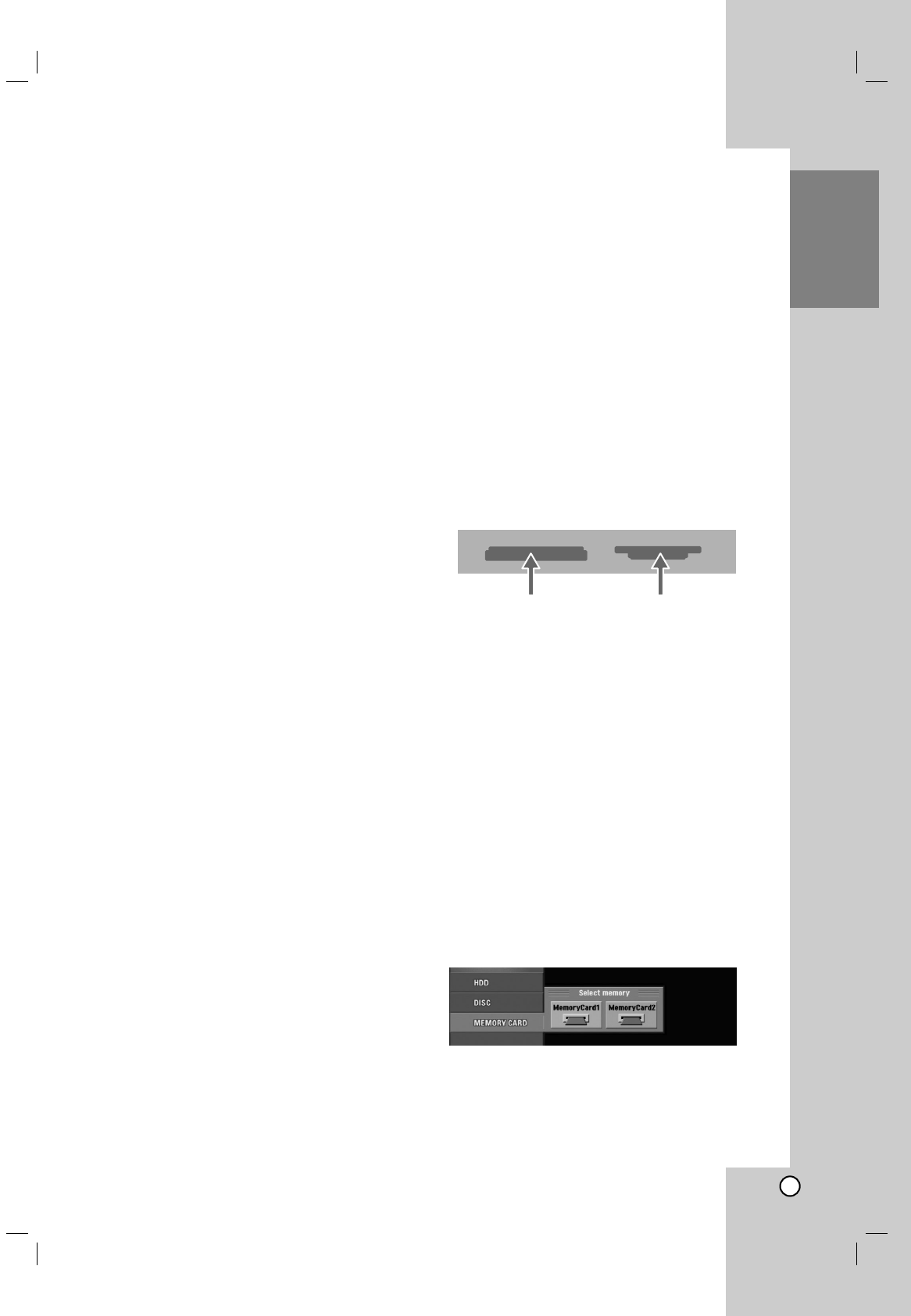
7
Introduction
About the internal hard disk
drive
The internal hard disk drive (HDD) is a fragile piece of
equipment. Please use the recorder following the
guidelines below to protect against possible HDD
failure.
We recommend that you back up your important
recordings onto DVD discs in order to protect against
accidental loss.
Do not move the recorder while it is on.
Install and use the recorder on a stable, level
surface.
Do not block the rear vent/cooling fan.
Do not use the recorder in excessively hot or humid
places, or in places that may be subject to sudden
changes in temperature. Sudden changes in
temperature can cause condensation to form inside
the recorder. This can be a cause of HDD failure.
While the recorder is switched on, do not unplug
from the wall socket or switch the electricity off from
the breaker switch.
Do not move the recorder immediately after
switching it off. If you need to move the recorder,
please follow the steps below:
1. After the message POWER OFF is shown in the
display, wait at least two minutes.
2. Unplug from the wall socket.
3. Move the recorder.
If there’s a power failure while the recorder is on
there is a chance that some data on the HDD will
be lost.
The HDD is very delicate. If used improperly or in
an unsuitable environment, it is possible that the
HDD will fail after a few years of use. Signs of
problems include playback unexpectedly freezing
and noticeable block noise (mosaic) in the picture.
However, sometimes there will be no warning signs
of HDD failure.
If the HDD fails, no playback of recorded material
will be possible. In this case it will be necessary to
replace the HDD unit.
Card useable on this unit
Compact Flash Card (CF)
Micro Drive (MD)
Secure Digital Card (SD)
Multi Media Card (MMC)
SmartMedia Card (SMC)
xD-Picture Card (xD)
Memory Stick (MS)
Memory Stick Pro (MS-Pro)
magicstor (except magicstor PLUS)
Compatible with: FAT 12, FAT 16, or FAT 32
Only use the memory cards recommended above.
Regarding Write Protect
For cards that have a write protect switch, if the switch
is on it will not be possible to write, erase or format
the card.
Inserting/Removing the Memory Card
Inserting the card: Insert straight-in until it fits into
place.
Removing the card: Withdraw the card carefully.
Notes:
•Keep the memory card out of reach of children. If
swallowed, seek medical advice immediately.
•Amemory card may not be used for this recorder
•Do not extract the memory card in operating
(play, copy, move, etc.).
Using Memory Card
1. Insert a memory card.
2. Press HOME on the remote control.
3. Select [MEMORY CARD] option then press B.
4. Select [Memory Card 1] or [Memory Card 2] then
press ENTER.
5. Select the [TV(HDD)], [MUSIC], or [PHOTO]
option.
Details for the options are on page 17.
Insert CF, MD, or
magicstor card
Insert SD, MMC, SMC,
xD, MS, or MS-Pro card

8
Disc-related terms
DVD +R (Double Layer)
Double layer recording technology offers two
recordable layers on a single DVD disc, providing
nearly double the capacity of 4.7GB single layer
DVDs. The greatest, most valuable benefit of double
layer recording technology is increased capacity.
Storage space is nearly doubled with double layer
DVD+R media, allowing consumers to burn up to
8.5GB of video on a single DVD+R disc.
DVD ±R / DVD ±RW
DVD -R and DVD +R are two different standards for
recordable DVD drives and discs. This format allows
information to be recorded onto the DVD disc only
once. DVD +RW and DVD -RW are two standards for
re-writable media, meaning the DVD content can be
erased and re-recorded. Single-sided discs can hold
4.38 Gigabytes and double-sided discs hold twice as
much. There are no double layer single sided
recordable discs.
VCD (Video CD)
AVCD holds up to 74 minutes (650 MB disc) or 80
minutes (700 MB disc) of MPEG-1 full-motion video
along with quality stereo sound.
MPEG
MPEG is an international standard for video and audio
compression. MPEG-1 is used in encoding video for
VCD and provides for multichannel surround sound
coding such as PCM, Dolby Digital, DTS and MPEG
audio.
MP3
MP3 is a popular compression format used for digital
audio files that yields very high near-CD quality.
WMA
Windows media audio file. A type of coding / decoding
developed by Microsoft Corp.
JPEG
Joint Pictures Expert Group. JPEG is a compressed
file format that allows you to save images with no limit
on the number of colors.
DivX
DivX is the name of a revolutionary new video codec
which is based on the new MPEG-4 compression
standard for video.You will be able to play DivX
movies using this recorder.
PBC: Playback Control (Video CD only)
Playback control is available for Video CD (VCD)
version 2.0 disc formats. PBC allows you to interact
with the system via menus, search functions, or other
typical computer-like operations. Moreover, still
pictures of high resolution can be played if they are
included in the disc. Video CDs not equipped with
PBC (Version 1.1) operate in the same way as audio
CDs.
Title (DVD video discs only)
Atitle is generally a distinct section of a DVD disc. For
example the main feature could be title 1, a
documentary describing how the film was made could
be title 2, and cast interviews could be title 3. Each
title is assigned a reference number enabling you to
locate it easily.
Chapter (DVD video discs only)
Achapter is a segment of a title such as a scene in a
film or one interview in a series. Each chapter is
assigned a chapter number, enabling you to locate the
chapter you want. Depending on the disc, chapters
may not be recorded.
Scene (VCD)
On a video CD with PBC (playback control) functions,
moving pictures and still pictures are divided into
sections called “scenes”. Each scene is displayed in
the menu screen and assigned a scene number,
enabling you to locate the scene you want. A scene is
composed of one or several tracks.
Track
Adistinct element of audiovisual information, such as
the picture or sound track for a specific language
(DVD), or a musical piece on a video or audio CD.
Each track is assigned a track number, enabling you
to locate the track you want. DVD discs allow one
track of video (with multiple angles) and several tracks
of audio.
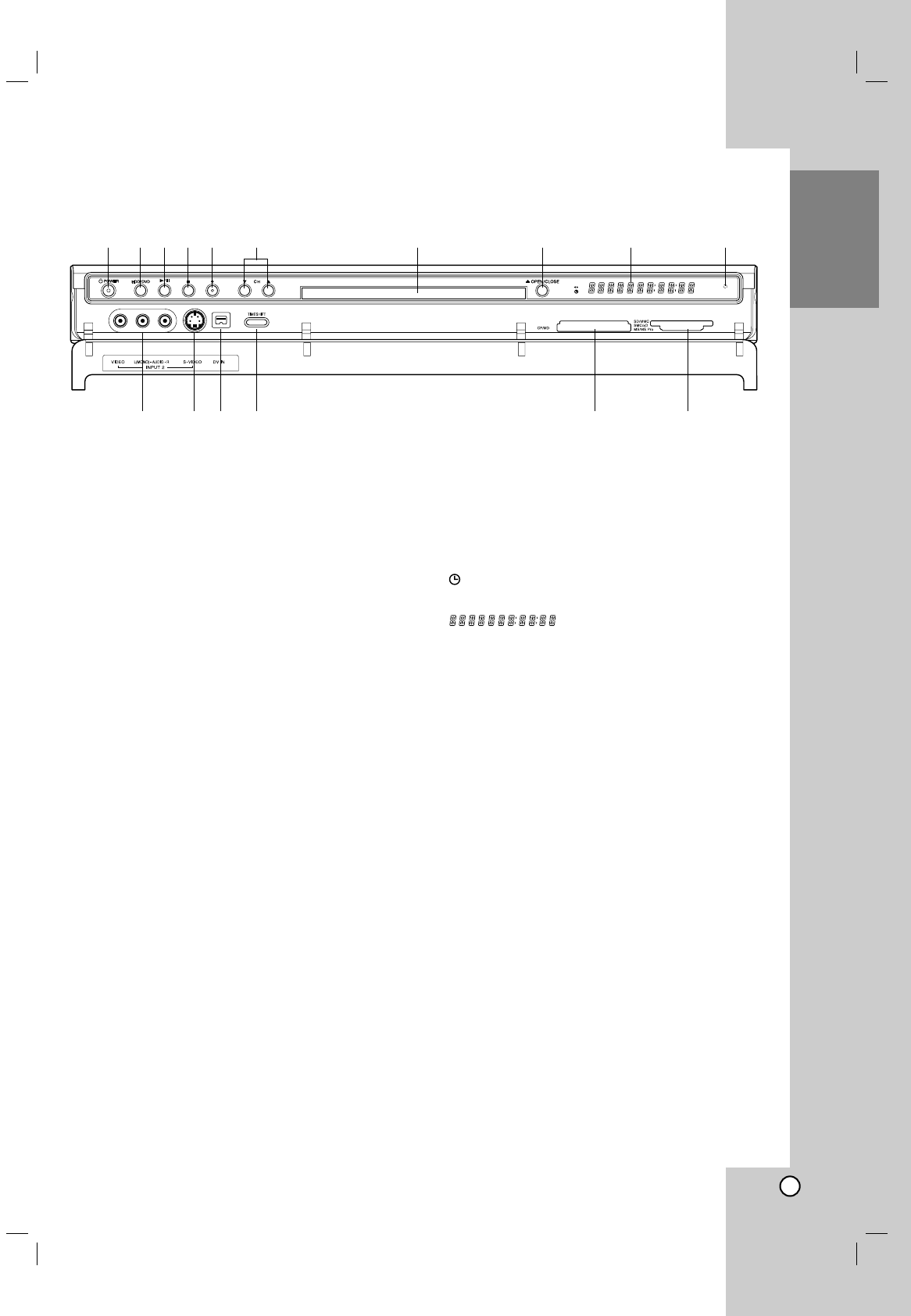
9
Introduction
aPOWER button and indicator
Switches the recorder ON or OFF.
Lights up red when the recorder is in standby
mode.
bHDD/DVD
Set the recorder’s mode to HDD or DVD.
cN/ X(PLAY / PAUSE)
Starts playback.
Pause playback or recording temporarily,
press again to exit pause mode.
dx(STOP)
Stops playback or recording.
ez(REC)
Starts recording. Press repeatedly to set the
recording time.
fCH (V/v)
Scans up or down through memorized channels.
gDisc Tray
Insert a disc here.
hOPEN/CLOSE (Z)
Opens or closes the disc tray.
iDisplay window
Shows the current status of the recorder.
T/S: Indicates the timeshifting mode.
REC: The recorder is recording.
HDD: The recorder is HDD mode.
DVD: The recorder is DVD mode.
HDD bBDVD: The recorder is dubbing.
TV: Indicates when the recorder is in TV tuner
mode.
:Indicates when the recorder is in timer
recording or a timer recording is programmed.
: Indicates clock, total playing
time, elapsed time, title number, chapter/track
number, channel, etc.
jRemote Sensor
Point the recorder remote control here.
kINPUT 2 (VIDEO IN/AUDIO IN (Left/Right))
Connect the audio/video output of an external
source (Audio system, TV/ Monitor, VCR,
Camcorder, etc.).
lINPUT 2 (S-VIDEO IN)
Connect the S-Video output of an external source
(TV/ Monitor, VCR, Camcorder, etc.).
mDV IN
Connect the DV output of a digital camcorder.
nTIMESHIFT
Activates pause live TV/playback (timeshift) for a
live TV program.
oMEMORY CARD Slot 1
Insert a memory card (CF/MD/magicstor).
pMEMORY CARD Slot 2
Insert a memory card (SD/MMC/SMC/xD/MS/MS
Pro).
Front Panel
T/S REC
HDD
TV
DVD
abcde f g h i j
klmn o p
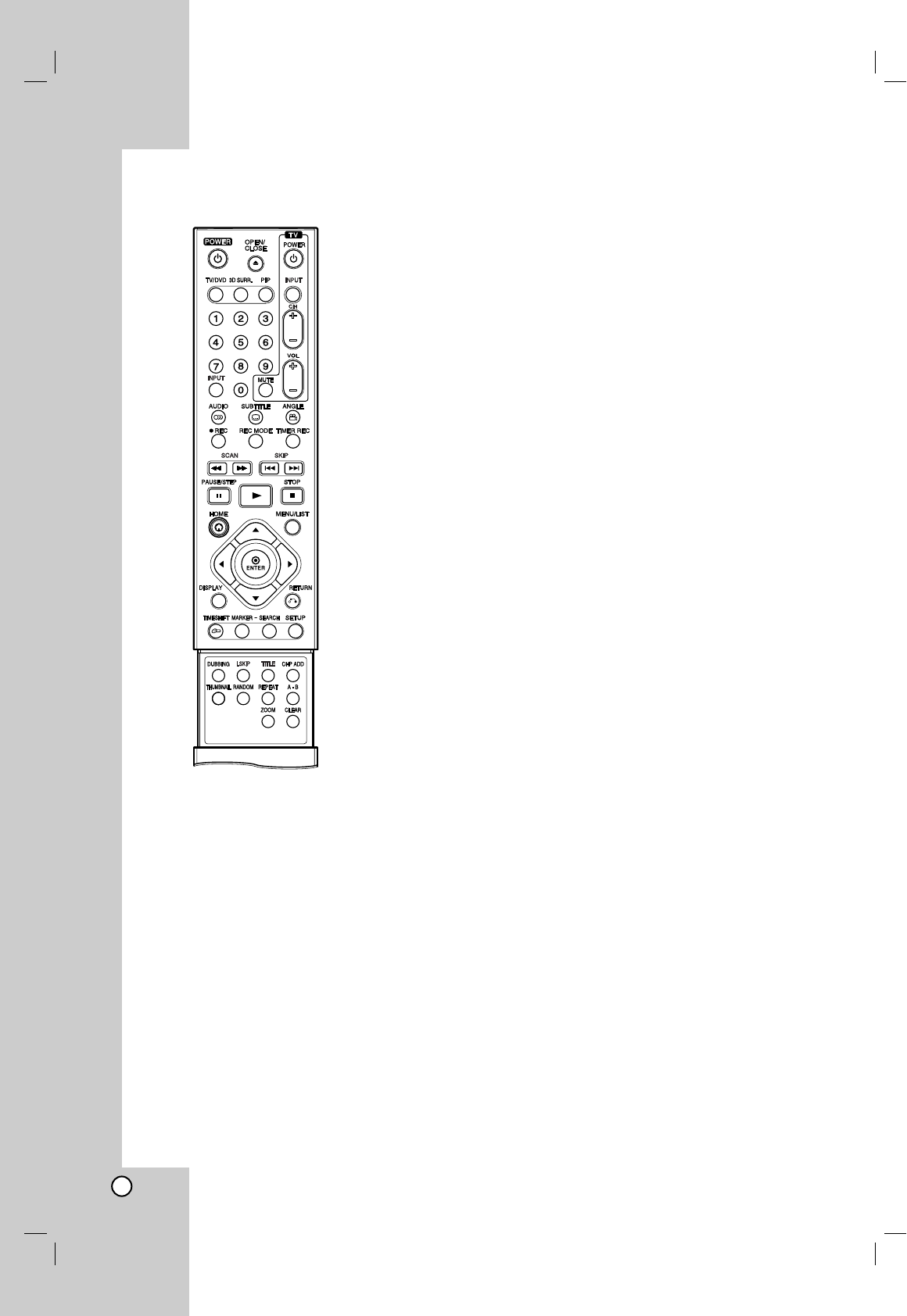
10
0-9 numerical buttons: Selects
numbered options in a menu.
3D SURR.: Selects 3D
SURROUND during playback.
b/ B/ v/ V(left/right/up/down):
Selects an option in the menu.
v/ V (up/down): Scans up or
down through memorized
channels.
A-B: Repeat sequence.
ANGLE: Selects a DVD camera
angle, if available.
AUDIO: Selects an audio
language (DVD) or an audio
channel (VCD).
INPUT: Changes the input to use
for recording (Tuner, AV1-2, or DV
IN).
CHP ADD: Inserts a chapter
marker when playing/recording.
CLEAR: Removes a track number
on the Program List or a mark on
the Marker Search menu.
DISPLAY: Accesses On-Screen
Display.
DUBBING: Copies DVD to HDD
(or HDD to DVD).
ENTER
-Acknowledges menu selection.
-Displays information while
viewing a TV program.
HOME: Accesses or removes the
HOME menu.
I.SKIP (INSTANT SKIP) : Skips 15
seconds forward on the disc
(about the length of a typical TV:
commercial).
MARKER: Marks any point during
playback.
MENU/LIST: Accesses menu on a
DVD disc. Switches between Title
List-Original and Title List-Playlist
menu.
OPEN/CLOSE (Z): Opens and
closes the disc tray.
PAUSE/STEP (X) : Pause
playback or recording temporarily,
press again to exit pause mode.
PIP: Selects PIP function on or off.
N(PLAY): Starts playback.
POWER: Switches the recorder
ON or OFF.
RANDOM: Plays tracks in random
order.
zREC: Starts recording. Press
repeatedly to set the recording
time.
REC MODE: Selects the recording
mode (HQ, SQ, LQ or EQ).
REPEAT: Repeat chapter, track,
title, all.
RETURN (O)
-Removes the menu.
-Displays the menu of a video CD
with PBC.
SCAN (m/ M): Search
backward or forward.
SEARCH: Displays Marker Search
menu.
SETUP: Accesses or removes the
Setup menu.
SKIP (./ >): Go to next
chapter or track. Returns to
beginning of current chapter or
track or go to previous chapter or
track.
STOP (x): Stops playback or
recording.
SUBTITLE: Selects a subtitle
language.
THUMBNAIL: Selects a thumbnail
picture for the current title and
chapter for use in the Original and
Playlist menu.
TIMER REC: Displays Timer
Record menu.
TIMESHIFT: Activates pause live
TV/playback (timeshift) for a live
TV program.
TITLE: Displays the disc’s Title
menu, if available.
TV/DVD: To view channels
selected by the recorder tuner or
by the TV tuner.
TV Control Buttons
-POWER: Turns the TV on or off.
-INPUT: Selects the TV’s source.
-CH +/–: Selects TV’s channel.
-VOL +/–: Adjusts TV’s volume.
-MUTE: Temporarily turns TV
sound OFF, press again to
restore.
ZOOM: Enlarges DVD video
image.
Remote Control
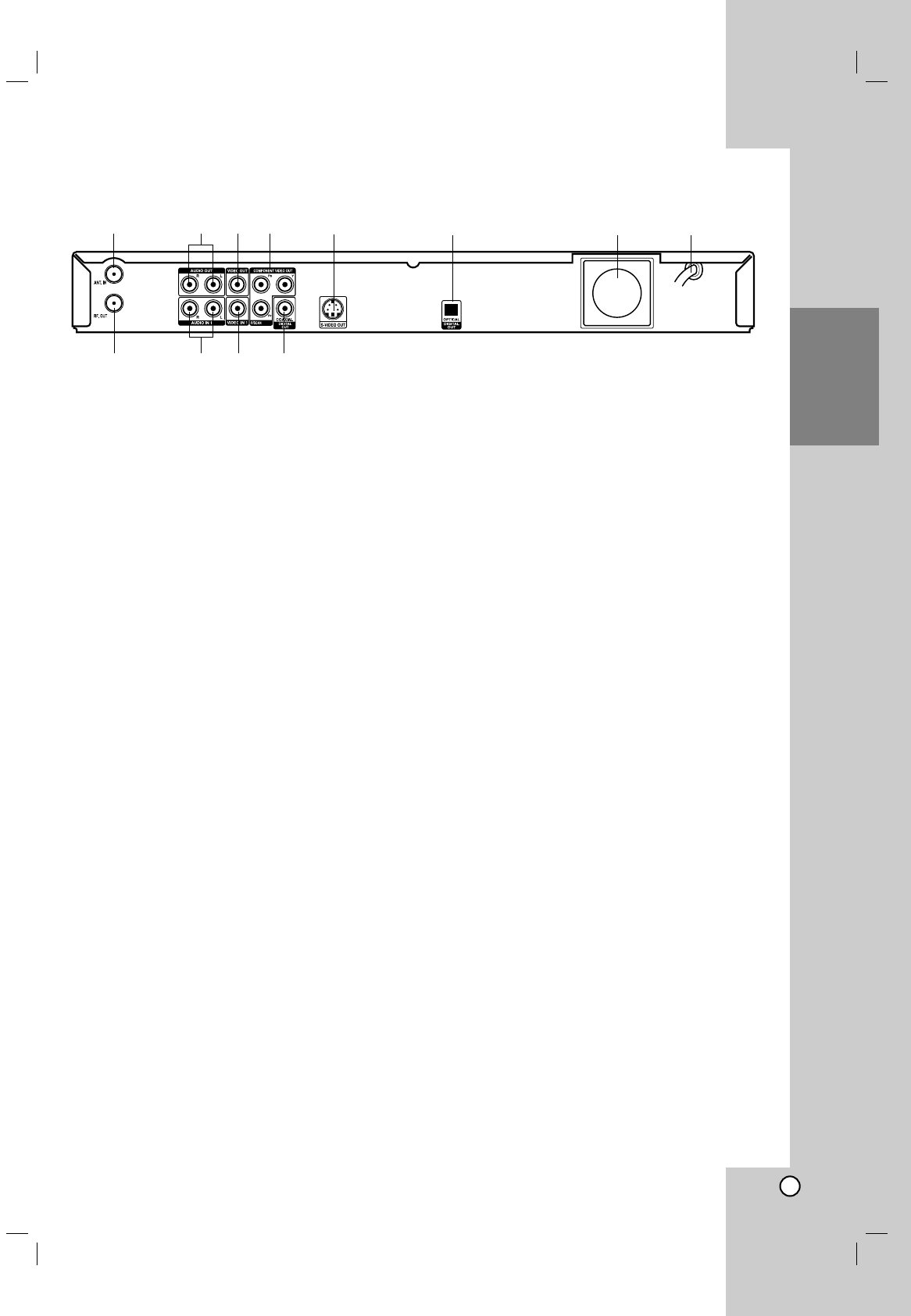
11
Hookup and
Settings
aANT.IN
Connect the antenna to this terminal.
bAUDIO OUT (Left/Right)
Connect to a TV with audio inputs.
cVIDEO OUT
Connect to a TV with video inputs.
dCOMPONENT VIDEO OUT/PROGRESSIVE
SCAN (Y Pb Pr)
Connect to a TV with Y Pb Pr inputs.
eS-VIDEO OUT
Connect to a S-Video Input on TV.
fOPTICAL (Digital audio out jack)
Connect to digital (optical) audio equipment.
gCooling fan
hAC Power Cord
Plug into the power source.
iRF. OUT
Connect to a TV with RF coaxial inputs.
jAUDIO IN 1 (Left/Right)
Connect the audio output of an external source
(Audio system, TV/Monitor, VCR, Camcorder).
kVIDEO IN 1
Connect the video output of an external source
(Audio system, TV/Monitor, VCR, Camcorder).
lCOAXIAL (Digital audio out jack)
Connect to digital (coaxial) audio equipment.
abcde f gh
ijkl
Rear Panel
Hookup and Settings
Depending on your TV and other equipment there are various ways you can connect the
recorder. Please refer to the manuals of your TV, VCR, Stereo System or other devices as
necessary for additional connection information.
Notes:
•Make sure the Recorder is connected directly to the TV and tune the TV to the correct video input channel.
•Do not connect the Recorder’s AUDIO OUT jack to the phono in jack (record deck) of your audio system.
Do not connect the Recorder via another VCR. The DVD image could be distorted by the copy protection system.
•The picture and sound of a nearby TV, VCR, or radio may be distorted during playback. Position the units away from each
other or turn off the unit after removing the disc.
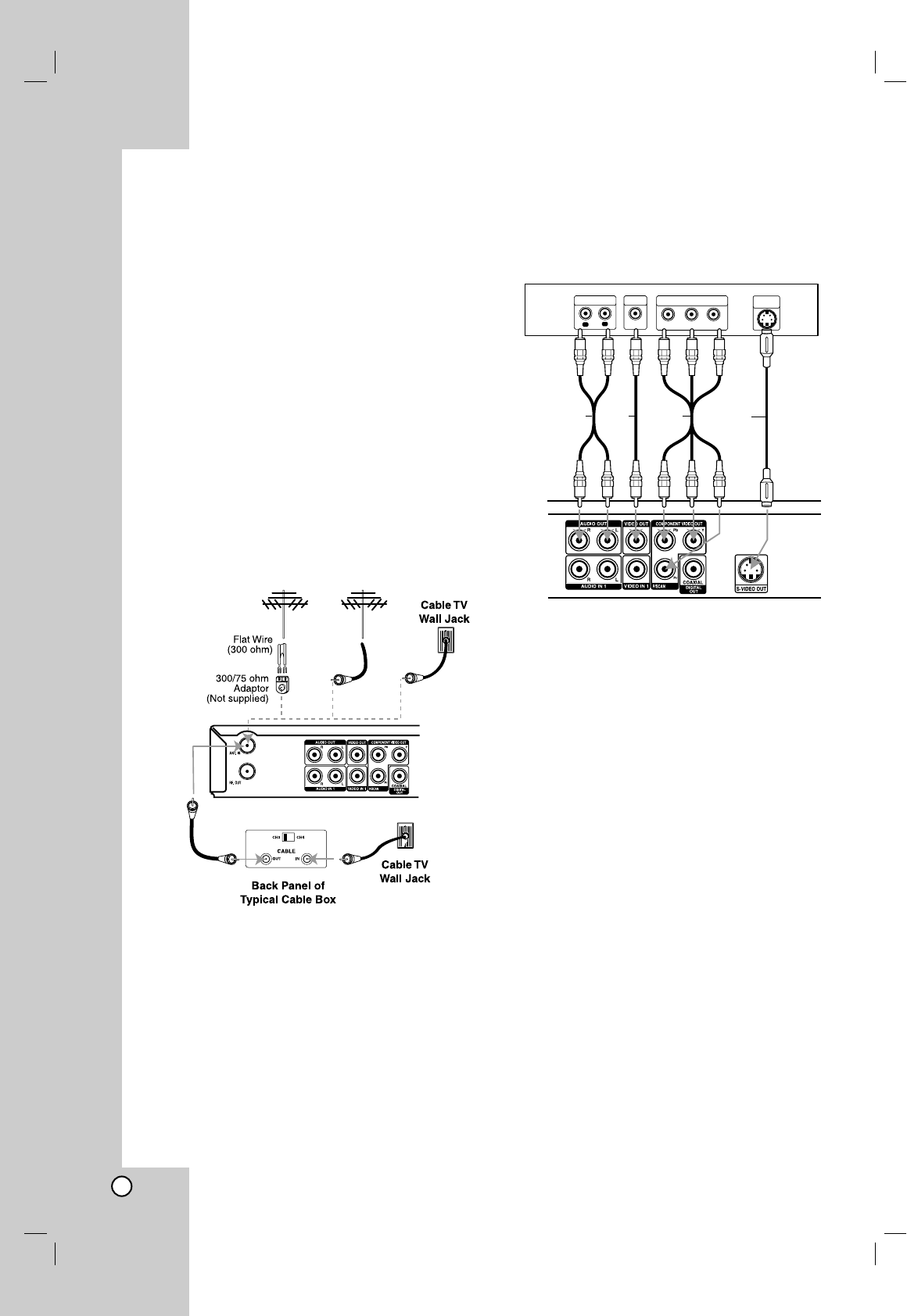
12
Connecting an
Connecting an Antenna
Antenna
or Cable TV
or Cable TV
aaAntenna:
Disconnect the antenna from the rear of the TV and
identify the antenna cable. If it is a round 75 ohm
coaxial cable connect it directly to the jack marked
ANT.IN on your Recorder. If your antenna cable is flat
connect it to a 300-ohm to 75-ohm antenna adaptor
(not supplied) and slip the adaptor over the ANT.IN
jack. Don’t attempt to screw it into to the Recorder.
bbCable TV:
If your cable connection has no converter or
descrambler, unscrew the cable from your TV and
attach it to the ANT.IN jack on the Recorder. If a
converter is required connect a coaxial cable from the
wall jack to the IN connector on the converter, and a
coaxial cable from the OUT connector on the
converter to the ANT.IN on your Recorder. This cable
hookup permits both TV and Recorder operation.
To view or record a CATV channel
1Tune the TV to the Recorder output channel (CH 3
or 4).
2Set the Recorder channel selector to the cable
output channel. (Example: CH3)
3Select a channel using the cable converter.
Notes:
•With this connection, you cannot record one program
while viewing another.
•If you are using a cable box to tune channels, it is not
necessary to do Auto Channel Set.
Connections to your TV
Connections to your TV
Make one of the following connections, depending on
the capabilities of your TV.
RF coaxial connection
Connect the RF.OUT jack on the Recorder to the
antenna in jack on the TV using the supplied 75-ohm
Coaxial Cable (R). TV RF.OUT jack passes the signal
through from the ANT.IN jack.
How to set the Recorder’s RF output channel
1. When the Recorder is turned off, press and hold
CH (V/v) on the front panel for more than five
seconds. [ch03] or [ch04] appears in the display
window.
2. Press CH (V/v) to change the RF output channel
(ch03 or ch04).
3. Tune the TV to this channel.
Video connection
Connect the DVD/VCR VIDEO OUT jack on the
Recorder to the video in jack on the TV using the
video cable supplied (V).
Note:
If you use this connection, set the TV’s source selector to
VIDEO.
S-Video connection
Connect the S-VIDEO OUT jack on the Recorder to
the S-Video in jack on the TV using the optional
S-Video cable (S).
Antenna Antenna
OR OR
a
b
Rear of the recorder
L
R
AUDIO INPUT VIDEO
INPUT
Pr
Pb
Y
Rear of TV
A V C
COMPONENT/PROGRESSIVE SCAN
VIDEO INPUT
S
S-VIDEO
INPUT

13
IntroductionHookup and
Settings
Playback
RecordingEdittingDubbingReference
Component Video / Progressive Scan
connection
If your television is a high-definition or “digital ready”
television, you may take advantage of the Recorder’s
progressive scan output for the highest video
resolution possible.
Connect the COMPONENT/PROGRESSIVE SCAN
VIDEO OUT jacks on the Recorder to the
corresponding in jacks on the TV using an optional Y
Pb Pr cable (C).
Notes:
•Set Progressive Scan option to [ON] in the setup menu,
see page 17.
•Progressive Scan does not work with the RF,
Audio/Video or S-Video connections.
•If your TV does not accept the Progressive Scan format,
the picture will appear scrambled.
•When you use Component Video signal, set the
Progressive Scan to [OFF] on the setup menu.
Audio connection
Connect the Left and Right DVD/VCR AUDIO OUT
jacks on the Recorder to the audio left/right in jacks
on the TV using the supplied audio cables (A).
Connection to an
Connection to an Amplifier
Amplifier
Connecting to an amplifier equipped with two
channel analog stereo or Dolby Pro Logic II/Pro
Logic
Connect the Left and Right AUDIO OUT (or DVD/VCR
AUDIO OUT) jacks on the Recorder to the audio left
and right in jacks on your amplifier, receiver, or stereo
system using the audio cables (A) supplied.
Connecting to an amplifier equipped with two
channel digital stereo (PCM) or to an Audio/Video
receiver equipped with a multi-channel decoder
(Dolby Digital™, MPEG 2, or DTS)
1. Connect one of the Recorder’s DIGITAL AUDIO
OUT jacks ( OPTICAL O, COAXIAL X) to the
corresponding in jack on your amplifier. Use an
optional digital (OPTICAL O, COAXIAL X) audio
cable.
2. You will need to activate the Recorder ’s digital
output. (See [Audio Settings] on page 19).
Digital Multi-channel sound
Adigital multi-channel connection provides the best
sound quality. For this you need a multi-channel
Audio/Video receiver that supports one or more of the
audio formats supported by your Recorder (MPEG 2,
Dolby Digital and DTS). Check the receiver manual
and the logos on the front of the receiver.
Caution:
Due to the DTS Licensing agreement, the digital
output will be in DTS digital out when DTS audio
stream is selected.
Notes:
•If the audio format of the digital output does not match
the capabilities of your receiver, the receiver will produce
a strong, distorted sound or no sound at all.
•Six Channel Digital Surround Sound via digital
connection can only be obtained if your receiver is
equipped with a Digital Multi-channel decoder.
•To see the audio format of the current DVD in the on-
screen display, press AUDIO.
•This Recorder does not perform internal (2 channel)
decoding of a DTS sound track. To enjoy DTS multi
channel surround, you must connect this Recorder to a
DTS compatible receiver via one of this Recorder’s
digital audio outputs.
Manufactured under license from Dolby
Laboratories. “Dolby”, “Pro Logic”, and the
double-D symbol are trademarks of Dolby
Laboratories.
DTS and DTS Digital Out are trademarks of
Digital Theater Systems, Inc.
Rear of the recorder
R
L
AUDIO INPUT DIGITAL INPUT
COAXIAL
DIGITAL INPUT
OPTICAL
Amplifier (Receiver)
A X O
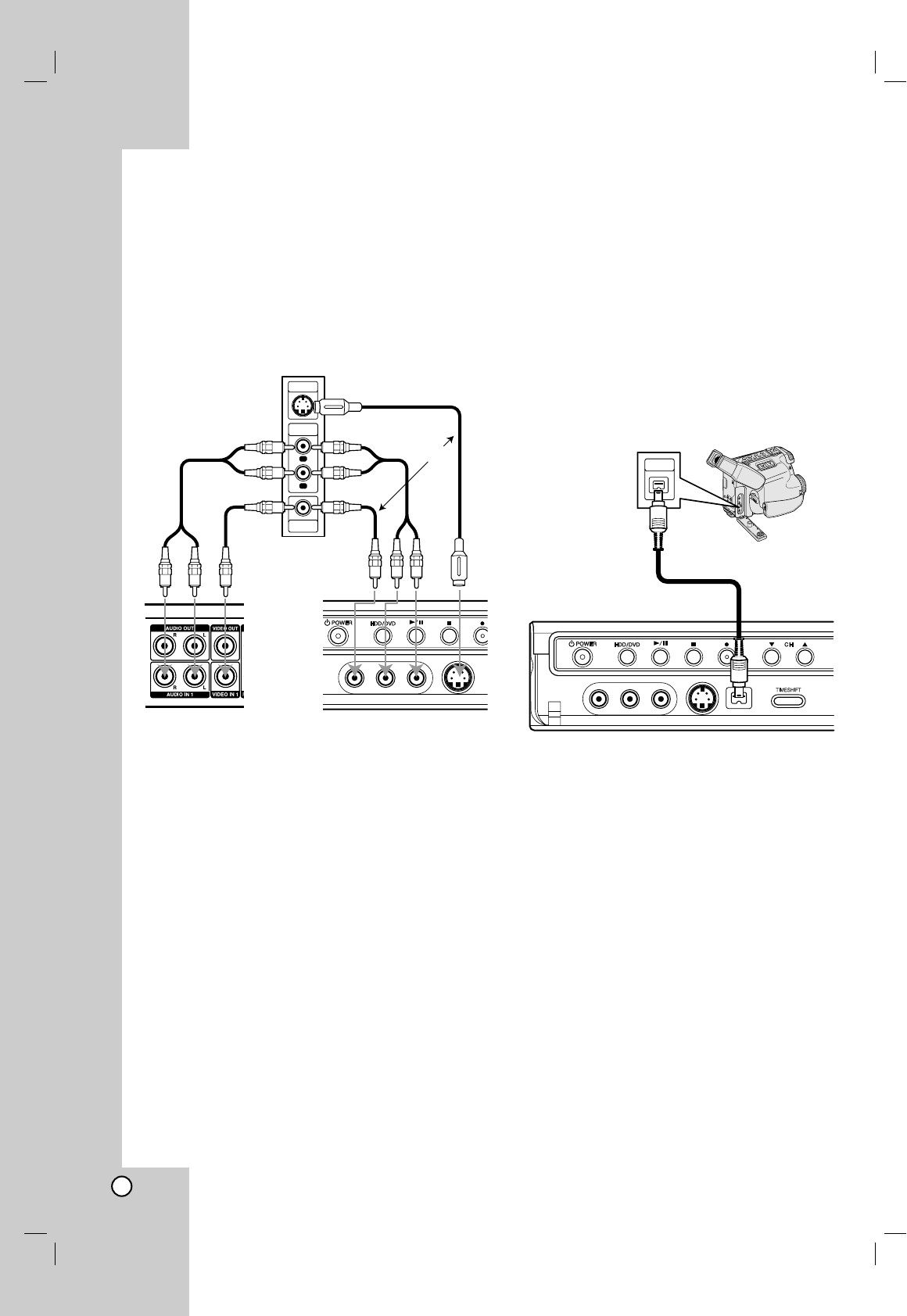
14
Connecting to the INPUT 1 or INPUT 2
Jacks
Connect the input jacks (INPUT1, INPUT2) on the
recorder to the audio/video out jacks on your
accessory component, using audio/video cables.
Note:
If you use the S-VIDEO IN jack on the front panel, the
VIDEO IN jack on the front panel is not available.
Connecting a Digital Camcorder
Using the front panel DV IN jack, it is possible to
connect a DV digital camcorder and digitally transfer
DV tapes to DVD.
Use a DV cable (not supplied) to connect the DV
in/out jack of your DV camcorder to the front panel DV
IN jack of this recorder.
Note:
This jack is for connection to DV digital camcorder
only. It is not compatible with digital satellite tuners or
D-VHS video decks.
L
R
VIDEO
OUTPUT
AUDIO
OUTPUT
S-VIDEO
OUTPUT
Jack panel of Accessory Component
(VCR, Camcorder, etc.)
Rear of
the recorder
Front of
the recorder
OR
OR
DV Digital Camcorder
Front of the recorder
DV
IN/OUT

15
Hookup and
Settings
Using the Home Menu
Using the Home Menu
From the Home Menu screen you can access all the
Media (HDD, DISC, MEMORY CARD) for playback
and recording of the recorder.
1. Press HOME to display the Home Menu screen.
2. Use the v/ Vand ENTER buttons to select a
media you want. Options appears.
3. Use the v/ Vand ENTER buttons to select the
option you want.
4. To exit the HOME menu, press HOME.
TV (HDD): Returns to live TV viewing for HDD
recording.
TV (DVD): Returns to live TV viewing for DVD
recording.
TITLE LIST: Displays the Title List menu.
MOVIE: Plays back the movie of the DVD-Video,
Video CD. Or Displays Movie menu.
MUSIC: Displays Music (or Audio CD) menu.
PHOTO: Displays Photo menu.
Initial Settings
Initial Settings
In this menu system, there are several ways to
customize the settings provided. Most menus consist
of three levels to set up the options, but some require
greater depth for the variety of settings.
General Operation
1. Press SETUP and the Setup menu appears.
2. Use v / V to select the desired option.
3. While the desired item is selected, press Bto
move to the second level.
4. Use v / V to select the second desired option.
5. Press Bto move to the third level.
6. Use v / V to select the desired setting then press
ENTER to confirm your selection.
Some items require additional steps.
7. Press SETUP to exit the Setup menu.
Note:
Press bto go back to the previous level.
General Settings
General Settings
Tuning Band Select
1Select the [Tuning Band] option then press B.
2Use v / V to select the tuning band (TV or CATV)
option then press ENTER.
TV: If you are using a standard antenna to receive
channels.
CATV: If you are using basic cable to receive
channels.
Auto Channel Set
Connect the Recorder to the desired type of antenna
or cable TV system as shown on page 16.
This Recorder is equipped with a frequency
synthesized tuner capable of receiving up to 181
channels. These include VHF channels 2-13, UHF
channels 14-69 and CATV channels 1-125.
1Select the [Auto Channel Set] option.
2Press Bto move to the third level.
[Start] icon is highlighted.
3Press ENTER to begin the channel search.
The tuner will automatically cycle through all
available channels in the area and place them in
the tuner’s memory.
Note:
After the Auto Channel Set proceeding is complete,
make sure the Tuning Band is set appropriately (TV or
CATV) on tuning band, follow steps 1~3 as shown
previous (Tuning Band Select) to choose the correct
Tuning Band (TV or CATV).
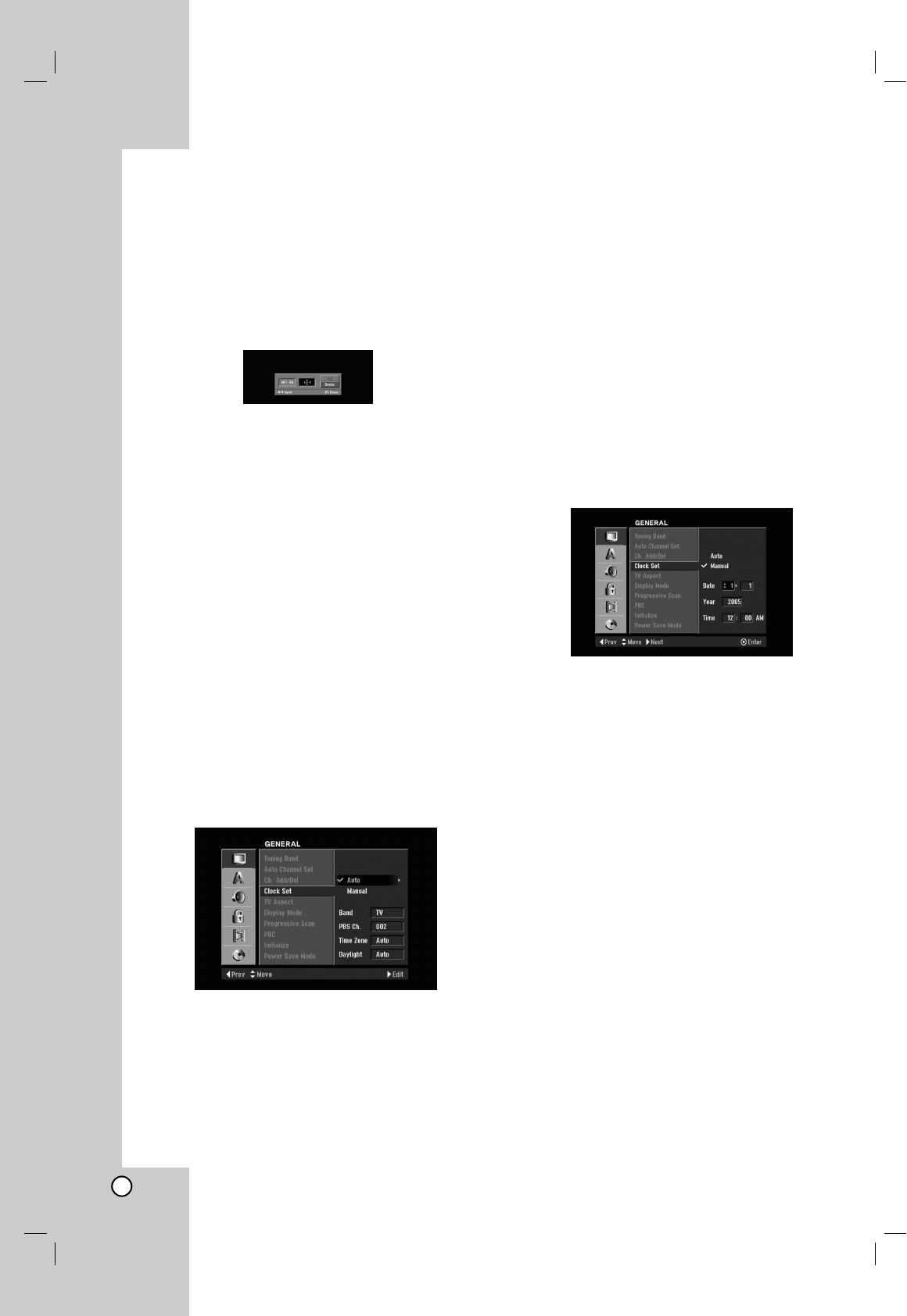
16
To Add or Erase Channels from Memory
This feature allows you to add to or erase channels
from memory manually.
1. Select the [CH. Add/Del] option.
2. Press Bto move to the third level.
[Edit] icon is highlighted.
3. Press ENTER and the Channel Edit menu
appears.
4. Use v / V or number buttons to select a channel
then press b.
5. Use v / V to tunes the channel to obtain a clear
picture, then press ENTER.
6. Press B.
[Add] or [Delete] icon is highlighted.
7. Press ENTER to confirm your setting.
8. Repeat steps 4-7 to add or erase additional
channels.
9. Press SETUP or RETURN to exit the menu.
Clock Set
1. Select the [Clock Set] option.
2. Press Bto move to the third level.
Auto
The Auto option is set at the factory. In the Auto option,
the Recorder looks for a channel carrying XDS
(Extended Data Services) information. XDS updates the
clock using the Coordinated Universal Time.
1. Use b/B to choose the option and use v/V to
change the setting.
[Band] Select the band.
[PBS Ch.] Select the channel.
[Time Zone] Choose your time zone.
When Timezone is set to Auto, the Recorder will
use XDS information to determine the proper
setting.
[Daylight] Choose the Daylight Savings.
When it is set to Auto, the Recorder will use
XDS information to determine the proper setting.
2. Press ENTER to confirm your setting.
Note :
The Auto Clock Feature enables the Recorder to set up
the clock when the Recorder is turned off.
Manual
If your local TV station does not send date and time
information, or sends incorrect information, you can set
the clock manually.
1. Enter the necessary information for year, date and
time.
b / B (left/right): Moves the cursor to the previous or
next column.
v / V (up/down): Changes the setting at the current
cursor position.
2. Press ENTER to confirm your setting.
3. Press SETUP to exit the Setup menu.
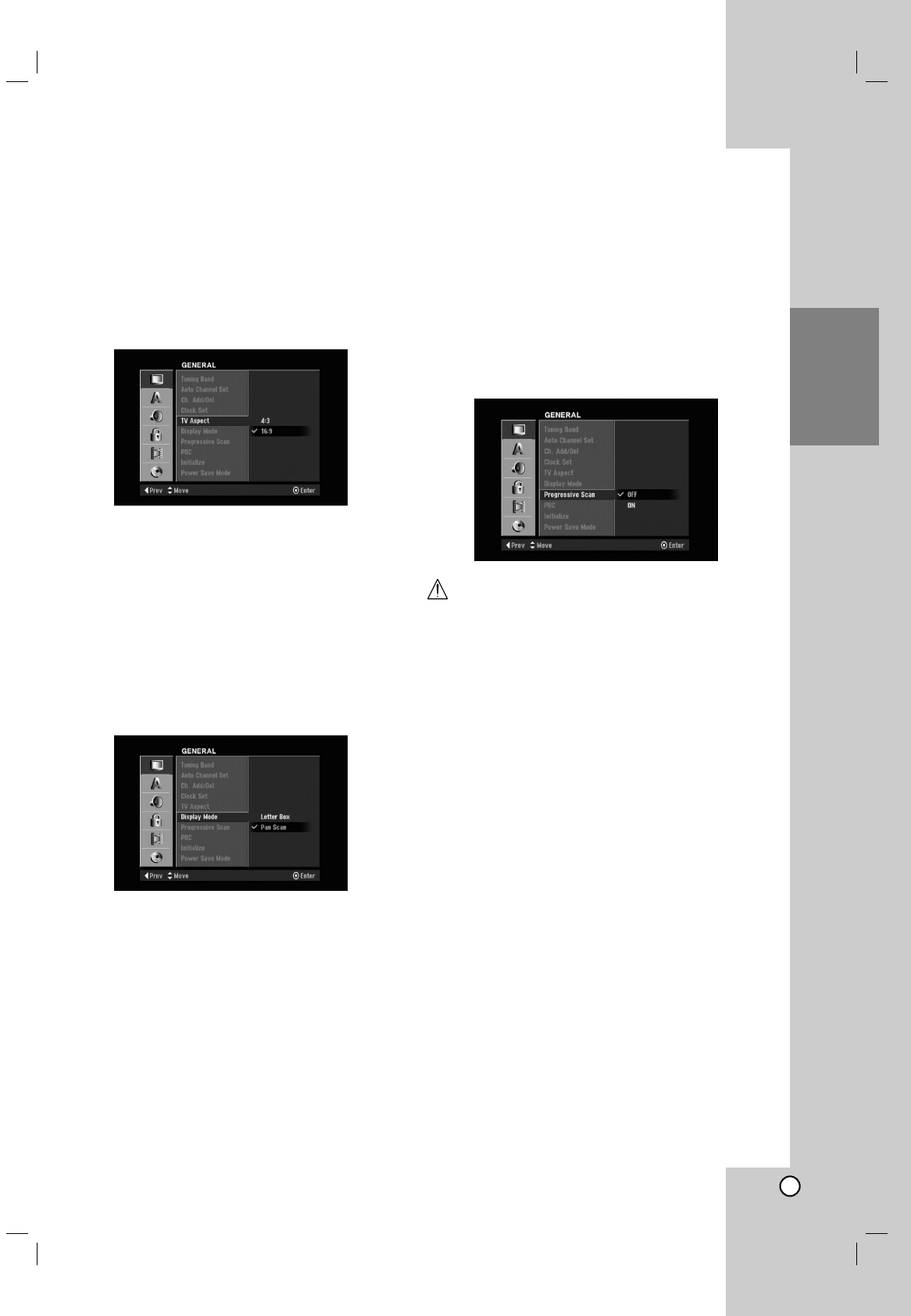
17
Hookup and
Settings
TV Aspect
Selects the aspect ratio of the connected TV (4:3
standard or wide).
[4:3] Select this when connecting to a 4:3 screen
TV. When you select [4:3], set [Display Mode]
below.
[16:9] Select this when connecting to a wide-screen
TV or TV with a wide mode function.
Display Mode
Selects how to display a wide picture on the screen
when [4:3] is selected in [TV Aspect].
[Letter Box] Displays a wide picture with bands on
the upper and lower portions of the screen.
[Pan Scan] Automatically displays a wide picture on
the entire screen and cuts off the portions that do
not fit.
Progressive Scan
Progressive Scan Video provides the highest quality
pictures with less flickering.
[ON] :Using the COMPONENT/PROGRESSIVE
SCAN VIDEO OUT jacks for connection to
a TV or monitor that is compatible with a
progressive scan signal.
[OFF] :Using the COMPONENT/PROGRESSIVE
SCAN VIDEO OUT jacks, but are
connecting the Recorder to a standard
(analog) television.
Caution
Once the setting for Progressive Scan output is
entered, an image will only be visible on a
Progressive Scan compatible TV or monitor. If you set
Progressive Scan to [ON] in error, you must reset the
Recorder. First, remove the disc in the Recorder.
Next, press STOP (x) and hold it for five seconds
before releasing it. The video output will be restored to
the standard setting, and a picture will once again be
visible on a conventional analog TV or monitor.
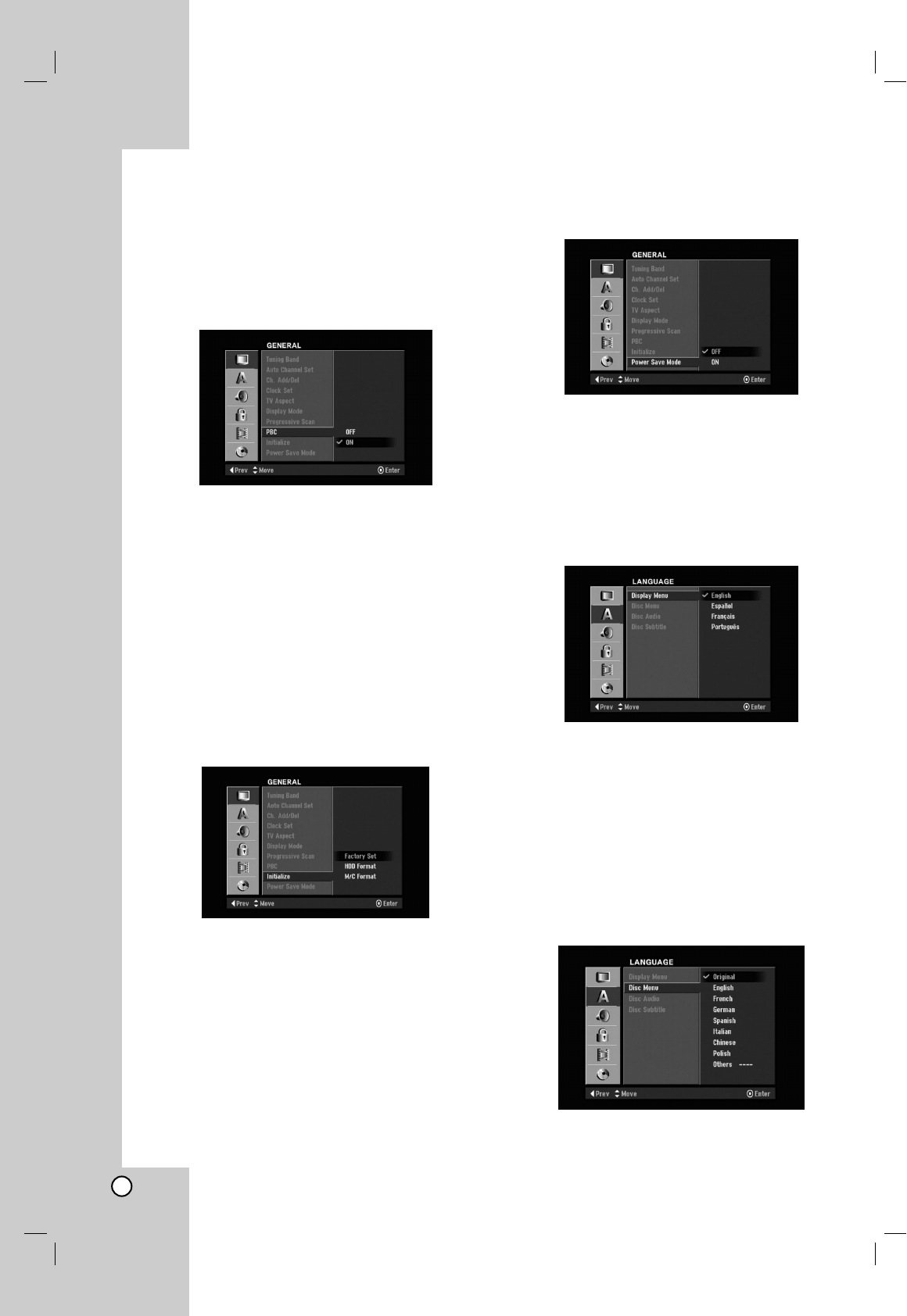
PBC
PBC stands for Playback Control and refers to special
menus and navigation features that are available on
some Video CDs.
[ON] Video CDs are played according to the PBC, if
available.
[OFF] Video CDs are played the same way as Audio
CDs.
Initialization
You can reset the recorder to its original factory
settings and initialize the HDD or Memory Card.
[Factory Set] You can reset the Recorder to its
original factory settings. Some options cannot be
reset (Rating, Password, and Area Code).
[HDD Format] Initializes the HDD (Hard Disk Drive):
everything recorded on the HDD will be erased.
[M/C Format] Initializes the M/C (Memory Card):
everything recorded on the Memory Card will be
erased.
1. Select [Initialize] option then press B.
2. Press v/ Vto select the desired option then press
ENTER.
The confirm message will appear.
3. Use b/ Bto select [Yes] or [No] then press
ENTER.
Power Save Mode
Set Power Save Mode to On to place your DVD/VCR
Recorder into an economic power save mode.
Language Settings
Language Settings
Display Menu
Select a language for the Setup menu and information
display.
Disc Menu/Audio/Subtitle
[Original]Refers to the original language in which
the disc was recorded.
[Other] To select another language, press number
buttons then ENTER to enter the corresponding
4-digit number according to the language code list
in the reference chapter (see page 58). If you enter
the wrong language code, press CLEAR.
[OFF] (for Disc Subtitle) : Turn off Subtitle.
18
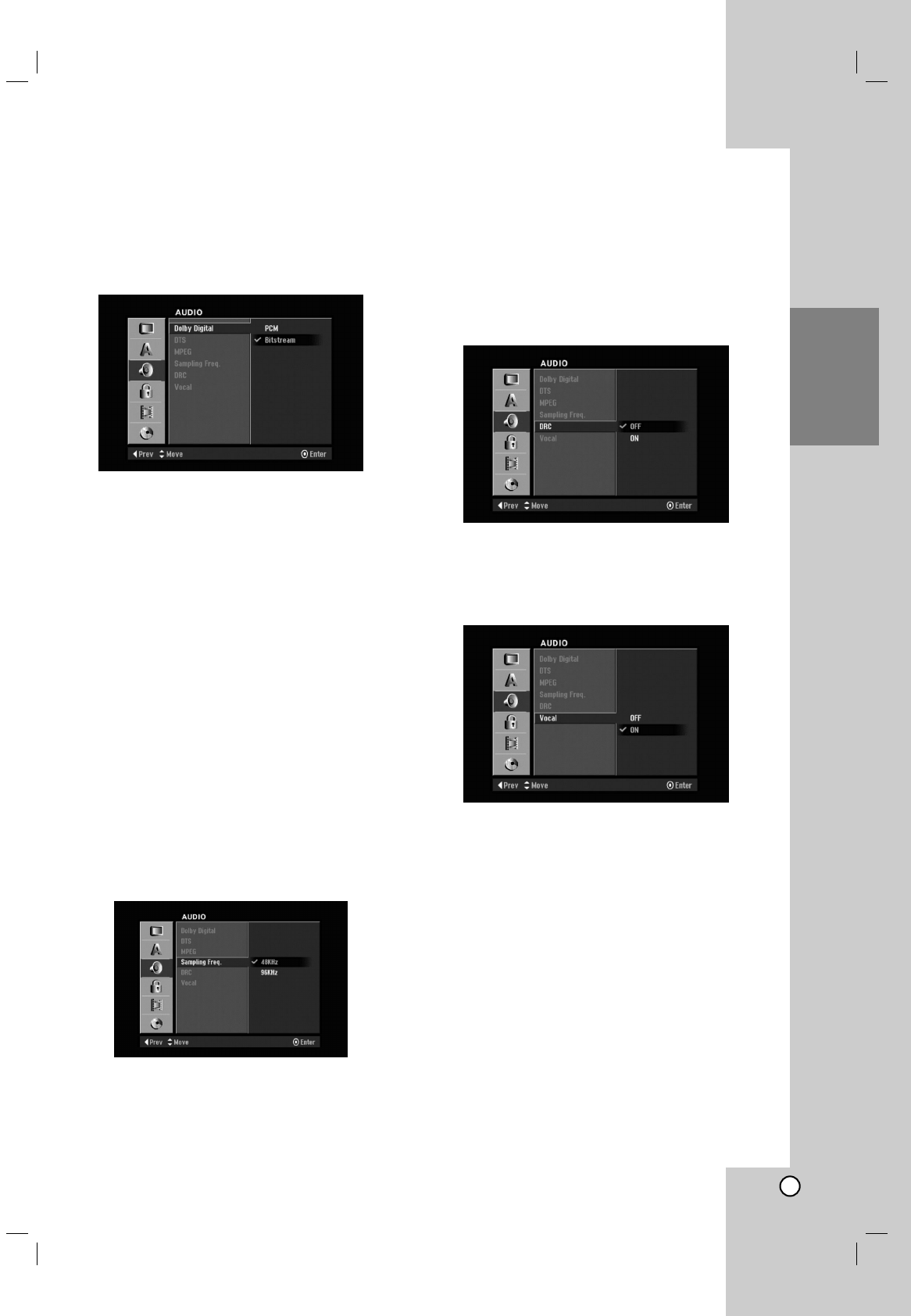
19
Hookup and
Settings
Audio Settings
Audio Settings
Each DVD disc has a variety of audio output options.
Set the recorder’s Audio Output according to the type
of audio system you use.
Dolby Digital / DTS / MPEG
[Bitstream]: Select “Bitstream” if you connect the
recorder’s DIGITAL AUDIO OUT jack to an amplifier
or other equipment with a Dolby Digital, DTS or
MPEG decoder.
[PCM] (for Dolby Digital / MPEG): Select when
connected to a two-channel digital stereo amplifier.
DVDs encoded in Dolby Digital or MPEG will be
automatically downmixed to two-channel PCM
audio.
[OFF] (for DTS): If you select [OFF], the DTS signal
is not output through the DIGITAL AUDIO OUT jack.
Sampling Frequency
If your receiver or amplifier is NOT capable of
handling 96 kHz signals, select [48 kHz]. When this
choice is made, this unit will automatically convert any
96 kHz signals to 48 kHz so your system can decode
them.
If your receiver or amplifier is capable of handling
96 kHz signals, select [96 kHz]. When this choice is
made, this unit will pass each type of signal through
without any further processing.
DRC (Dynamic Range Control)
With the DVD format, you can hear a program’s
soundtrack in the most accurate and realistic
presentation possible, thanks to digital audio
technology. However, you may wish to compress the
dynamic range of the audio output (the difference
between the loudest sounds and the quietest ones).
Then, you may listen to a movie at a lower volume
without losing clarity of sound. Set DRC to [ON] for
this effect.
Vocal
Set Vocal to [ON] only when a multi-channel karaoke
DVD is playing. The karaoke channels on the disc will
mix into normal stereo sound.
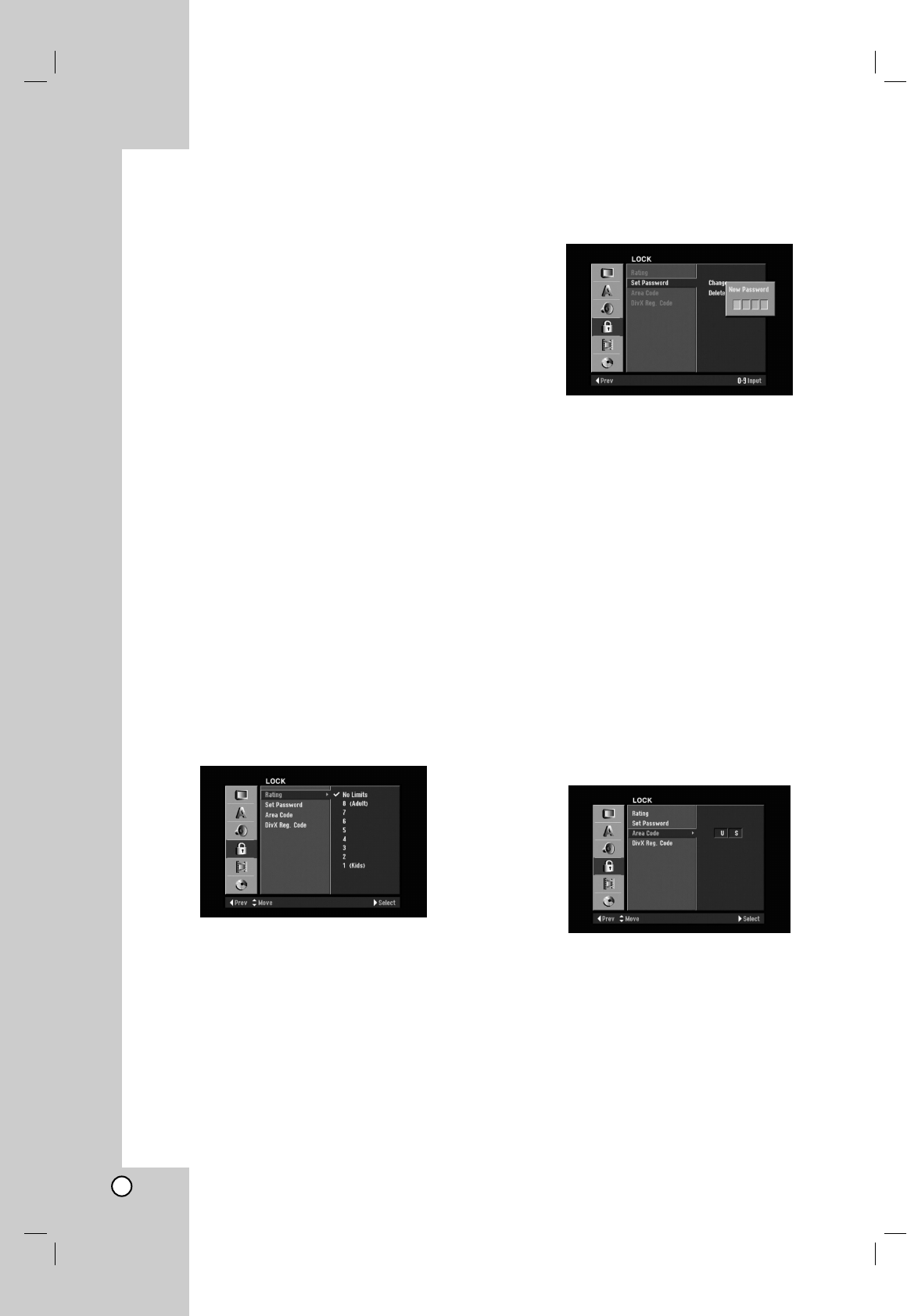
20
Lock (Parental Control)
Lock (Parental Control)
Settings
Settings
Rating
Some movies contain scenes that may not be suitable
for children to view. Many of these discs contain
parental control information that applies to the
complete disc or to certain scenes on the disc. Movies
and scenes are rated from 1 to 8, depending on the
area. DVD video discs may or may not respond to the
parental control setting if the Area code of the disc is
set wrongly. Some discs offer more suitable scenes as
an alternative. Ratings are area dependent. The
parental control feature allows you to block access to
scenes below the rating you input, thereby preventing
your children from being able to view material you
believe is unsuitable.
1. Select [Rating] option then press B.
2. To access the Rating, Password and Area Code
features, you must input the 4-digit security code
you created.
If you have not yet entered a security code you
are prompted to do so. Input a 4-digit code and
press ENTER. Enter it again and press ENTER to
verify. If you make a mistake before pressing
ENTER, press CLEAR.
3. Select a rating using the v/ Vbuttons.
[1] - [8]: Rating one (1) has the most restrictions
and rating eight (8) is the least restrictive.
[No Limit]: If you select [No Limit], parental control
is not active and the disc plays in full.
4. Press ENTER to confirm your rating selection,
then press SETUP to exit the menu.
Note:
If you set a rating for the recorder, all disc scenes with
the same rating or lower are played. Higher rated
scenes are not played unless an alternate scene is
available on the disc. The alternative must have the
same rating or a lower one. If no suitable alternative is
found, playback stops. You must enter the 4-digit
password or change the rating level in order to play
the disc.
Set Password
You can enter or change password.
1. Select [Set Password] option then press B.
2. Follow step 2 as shown [Rating].
To change the password, select the [Change],
press ENTER and input the new 4-digit code then
press ENTER. Input it again to verify.
3. Press SETUP to exit the menu.
If you forget your password
If you forget your password you can clear it using the
following steps:
1. Press SETUP to display the Setup menu.
2. Input the 5-digit number [210499]. The message
appears, select [Yes] then press ENTER. The
security code is cleared.
3. Enter a new code as described above.
Area Code
Enter the Area Code whose standards were used to
rate the DVD video disc, based on the list in the
reference chapter (see p. 51).
1. Select [Area Code] option then press B.
2. Follow step 2 as shown [Rating].
3. Select the first character using v/Vbuttons.
4. Shift the cursor using Bbuttons and select the
second character using v/ Vbuttons.
5. Press ENTER to confirm your area code
selection, then press SETUP to exit the menu.
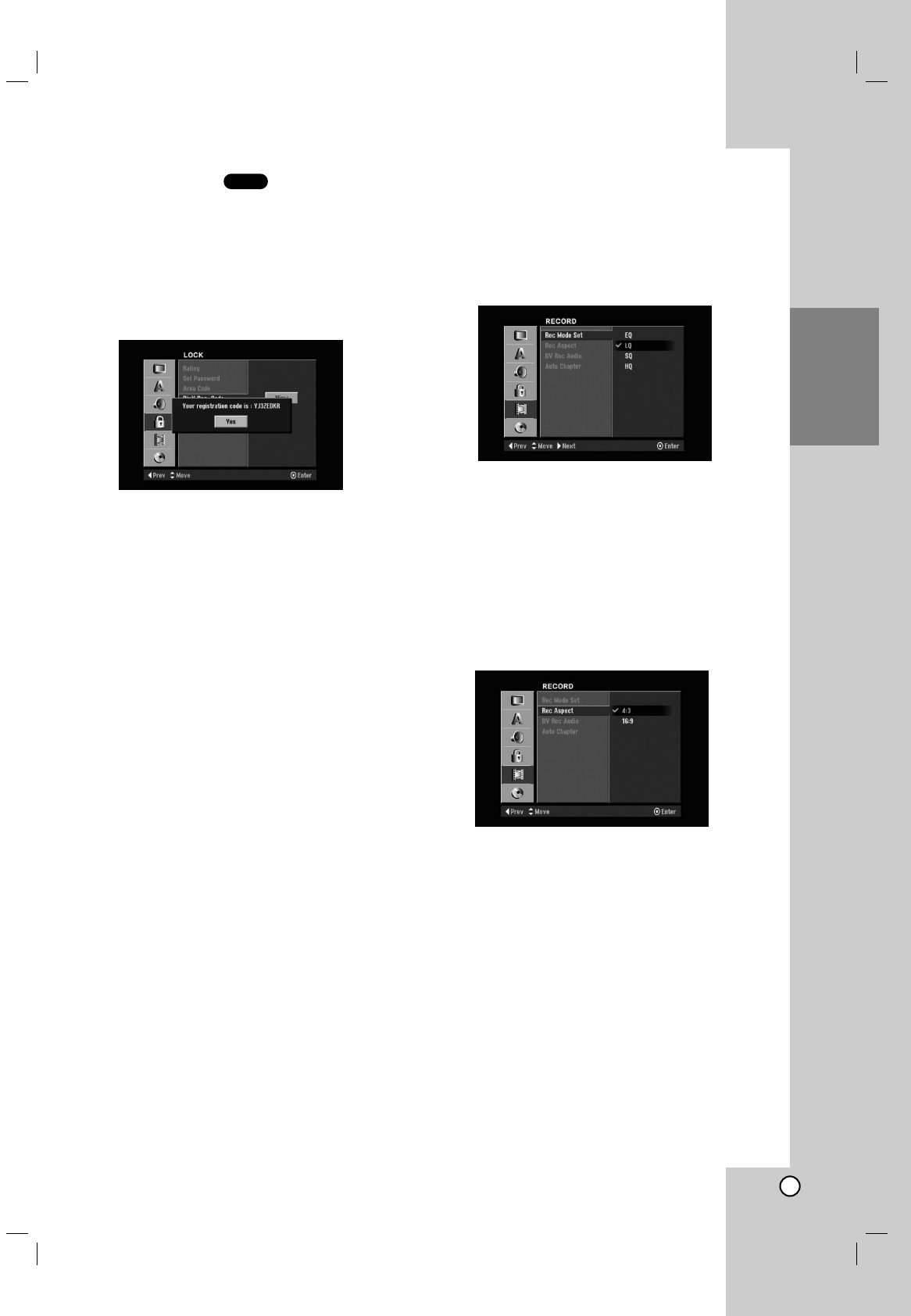
21
Hookup and
Settings
DivX Registration Code
We provide you the DivX®VOD (Video On Demand
registration code that allows you to rent and purchase
videos using the DivX®VOD servie. For more
information, visit www.divx.com/vod.
1. Select [About DivX(R)] option then press B.
2. Press ENTER while [Enter] is selected and the
registration code will appear.
3. Use the registration code to purchase or rent the
videos from Divx®VOD service at www.divx.com/vod.
Follow the instructions and download the video onto a
disc for playback on this unit.
Note:
All the downloaded videos from DivX®VOD can only
be played back on this unit.
Recording Settings
Recording Settings
Record Mode Set
You can set the picture quality for recording;
HQ (High Quality), SQ (Standard Quality),
LQ (Low Quality), EQ (Extend Quality).
1. Select [Rec Mode Set] option then press B.
2. Use v/ Vto select a desired Record Mode (HQ,
SQ, LQ or EQ).
3. Press ENTER to confirm your selection, then
press SETUP to exit the menu.
Record Aspect
When DVD recording, you can set the recording
aspect ratio to suit the material you’re recording (16:9
or 4:3).
DivX
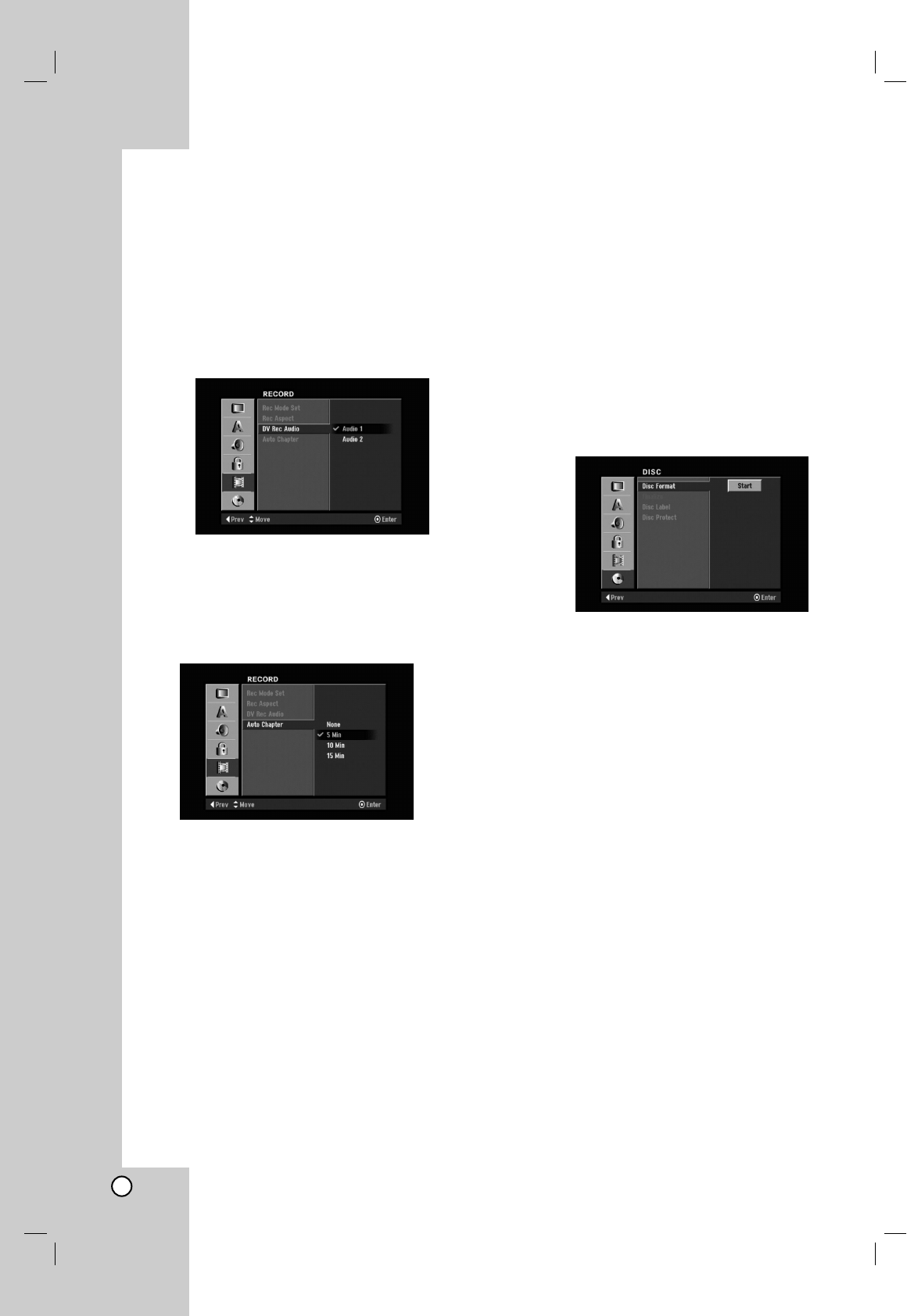
22
DV Recording Audio
You need to set this if you have a camcorder using
32kHz/12-bit sound connected to the front panel DV
IN jack.
Some digital camcorders have two stereo tracks for
audio. One is recorded at the time of shooting; the
other is for overdubbing after shooting.
On the Audio 1 setting, the sound that was recorded
while shooting is used.
On the Audio 2 setting, the overdubbed sound is
used.
Auto Chapter
During recording, chapter markers are added
automatically at fixed intervals. You can set this
interval to 5 minutes, 10 minutes or 15 minutes. To
turn off automatic chapter marking, select “None”.
Disc Settings
Disc Format
If you load a completely blank disc, the recorder will
initialize the disc.
•DVD-R: The recorder initialize the disc to Video mode.
The recording mode will always be Video mode.
•DVD-RW: The Initialize menu will appear. Select [VR
Mode] or [Video Mode] then press ENTER.
•DVD+R(DL): The Initialize menu will appears. Select
[Yes] then press ENTER.
•DVD+RW: The recorder initialize the disc to DVD+RW
mode.
Also, you can reformat the DVD-RW/DVD+RW from
the Setup menu as below.
1Select the [Disc Format] option then press B.
[Start] icon is highlighted.
2Press ENTER.
•In case of DVD-RW, use b / B to select a desired
Disc Initialize Mode (VR Mode or Video Mode)
then press ENTER.
•In case of DVD+RW, use b / B to select [OK],
and press ENTER.
It takes a few moments to format the disc.
Caution
If you want to change the disc format, everything
recorded on the disc will be erased.
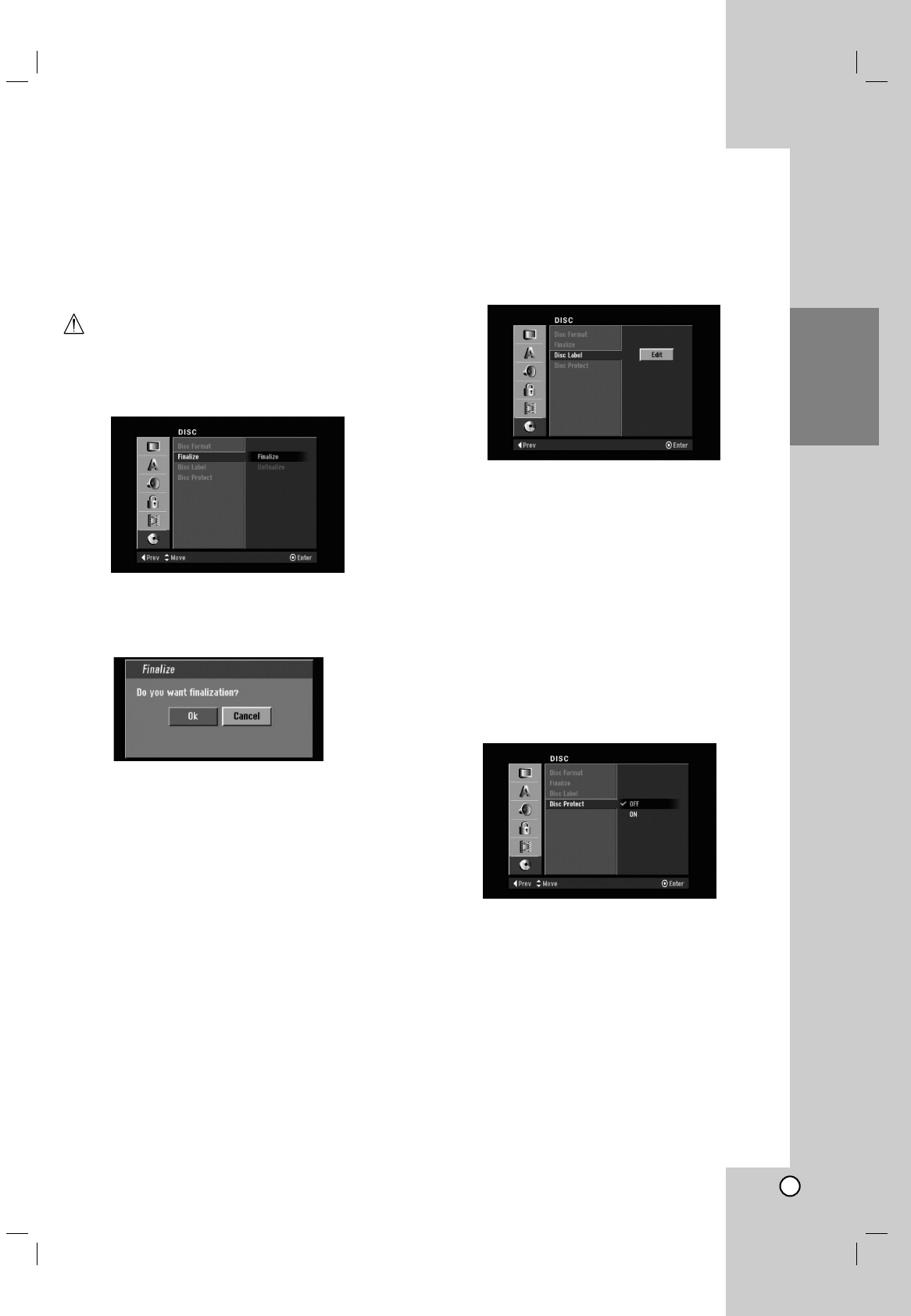
23
Hookup and
Settings
Finalize
Finalizing ‘fixes’ the recordings in place so that the
disc can be played on a regular DVD player or
computer equipped with a suitable DVD-ROM drive.
Finalizing a Video mode disc creates a menu screen
for navigating the disc. This is accessed by pressing
MENU/LIST or TITLE.
Caution
Once you have finalized a DVD-R and DVD+R disc,
you cannot edit or record anything else on that disc
except DVD+RW. However, you can record and edit a
DVD-RW disc by choosing [Unfinalize] option.
1. Select [Finalize] option then press B.
2. Press ENTER while [Finalize] is selected.
Finalize menu appears.
3. Select [Ok] then press ENTER.
The recorder starts finalizing the disc.
Notes:
•Finalization can take up to 3-4 minutes or more
depending on the type of disc, how much is recorded on
the disc, and the number of titles on the disc.
•DVD+R DL disc can take up to 30 minutes to finalize.
Tips
•If you load a DVD-RW that has already been finalized,
you can ‘Unfinalize’ it by choosing Unfinalize from the
Finalize menu. After doing this, you can edit and re-
record onto the disc.
•You cannot unfinalize a DVD-R and DVD+R disc.
•If [Disc Protect] option is set to [ON], the finalize is not
available. To finalize, set [Disc Protect] option to [OFF].
Disc Label
Use this to enter a name for the disc. This name
appears when you load the disc and when you display
disc information on-screen.
The disc label can be up to 32 characters long.
For discs formatted on a different recorder, you will
see only a limited character set.
1Select the [Disc Label] option then press B.
[Edit] icon is highlighted.
2Press ENTER.
Keyboard menu appears.
To enter characters, see page 51.
Disc Protect
When recording in DVD+RW / +R disc or VR mode
formatted DVD-RW disc, set to [ON] to prevent
accidental recording, editing or deleting of the disc
loaded. If you need to unlock the disc to make edits,
select [OFF].
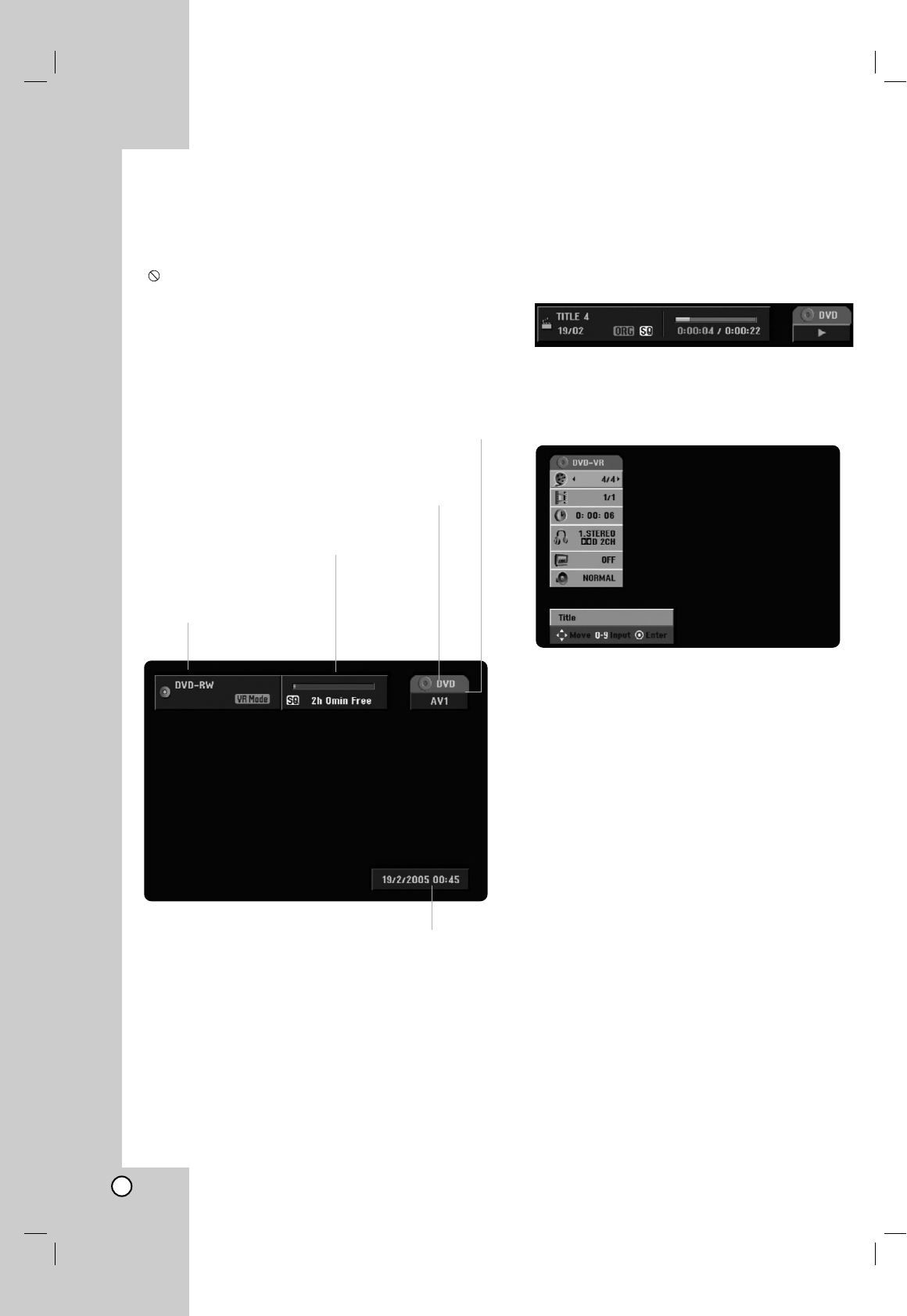
24
General Explanation of
General Explanation of
On-Screen Display
On-Screen Display
Some DVDs require specific operation or allow only
limited operation during playback. When this occurs,
is displayed, action prohibited or not available.
Displaying Information While Watching TV
During viewing the TV, press ENTER or DISPLAY
to display/remove the information displayed
on-screen.
e.g., when DVD-RW in VR mode is inserted.
Displaying Disc Information on-screen
You can display various information about the disc or
tape loaded on-screen. Some items can be changed
using the menu.
1. Press DISPLAY once to show current status.
Example: DVD-RW in VR mode
2. Press DISPLAY once again to show various
playback information.
The items displayed differ depending on the disc
type or playing status.
3. You can select an item by pressing v/ Vand
change or select the setting by pressing b/ B.
For details about each item, see the pages in
parentheses.
[Title]: Current title (or track) number/total
number of titles (or tracks) (page 25)
[Chapter]: Current chapter number/total number
of chapters (page 25)
[Time]: Elapsed playing time (page 26)
[Audio]: Selected audio language (DVD VIDEO
only) or audio channel (page 27)
[Subtitle]: Selected subtitle (page 28)
[Angle]: Selected angle/total number of angles
(page 27)
[Sound]: Selected sound mode (page 27)
Note:
If no button is pressed for 10 seconds, the on-screen
display disappears.
Indicates disc name
and format.
Indicates channel number, station name, and audio
signal (STEREO, MONO) received by the tuner.
Indicates the record mode,
free space, and elapsed
time progress bar.
Indicates operational mode of the recorder.
(HDD, DVD, VCD, etc.)
Indicates current date and time.
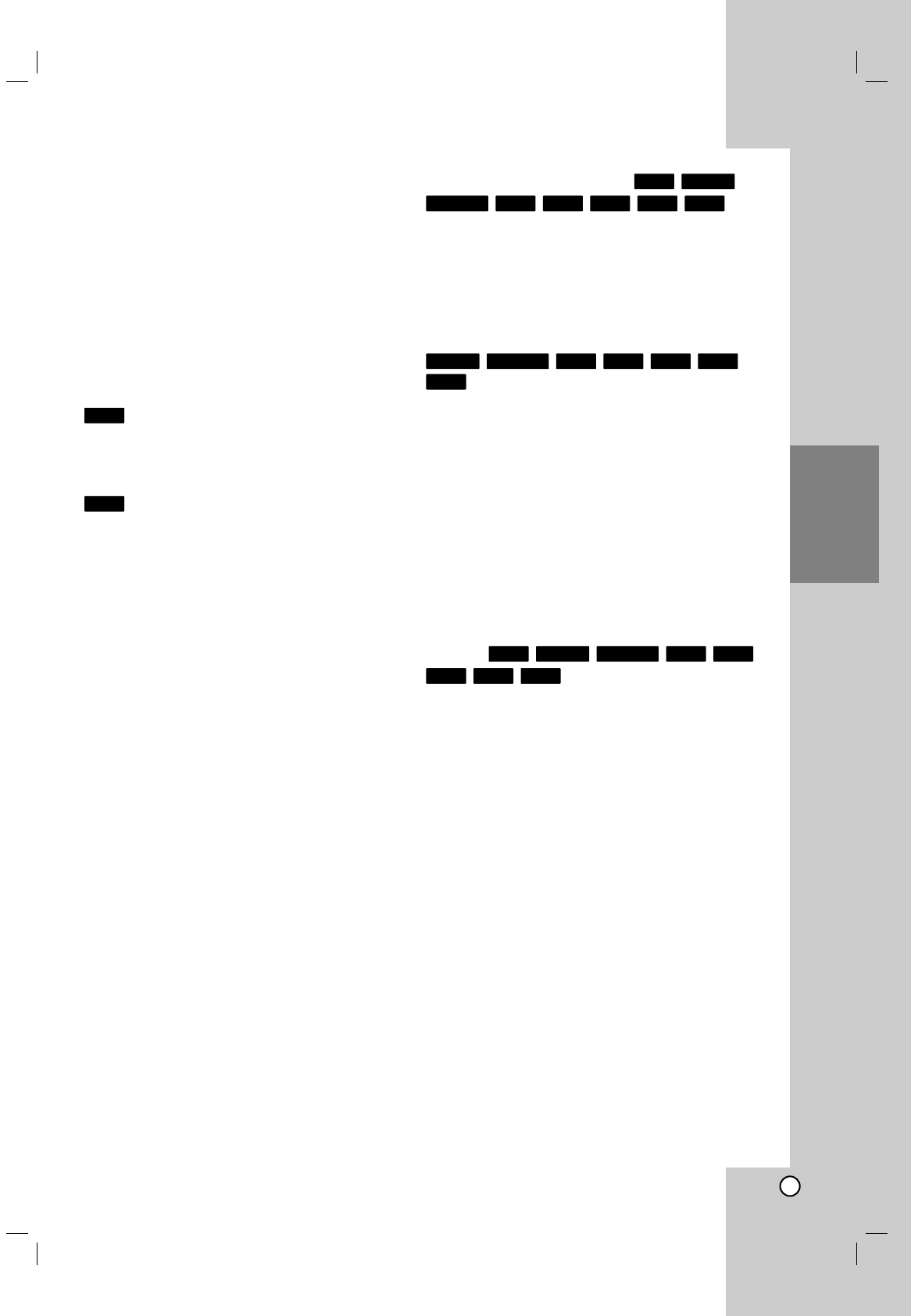
25
Playback
Playback
Playing a HDD, DVD, DivX file
Playing a HDD, DVD, DivX file
or V
or Video CD
ideo CD
Playback Setup
1. Load your chosen disc in the tray, with the
playback side down.
2. Starts playback using HOME menu (see page 17).
In some cases, the disc menu might appear
instead.
Use the bB v Vbuttons to select the title/chapter
you want to view, then press ENTER to start.
Press TITLE or LIST/DISC MENU to return to the
menu screen.
Use the number buttons to select the track you
want to view and press RETURN to return to the
menu screen. Menu settings and operating
procedures may differ. Follow the instructions on
each menu screen. You may also set PBC to [Off]
(See page 27).
3. To stop the playback, press STOP x.
The unit records the stopped point, depending on
the disc. “Xx” appears on the screen briefly.
Press N(PLAY) to resume playback (from the
scene point). If you press STOP (x)again or
unload the disc (“x” appears on the screen.), the
unit will clear the stopped point.
Press OPEN/CLOSE (Z) to remove the disc.
Press OPEN/CLOSE (Z) to close disc tray or
press POWER (1), the disc tray closes
automatically and unit turns off.
Notes:
•If parental control is set and the disc is not within the
rating settings you must input the password.
(See [Rating] on page 19).
•DVDs may have a region code. Your Recorder will not
play discs that have a region code different from your
Recorder. The region code for this player is 1 (one).
•Unless stated otherwise, all operations described use the
Remote Control. Some features may also be available on
the Setup menu.
Moving to another TITLE
When a disc has more than one title, you can move to
another title as follows:
•Press DISPLAY twice then use v/ Vto select the
title icon. Then, press the appropriate numbered
button (0-9) or b/ Bto select a title number.
Moving to another CHAPTER/TRACK
When a title on a disc has more than one chapter or a
disc has more than one track, you can move to
another chapter/track as follows:
•Press SKIP (>or .)briefly during playback
to select the next chapter/track or to return to the
beginning of the current chapter/track.
•Press SKIP . twice in quick successions to
step back to the previous chapter/track.
•To go directly to any chapter/track during
playback, press DISPLAY twice and use v/Vto
select the chapter or track (for Video CD) icon.
Input the chapter/track number or use b/B.
Search
1. Press SCAN (mor M)during playback.
2. Press SCAN (mor M)repeatedly to select the
required speed. (forward and backward) ;
HDD, DVD ; 5 steps
Video CD; 3 steps
3. To exit SEARCH mode, press PLAY.
Still Picture and Frame-by-Frame
Playback
1. Press PAUSE/STEP (X) during playback. Advance
the picture frame-by-frame by pressing
PAUSE/STEP (X) repeatedly.
2. To exit still motion mode, press PLAY.
Tips:
•You can advance or back up the picture frame-by-
frame by pressing b/ Brepeatedly during PAUSE
mode.
•The picture frame-by-frame in reverse is not
available for Video CD.
VCDDVD+R
-R+RW-RWVideo
-RWVR
HDD
VCD
DVD+R-R+RW-RWVideo
-RWVR
DivXDVD+R-R+RW-RWVideo
-RWVR
HDD
VCD
DVD
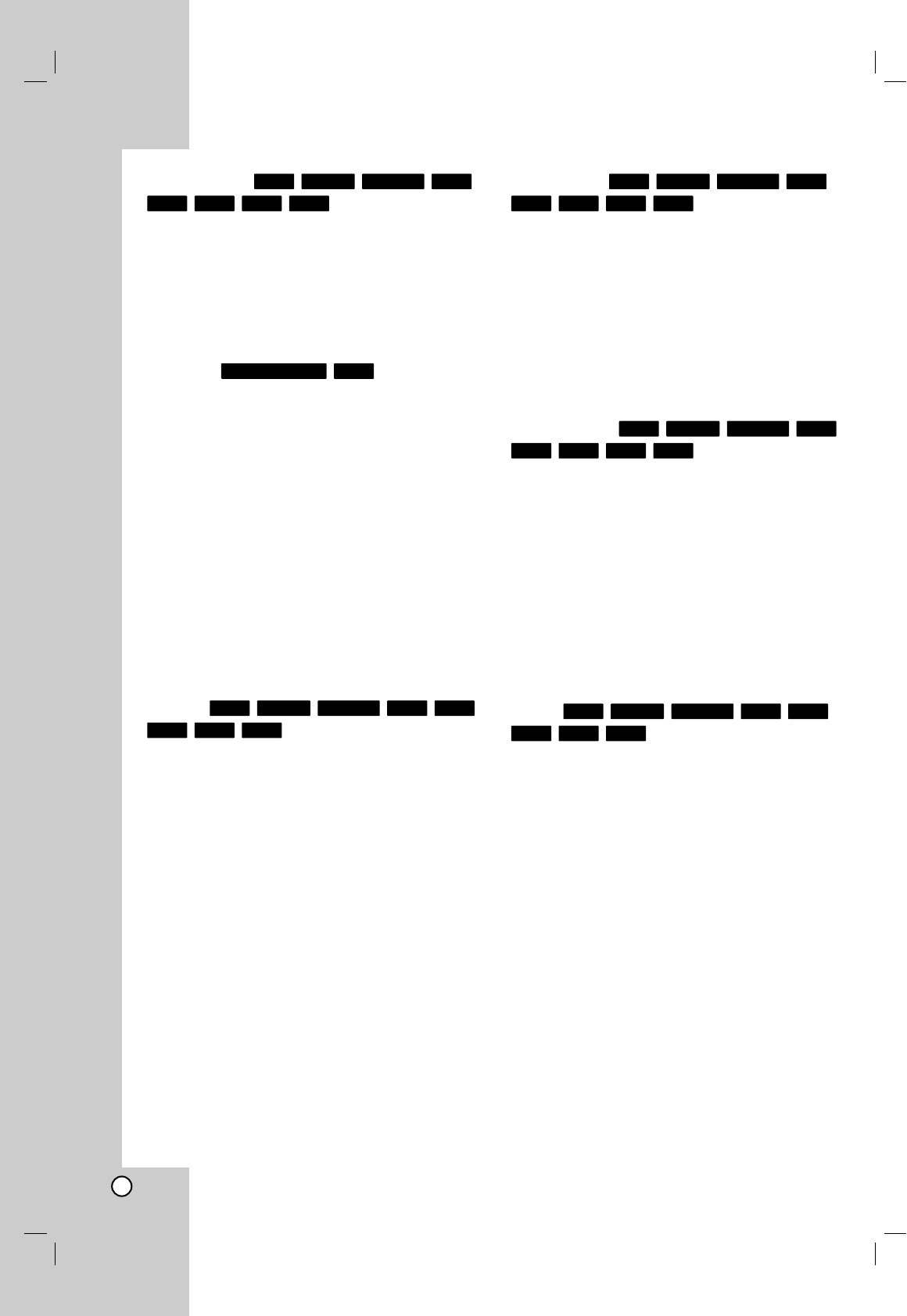
26
Slow Motion
1. Press SCAN (mor M) during pause mode.
2. Use the SCAN (mor M) to select the required
speed.
DVD, HDD; 4 steps (forward and backward)
Video CD; 3 steps (forward only)
3. To exit Slow Motion mode, press PLAY (N).
Random
1. Press RANDOM during playback.
The unit automatically begins Random Playback
and “RANDOM” appears on the TV screen.
2Press RANDOM again to normal.
Tip:
By pressing SKIP >during Random playback, the
unit selects another title (track) and resumes Random
playback.
Notes:
•This function only works with DVD Karaoke discs
or video CDs without PBC.
•On a Video CD with PBC, you must set PBC to
OFF in the Setup menu to use the this function.
See page 20.
Repeat
Press REPEAT to select a desired repeat mode.
[Chapter] repeats the current chapter. (DVD only)
[Title] repeats the current title. (DVD, HDD only)
[All] repeats the all titles/tracks (VR mode DVD-RW,
or Video CD).
[Track]: repeats the current track. (Video CD only)
[OFF] does not play repeatedly.
Note:
On a Video CD with PBC, you must set PBC to [OFF]
in the Setup menu to use the this function. See page
20.
Repeat A-B
To repeat a sequence.
1. Press A-B at your chosen starting point. [A - ]
appears briefly on the TV screen.
2. Press A-B again at your chosen end point.
[A - B] appears briefly on the TV screen and the
repeat sequence begins.
3. Press A-B again to cancel.
Note:
During HDD playback, you cannot select a sequence
less than 5 seconds.
Time Search
To start playing at any chosen time on the disc:
1. Press DISPLAY twice during playback. The time
search box shows the elapsed playing time.
2. Press v/Vto select the time clock icon
and [0:00:00] appears.
3. Input the required start time in hours, minutes, and
seconds from left to right.
If you enter the wrong numbers, press b
/
Bto
move the under bar (_) to the wrong number. Then
enter the correct numbers.
4. Press ENTER to confirm. Playback starts from the
selected time.
Zoom
Use zoom to enlarge the video image.
1. Press ZOOM during playback or still playback to
activate the Zoom function.
2. Each press of the ZOOM button changes the TV
screen in the sequence shown below.
x1 size →x2 size →x4 size →x1 size (normal size)
3. Use the b/ B/ v/ Vbuttons to move through the
zoomed picture.
4. To resume normal playback, press ZOOM
repeatedly or CLEAR button.
Note:
The zoom function may not work on some DVDs.
VCDDVD+R
-R+RW-RWVideo
-RWVR
HDD
DivXDVD+R-R
+RW-RWVideo
-RWVR
HDD
VCDDVD+R-R
+RW-RWVideo
-RWVR
HDD
VCDDVD+R
-R+RW-RWVideo
-RWVR
HDD
VCDKaraoke DVD
VCDDVD+R-R
+RW-RWVideo
-RWVR
HDD
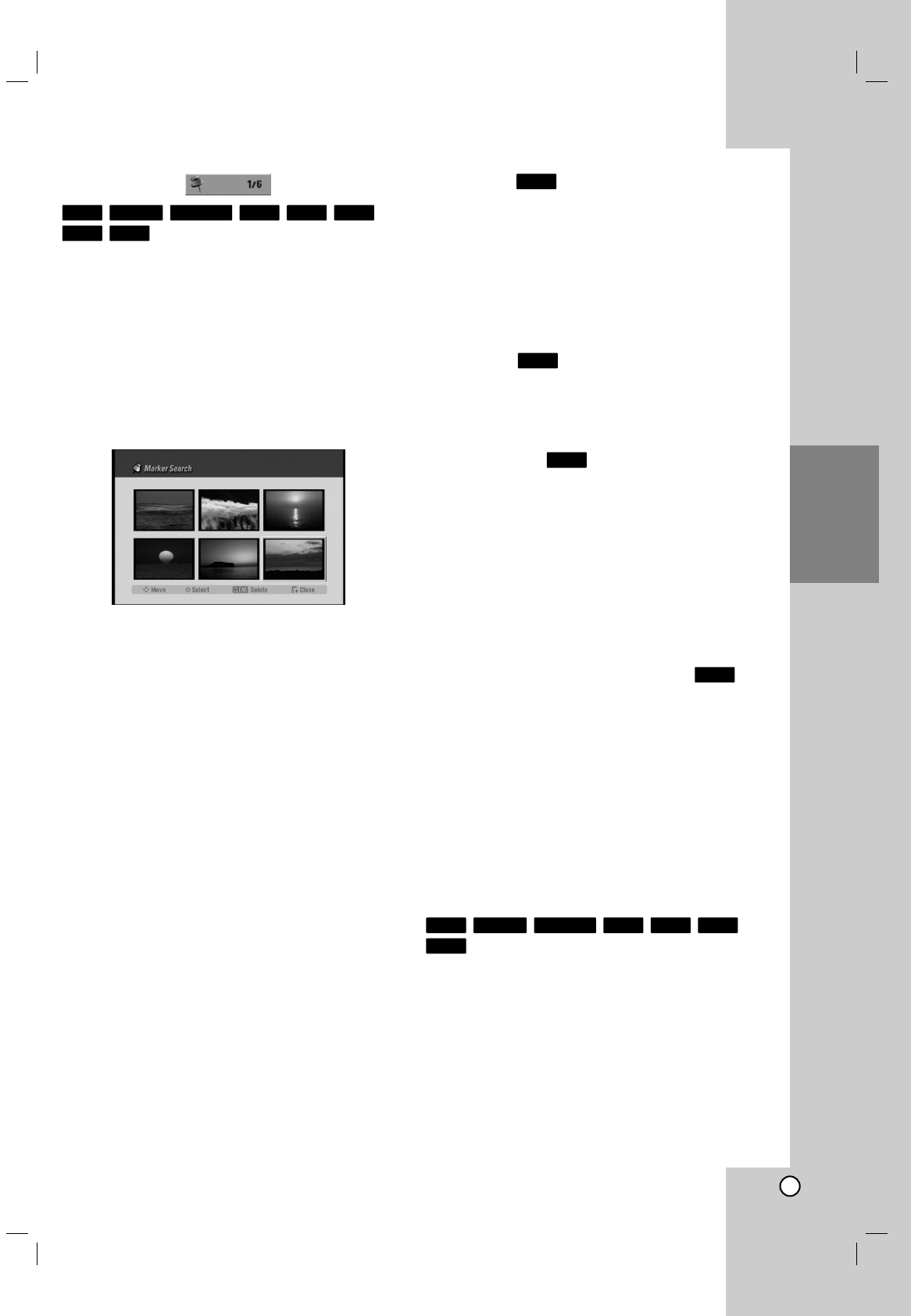
27
Playback
Marker Search
To enter a Marker
You can start playback from up to six memorized
points. To enter a marker, press MARKER at the
desired point on the disc. The Marker icon appears on
the TV screen briefly. Repeat to enter up to six
markers.
To Recall or Clear a Marked Scene
1. During disc playback, press SEARCH. The marker
search menu appears on the screen.
2. Use b/ B/ v/ Vto select a marked scene that
you want to recall or clear.
3. Press ENTER and playback starts from the
marked scene. Or, Press CLEAR and use b/ Bto
select [Yes] then press ENTER to delete marked
scene from the list.
4. To remove the Marker Search menu,
press RETURN (O)
Checking the Contents of DVD
Video Discs: Menus
DVDs may contain menus that allow you to access
special features. To open the disc menu, press
MENU/LIST. Then, press the appropriate number
button to select an option. Or, use the b/ B/ v/ V
buttons to highlight your selection, then press ENTER.
Title Menu
1. Press TITLE.
If the current title has a menu, the menu will
appear on the TV screen. Otherwise, the disc
menu may not appear.
2. The menu offers features such as camera angles,
spoken language and subtitle options, and
chapters for the title.
Disc Menu
1. Press MENU/LIST and the disc menu is displayed.
2. Press MENU/LIST again to exit.
Camera Angle
If the disc contains scenes recorded at different
camera angles, you can change to a different camera
angle during playback. Press ANGLE then press b/
Brepeatedly during playback to select a desired
angle. Note that the number of the current angle
appears on the display.
Tip:
The Camera Angle icon is displayed on the TV screen when
alternate angles are available.
Changing the Audio Soundtrack
Press AUDIO then press b/ Brepeatedly during
playback to hear a different audio language or audio
soundtrack if available.
Note:
Some discs feature both Dolby Digital and DTS
soundtracks. There is no analog audio output when
DTS is selected. To listen to the DTS soundtrack,
connect this recorder to a DTS decoder via one of the
digital outputs. See page 13 for connection details.
Changing the Audio Channel
Press AUDIO then press b/ Brepeatedly during
playback to hear a different audio channel;
With DVD-RW discs recorded in VR mode and HDD
that have both a main and a Bilingual audio channel,
you can switch among Main (L), Sub (R), or Main+sub
(L+R) by pressing AUDIO.
VCD
+R-R+RW-RWVideo
-RWVR
HDD
DVD
DVD
DVD
DVD
VCDDVD
+R-R+RW-RWVideo
-RWVR
HDD
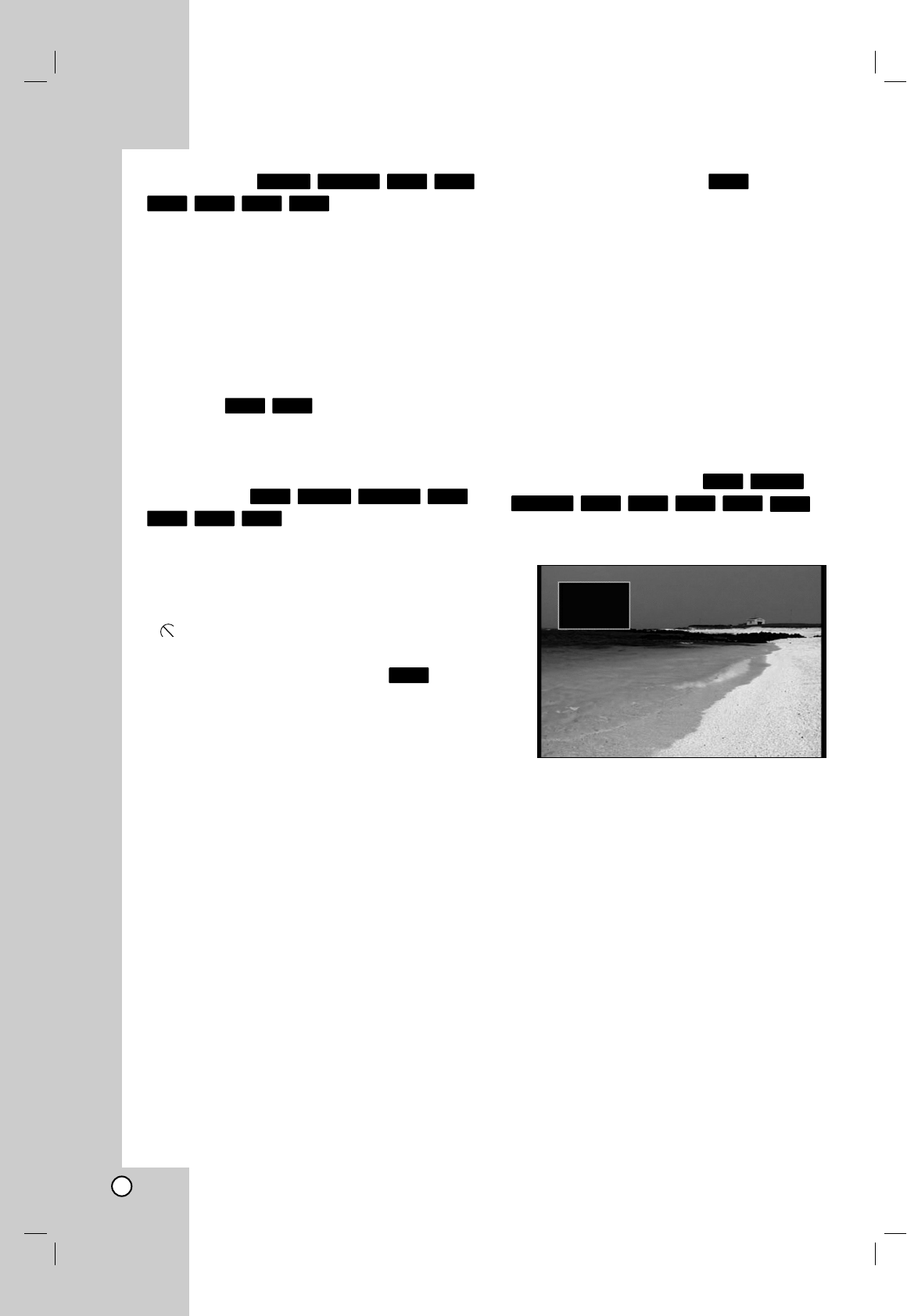
28
3D Surround
This unit can produce a 3D Surround effect, which
simulates multi-channel audio playback from two
conventional stereo speakers, instead of the five or
more speakers normally required to listen to multi-
channel audio from a home theater system.
1. Press 3D SURR. then press b/ Brepeatedly
during playback to select [3D SUR.].
2. To turn off the 3D Surround effect, select
[NORMAL].
Subtitles
Press SUBTITLE then press b/ Brepeatedly during
playback to see the different subtitle languages.
Instant Skip
Each press I.SKIP skips forward 15 seconds.
In HDD playback or Timeshift mode, each press b/ B
skips forward or reverse 5 minutes.
Note:
If appears, the feature is not available on the disc.
Finding Locations on a Disc
You can directly access any point on a Video CD
using this function within 95% of progress bar. Use
this function only while a Video CD is playing.
Playback jumps to the point specified.
1. Press SEARCH during playback.
The progress bar appears on the TV screen.
2. Use b / B to find the desired starting position for
playback.
3. Press ENTER to confirm the selected position.
Playback starts from the selected position.
Note:
This function will not work if any bookmarks have
been set; see page 27.
Last Condition Memory
This Recorder memorizes last scene from the last disc
that is viewed. The last scene remains in memory
even if you remove the disc from the Recorder or
switch off the Recorder. If you load a disc that has the
scene memorized, the scene is automatically recalled.
Notes:
•Settings are stored in memory for use any time.
•This Recorder does not memorize settings of a disc if
you switch off the Recorder before commencing to play
it.
•The Last Condition Memory function may not work on
some DVDs.
•Last Condition Memory function for a previous DVD title
is erased once a different DVD title is played.
PIP (Picture in Picture)
This function enables you to view the stored stations
in sub picture during playback.
On and off
Press PIP to switch on the sub picture, press this
button again to switch it off.
Input mode selection for sub picture
Press INPUT to select the input mode for the sub
picture. Each time this button is pressed, each input
mode for the sub picture is displayed as shown
below.
Tuner
→
AV1
→
AV2
Program selection for sub picture
Use v/ Vto change the program when sub
picture’s input is set to tuner. The selected program
number is displayed on the TV screen. You can
view the selected program by pressing STOP (x).
Sub picture position change
Press b/ Brepeatedly until desired position is
achieved. The sub picture moves clockwise or
counterclockwise.
Zoom Sub picture
VCD
DVD+R-R+RW-RWVideo
-RWVR
HDD
DVD
VCD
DVD+R-R
+RW-RWVideo
-RWVR
HDD
DivXDVD
DivXVCDDVD+R
-R+RW-RWVideo
-RWVR
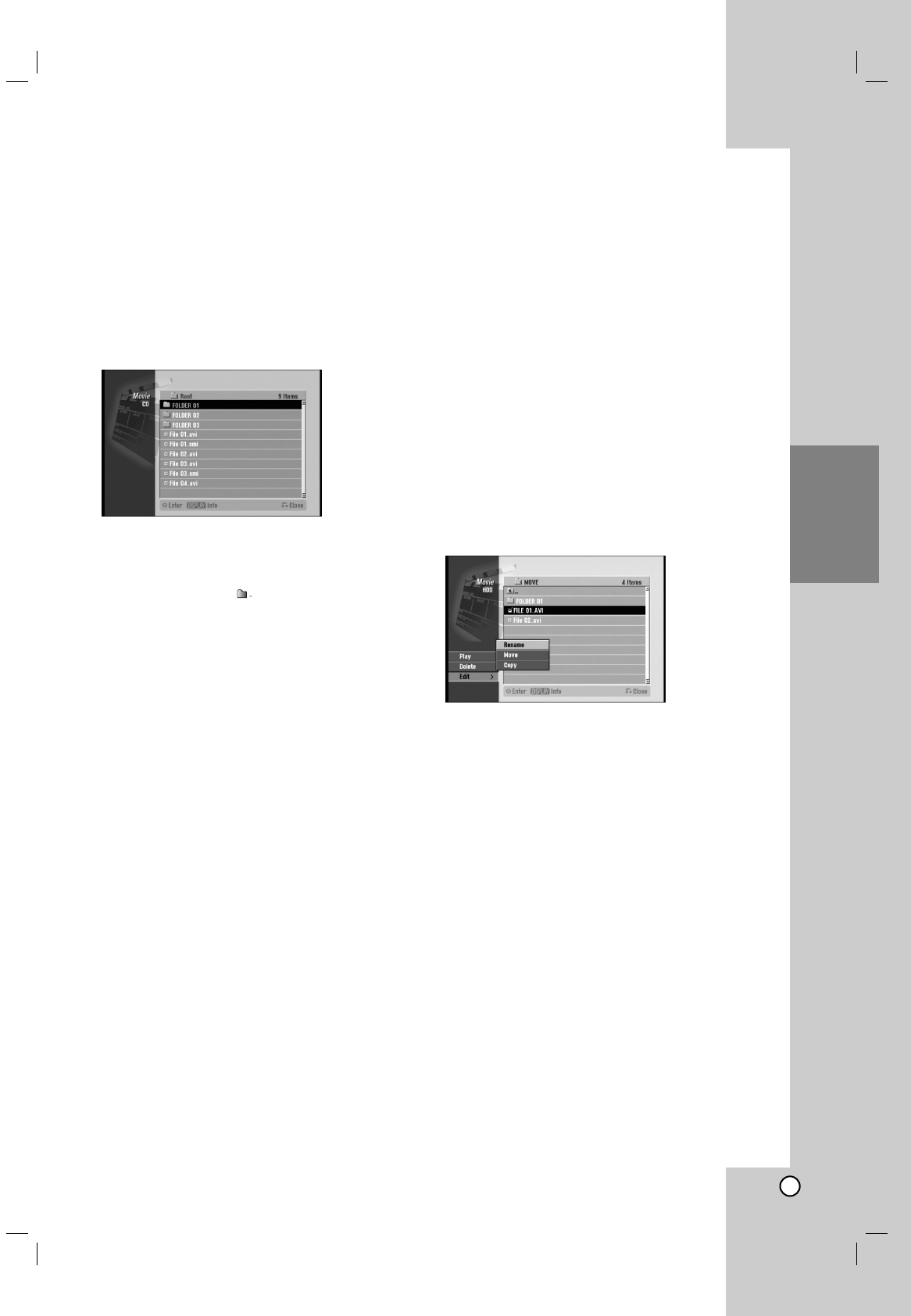
29
Playback
Playing a DivX Movie File
Playing a DivX Movie File
The recorder can play Divx files on HDD, CD-R/RW or
DVD±R/RW discs. Before playing DivX files, read
“About DivX movie files” on page 32.
1. Press HOME.
2. Select a media that contains DivX file(s) then
press ENTER.
3. Select [MOVIE] option then press ENTER.
The Movie menu appears on the TV screen.
4. Use v/Vto select a folder, and press ENTER
twice. A list of files in the folder appears. If you are
in a file list and want to return to the Folder list,
use the v/Vto highlight and press ENTER to
return to the previous menu screen.
5. Use v/Vto select a file then press N(PLAY).
Playback starts.
You can use variable playback functions. Refer to
pages 25-28.
6. Press STOP to stop the playback. The Movie
menu appears.
Note:
This recorder cannot play back the DivX file(s) in the Memory
Card.
Notice for displaying the DivX subtitle
Please refer to following notice when the DivX
subtitle does not display properly.
1. Press SETUP.
The Setup menu appears.
2. Use v/V/b/B to select [LANGUAGE] b[Disc
Subtitle] then find a suitable language for the DivX
subtitle.
Refer to “Disc Menu/Audio/Subtitle” on page 19.
Tip:
If the subtitle still does not display properly after the
steps 1-2 proceeded, press and hold SUBTITLE about
3 seconds then use b/Bto select another language
code during playback until the subtitle is displayed
properly.
Movie menu options
1. Press v/Vto select a folder/file on the Movie
menu then press ENTER.
Movie menu options appear.
2. Press v/V/b/Bto select an option, and press
ENTER.
[Play] Start playback the selected title.
[Open] Opens the folder and a list of files in the
folder appears
[Delete] Deletes the file(s) or folder(s) from the
media. (HDD only)
[Rename] Edits the file name. (HDD only)
(page 36)
[Move] Moves the file(s) to another folder or
media. (HDD only) (page 37)
[Copy] Copies the file(s) to another folder or
media. (page 37)

30
About DivX movie files
DivX disc compatibility with this recorder is
limited as follows:
Available resolution size of the DivX file is under
720x576 (W x H) pixel.
This recorder cannot play back the DivX file(s) in
the Memory Card.
The file name of the DivX subtitle is limited to
characters.
The total number of files and folders on the disc
should be less than 1999.
If the number of the screen frame is over 29.97
frames per second, this unit may not operate
normally.
If the video and audio structure of recorded file
is not interleaved, returns to the menu screen.
If the file is recorded with GMC, the unit
supports only 1-point of the record level.
* GMC?
GMC is the acronym for Global Motion
Compensation. It is an encoding tool specified in
MPEG4 standard. Some MPEG4 encoders, like
DivX or Xvid, have this option.
There are different levels of GMC encoding, usually
called 1-point, 2-point, or 3-point GMC.
Playable DivX file
“.avi”, “.divx”
Playable DivX subtitle
“.smi”, “.srt”,
“.sub (Micro DVD format only)”,
“.txt (Micro DVD format only)”
Divx subtitle except those listed above is not
displayed on the TV screen.
Playable Codec format
“DIV3”, “MP43”, “DIVX”, “XVID”, “DX50”
Playable Audio format
“AC3”, “PCM”, “MP2”, “MP3”, “WMA”
Sampling frequency: within 8 - 48 kHz (MP3), within
32 - 48kHz (WMA)
Bit rate: within 8 - 320kbps (MP3),
32 - 192kbps (WMA)
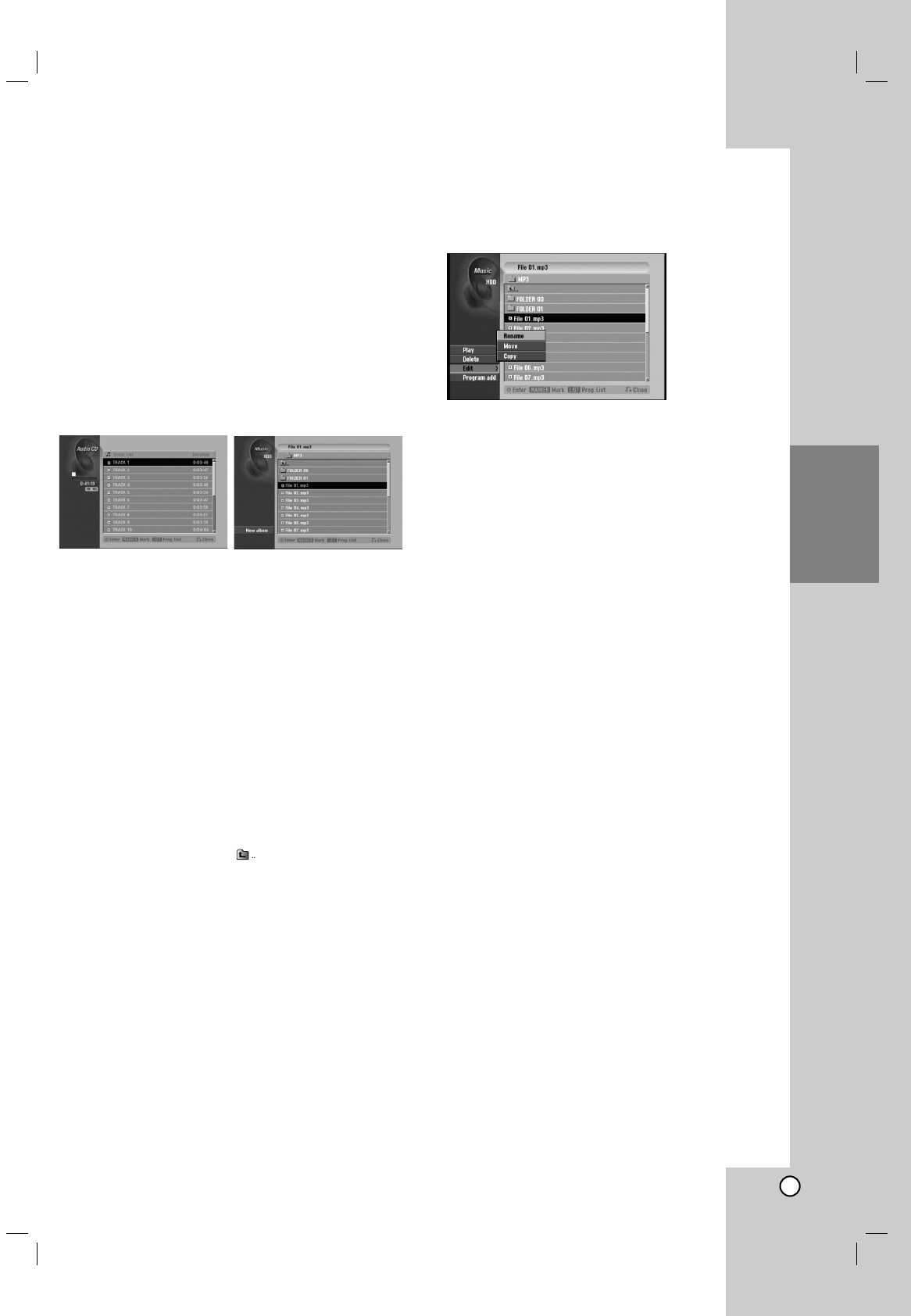
31
Playback
Playing an
Playing an Audio CD or
Audio CD or
MP3/WMA
MP3/WMA file
file
The recorder can play audio CDs and MP3/WMA files
on HDD, Memory Card, CD-ROM, CD-R/RW or
DVD±R/RW discs. Before playing MP3/WMA files,
read “About MP3/WMA audio files” on page 32.
1. Press HOME.
The HOME menu appears.
2. Select a media that contains MP3/WMA or audio
title then press ENTER.
3. Select [MUSIC] option then press ENTER.
The Audio CD or Music menu appears on the TV
screen.
Audio CD Menu Music Menu
4. Use v/Vto select a track then press N(PLAY).
Playback starts.
During playback, the current track’s elapsed
playing time will appear on the front panel display
and menu. Playback will stop at the end of the
disc.
Tips:
•Press DISPLAY to view ID3-Tag information for
the MP3 file. If ID3-Tag information is not
present, “Not Checked” will appear. If you select
a folder, the number of subfolders and number
of MP3/WMA files in the folder are displayed.
Press DISPLAY again to remove the
information screen.
•If you want to move to the upper directory, use
the v/ Vto highlight and press ENTER.
•You can also display HOME menu to select
another media by pressing RETURN (O).
5. To stop playback at any time, press STOP.
Tip:
You can create new folder. Select [New Album] option
on the Music-HDD or Music-Memory Card menu then
press ENTER. “NONAME##” folder is created.
Audio CD and Music menu options
1. Press v/Vto select a folder/file on the Audio CD
or Music menu then press ENTER.
The menu options appear.
2. Press v/V/b/Bto select an option, and press
ENTER.
[Play] Start playback the selected title.
[Open] Opens the folder and a list of files in the
folder appears
[Delete] Deletes the file(s) from the media.
[Rename] Edits the file name. (page 36)
[Move] Moves the file(s) to another folder or
media. (page 37)
[Copy] Copies the file(s) to another folder or
media. (page 37)
[Program Add] Adds the track(s) to Program List.
(page 33)
Pause
1. Press PAUSE/STEP (X) during playback.
2. To return to playback, press N(PLAY) or press
PAUSE/STEP (X) again.
Moving to Another Track
Press SKIP >or .briefly during
playback to go to the next track or to return to the
beginning of the current track.
Press SKIP .twice briefly to step back to the
previous track.
On an Audio CD, to go directly to any track, enter
the track number using the numbered buttons (0-9)
during playback.
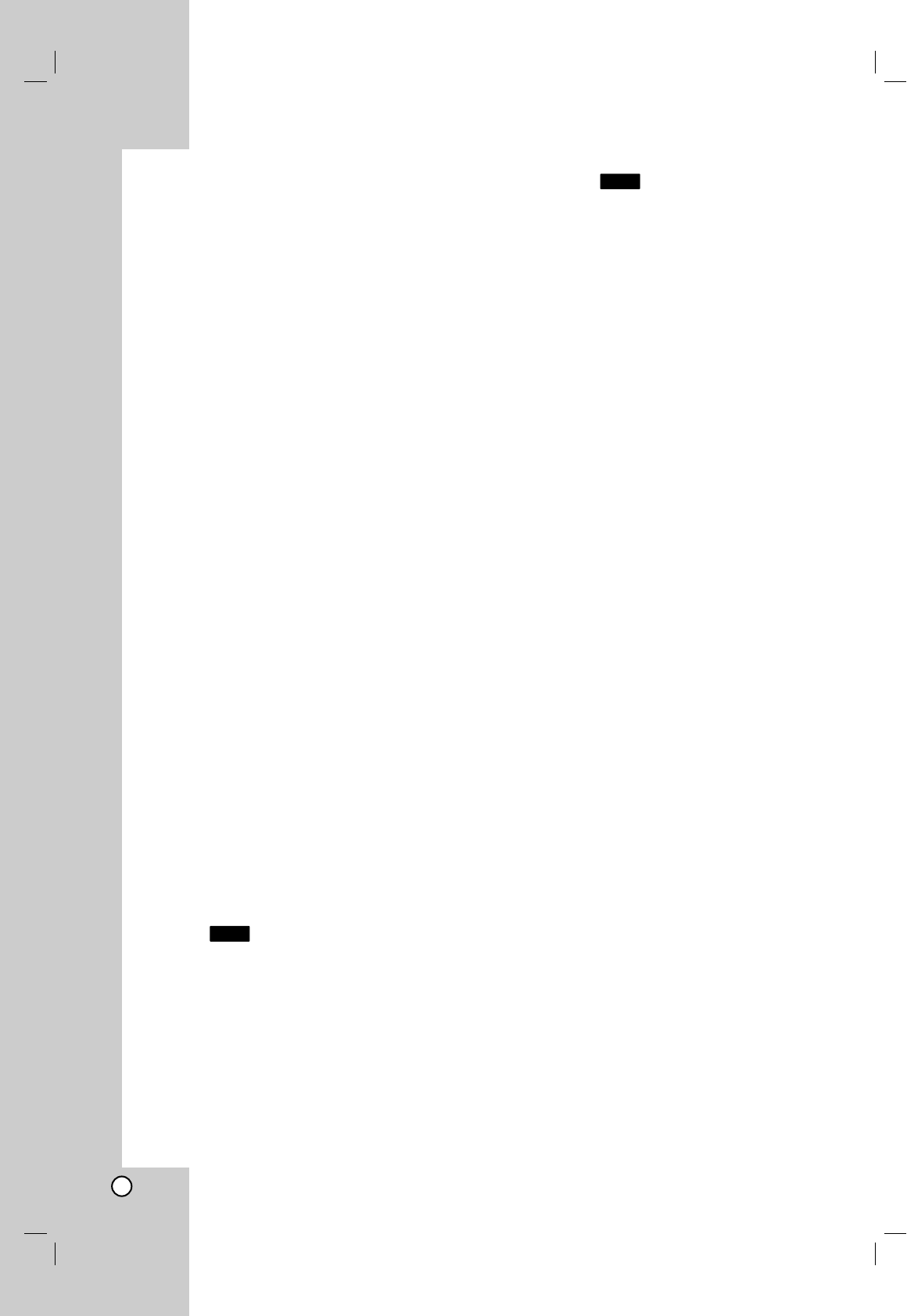
32
Repeat
Audio CDs - Repeat Track/All/Off
Press REPEAT to select a desired repeat mode.
TRACK: repeats the current track.
ALL: repeats the all tracks on the disc.
OFF: does not play repeatedly.
MP3/WMA - Repeat Track/Folder/Off
Press REPEAT to select a desired repeat mode.
TRACK: repeats the current track.
FOLDER: repeats the all tracks in the current folder.
OFF: does not play repeatedly.
Random
1. Press RANDOM during playback or in stop mode.
The unit automatically begins Random Playback
and [RANDOM] appears on the menu screen.
2. To return to normal playback, press RANDOM
repeatedly until [RANDOM] disappears from the
menu screen.
Tip:
By pressing SKIP >during Random playback, the
unit selects another track and resumes Random
playback.
3D Surround
This unit can produce a 3D Surround effect, which
simulates multi-channel audio playback from two
conventional stereo speakers, instead of the five or
more speakers normally required to listen to multi-
channel audio from a home theater system.
1.
Press 3D SURR. during playback to select
[3D SUR].
2. To turn off the 3D Surround effect, press 3D
SURR. until [3D SUR] disappears from the menu
screen.
Changing the Audio Channel
Press AUDIO repeatedly to hear a different audio
channel (stereo, left or right).
Search
1. Press SCAN (mor M) during playback.
The recorder will now go into SEARCH mode.
2. Press SCAN (mor M)repeatedly to select the
required speed (3 steps).
3. To exit SEARCH mode, press N(PLAY).
Repeat A-B
1. To repeat a sequence during disc playback Press
A-B at your chosen starting point. The Repeat icon
and [A -] appear on the menu screen.
2. Press A-B again at your chosen end point. The
Repeat icon and [A-B] appear on the menu
screen, and the sequence begins to play
repeatedly.
3. Press A-B again to cancel.
About MP3/WMA
About MP3/WMA audio files
audio files
MP3 / WMA file compatibility with this recorder is
limited as follows:
Sampling frequency: within 8 - 48 kHz (MP3), within
32 - 48kHz (WMA)
Bit rate: within 8 - 320kbps (MP3),
32 - 192kbps (WMA)
The recorder cannot read an MP3/WMA file that has
a file extension other than “.mp3” / “.wma”.
CD-R physical format should be “ISO 9660” and
“JOLIET”.
DVD±R/RW physical format should be “ISO 9660
(UDF Bridge format)”.
If you record MP3 / WMA files using software that
cannot create a file system (eg. Direct-CD) it is
impossible to playback MP3 / WMA files. We
recommend that you use Easy-CD Creator, which
creates an ISO 9660 file system.
File names should have a maximum of 8 letters and
must incorporate an .mp3 or .wma extension.
They should not contain special letters such as / ?
* : “ < > l etc.
The total number of files and folders on the disc
should be less than 1999.
This recorder requires discs and recordings to meet
certain technical standards in order to achieve optimal
playback quality. Pre-recorded DVDs are automatically
set to these standards. There are many different types
of recordable disc formats (including CD-R containing
MP3 or WMA files) and these require certain pre-
existing conditions (see above) to ensure compatible
playback.
Customers should note that permission is
required in order to download MP3 / WMA files
and music from the Internet. Our company has no
right to grant such permission. Permission should
always be sought from the copyright owner.
ACD
ACD
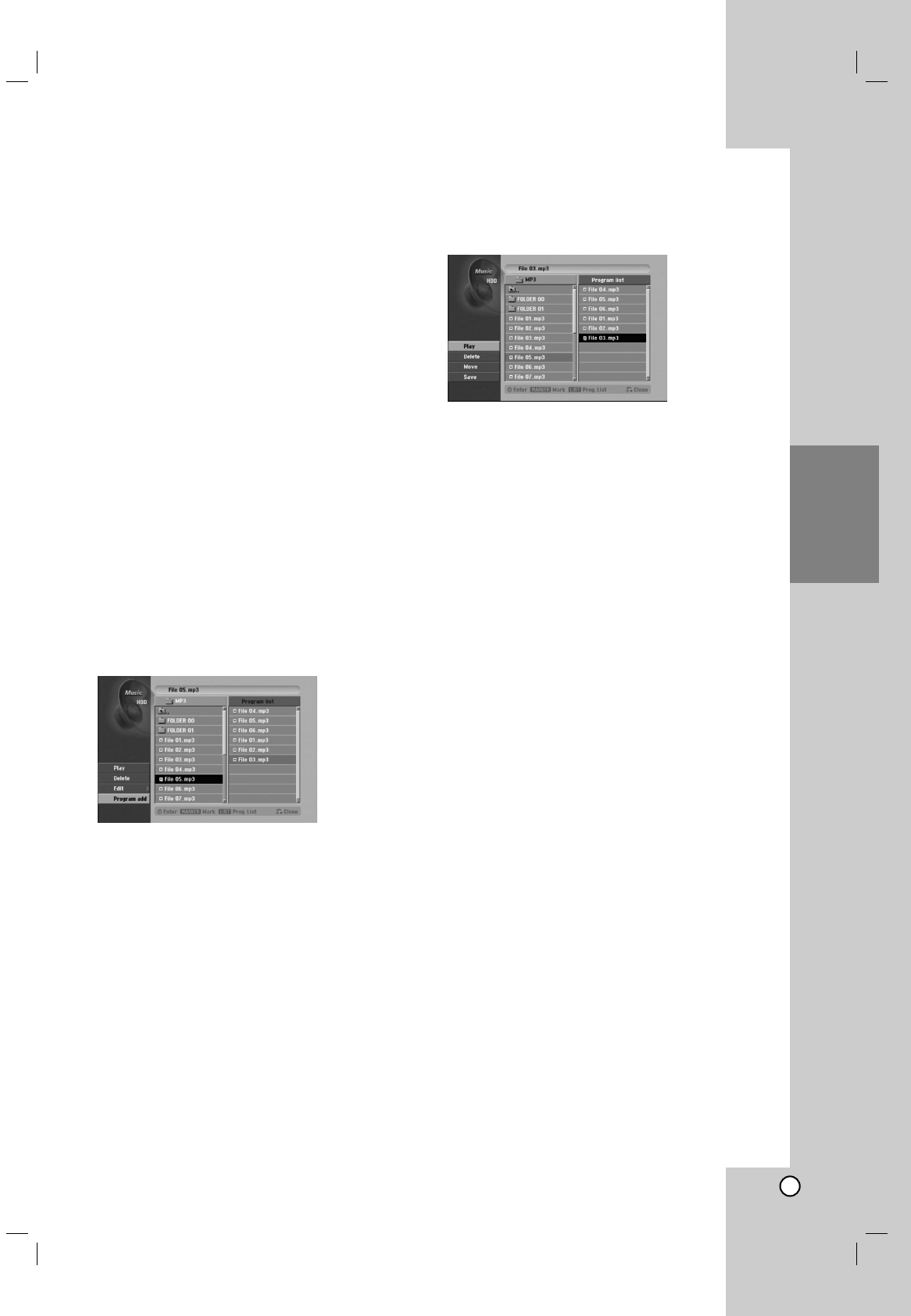
33
Playback
Program Playback with
Program Playback with Audio
Audio
CD and MP3/WMA
CD and MP3/WMA file
file
Program Playback enables you to make custom
playlists of Audio CD or MP3/WMA tracks. Programs
can contain up to 99 Audio CD tracks or 256
MP3/WMA files.
1. Use v/ Vto select a track/file (or folder) on the
Audio CD or Music menu.
You can select all files and folders on the Music
menu by pressing CLEAR button. To cancel the
selections, press CLEAR again.
Selecting multiple files/tracks (folders)
1. Press MARKER.
Acheck mark appears on the file/track or
folder. Press MARKER again to cancel the
marked file/track or folder.
2. Repeat step 1 to mark additional file/track
(folders).
2. Press ENTER.
The options appear on the left side of the menu.
3. Use v/ Vto select the [Program Add] option then
press ENTER.
4. Repeat steps 1-3 to mark additional tracks.
Note:
If you select a folder for Programmed Playback, all
tracks/files in the folder are added to the Program List.
5. Use Bto move to the Program list.
The programmed track you selected last is
highlighted on the program list.
6. Use v/ Vto select the track you want to start
playing.
7. Press N(PLAY) to start.
Playback stops after playing the last programmed
track in the program list.
8. To exit Program Playback and resume normal
playback, select a track on the List and press N
(PLAY).
Tip:
You can access or remove the Program List screen by
pressing MENU/LIST.
Program List menu options
1. Press v/Vto select a track/file on the Program
List then press ENTER.
The menu options appear.
2. Use v/ Vto select an option then press ENTER
to confirm your selection.
[Play] Playback begins in the order in which you
programmed the tracks from the selected track.
[Delete] Deletes the track(s) from the Program
List menu.
[Move] Moves the track(s) to change the
program order.
[Save] Memorizes the program list. (HDD only)
Repeat Programmed Tracks
Press REPEAT to select the desired Repeat mode.
[TRACK] Repeats the current track.
[ALL] Repeats all tracks on the Program List.
[OFF] Cancels Repeat mode (no display).
Erasing a Track from the Program List
1. Select the track you wish to erase from the
Program List. Use MARKER button to select
multiple tracks.
2. Press ENTER. The menu options appears
3. Select [Delete] option then press ENTER.
Changing Track Order in the Program List
1. Select the track you wish to move on the Program
List. Use MARKER button to select multiple tracks.
2. Press ENTER. The menu options appears
3. Select [Move] option then press ENTER.
4. Use v/ Vto move the yellow bar to the desired
location, then press ENTER.
Save Your Program List (HDD only)
This recorder memorizes the user program list that
you have programmed.
1. Select a track on the Program List.
The menu options appear.
2. Select [Save] option then press ENTER.
The Program List is saved in the HDD’s
PROGRAM folder.
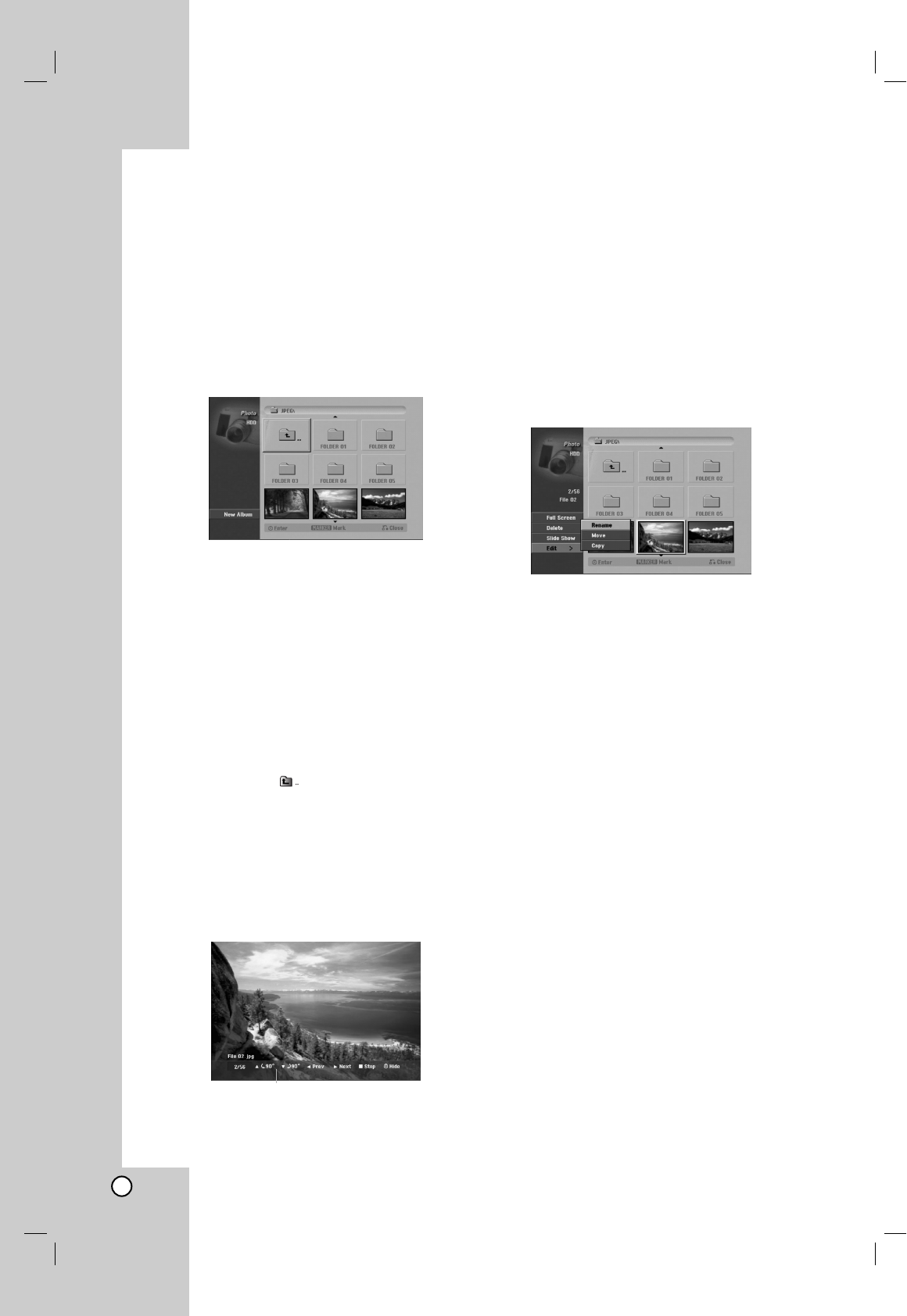
34
V
Viewing a JPEG File
iewing a JPEG File
The recorder can play JPEG files on the CD-R/RW,
DVD±R/RW, HDD, or Memory Card. Before playing
JPEG recordings, read “About JPEG image files” on
page 35.
1. Press HOME.
The HOME menu appears.
2. Select a media that contains JPEG file then press
ENTER.
3. Select [PHOTO] option then press ENTER.
The Photo menu appears on the TV screen.
4. Use b/ B/ v/ Vto select a folder, then press
ENTER.
The menu options appear on the left side of the
menu.
5. Select [Open] option then press ENTER.
Alist of files in the selected folder appears.
6. Use b/ B/ v/ Vto select a file, then press
ENTER.
The menu options appear on the left side of the
menu.
Tips:
•If you want to move to the upper directory, use the
v/ Vto highlight and press ENTER.
•You can also display HOME menu to select
another media by pressing RETURN (O).
7. Use v/ Vto select [Full Screen] then press
ENTER.
The selected image is displayed in full screen.
8. To stop viewing at any time, press STOP.
The Photo menu appears.
Photo menu options
1. Press v/Vto select a file on the Program List
then press ENTER.
The menu options appear.
You can select all files and folders on the menu by
pressing CLEAR button. To cancel the selections,
press CLEAR again.
Selecting multiple files (folders)
1. Press MARKER.
Acheck mark appears on the file or folder.
Press MARKER again to cancel the marked file
or folder.
2. Repeat step 1 to mark additional file (folders).
2. Use v/ Vto select an option then press ENTER
to confirm your selection.
[Open] Opens the folder and a list of files in the
folder appears
[Full Screen] Shows the selected file as full
screen.
[Delete] Deletes the selected file from the media.
(HDD, Memory Card only)
[Slide Show] Displays Slide Show menu.
[Rename] Edits the file name. (page 36) (HDD,
Memory Card only)
[Move] Moves the file(s) to another folder
(album) or media. (page 37) (HDD, Memory
Card only)
[Copy] Copies the file(s) to another folder or
media. (page 37)
Tip:
You can create new folder in the HDD or Memory
Card. Select [New Album] option then press ENTER.
“NONAME##” folder is created.
Skip Images
While viewing a picture, press SKIP (.or >)
once to advance to the next file or return to the
previous file.
Rotate Images
Use v/ Vwhile viewing a picture to flip the picture
clockwise or counterclockwise.
Press ENTER to appear or disappear this menu.
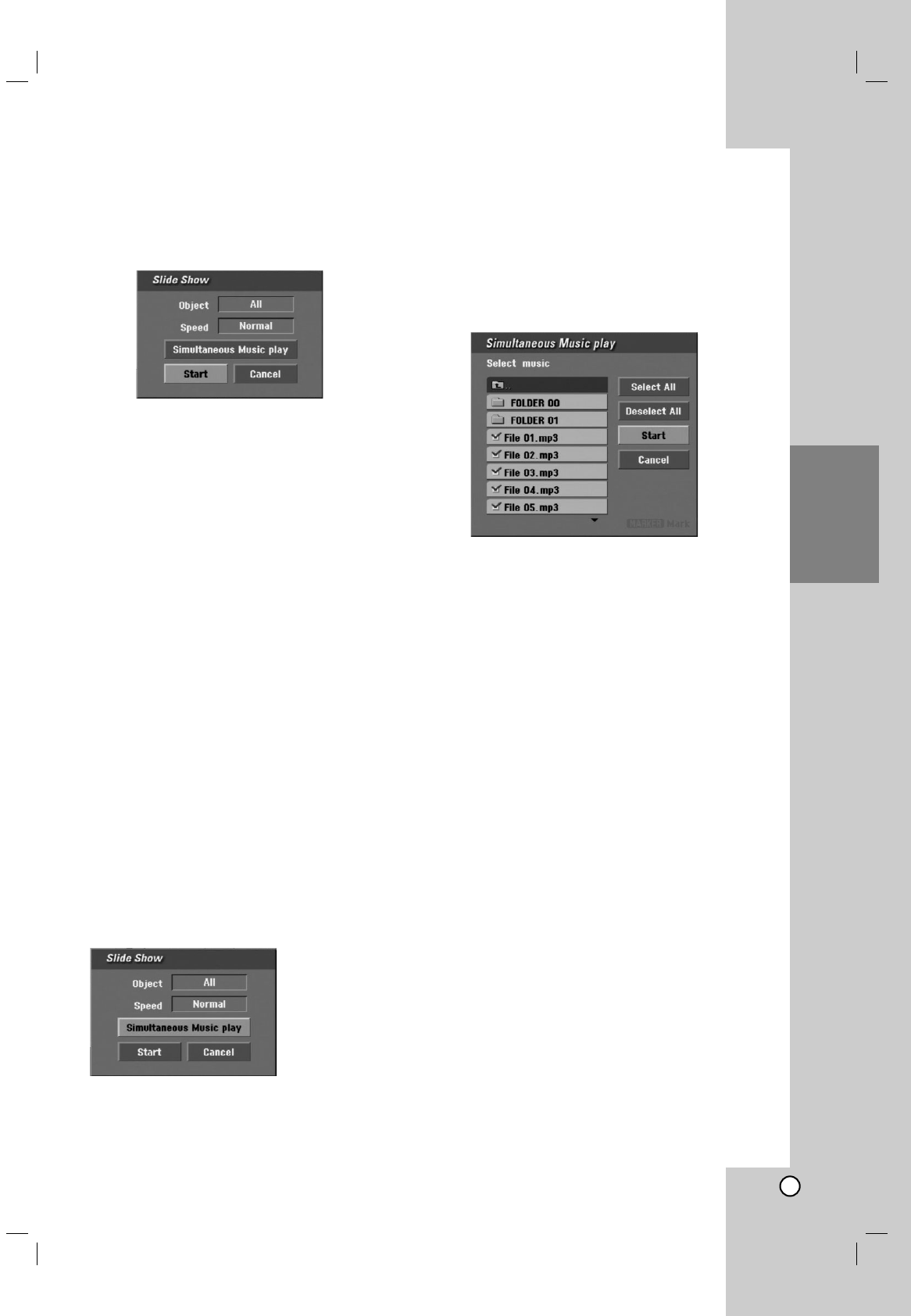
35
Playback
View Slide Shows
1. Select [Slide Show] option on the Photo menu
(Refer to [Photo menu options] on page 34).
2. Press ENTER.
The Slide Show menu appears.
3. Use b/ B/ v/ Vto set the options.
[Object] option:
[Selected] Views slide show only selected files.
Use the MARKER button to select multiple files.
[All] Views slide show all files.
[Speed] option:
Sets the Slide Show speed to [Slow], [Normal], or
[Fast].
4. Select the [Start] option then press ENTER to start
the Slide Show.
5. Press STOP to stop the Slide Show and returns to
the Photo menu.
To Pause the Slide Show
1. Press PAUSE/STEP (X) to pause slide show.
2. When you want to continue slide show, press
N(PLAY).
To listen to music while slide show
simultaneously
You can display photo files while listening to
MP3 music files recorded on HDD.
1. Select [Slide Show] option on the Photo menu
(Refer to [Photo menu options] on page 34).
2. Press ENTER.
The Slide Show menu appears.
3. Select [MP3 Simultaneous Play] option on the
Slide Show menu
4. Press ENTER.
MP3 Simultaneous Play menu appears.
5. Press MARKER to select multiple files.
Select [Select All] option to select all tracks then
press ENTER.
Select [Deselect All] option to deselect all
selected tracks then press ENTER.
Select [Cancel] option to exit this menu then
press ENTER.
6. Use b/ B/ v/ Vto highlight [Start] option then
press ENTER.
7. Press STOP to stop the Slide Show and return to
the Photo menu.
About JPEG image files
JPEG disc compatibility with this recorder is
limited as follows:
Depending upon the size and number of JPEG files,
it could take a long time for the recorder to read the
files. If you don’t see an on-screen display after
several minutes, some of the files may be too large
— reduce the resolution of the JPEG files to less
than 4M pixels.
The total number of files and folders on the disc
should be less than 1999.
Some discs may be incompatible due to a different
recording format or the condition of disc.
Ensure that all the selected files have the “.jpg”
extensions when copying into the CD layout.
If the files have “.jpe” or “.jpeg” extensions, please
rename them as “.jpg” file.
File names without “.jpg” extension will not be able
to be read by this recorder. Even though the files
are shown as JPEG image files in Windows
Explorer.
Progressive and lossless compression JPEG image
files are not supported.
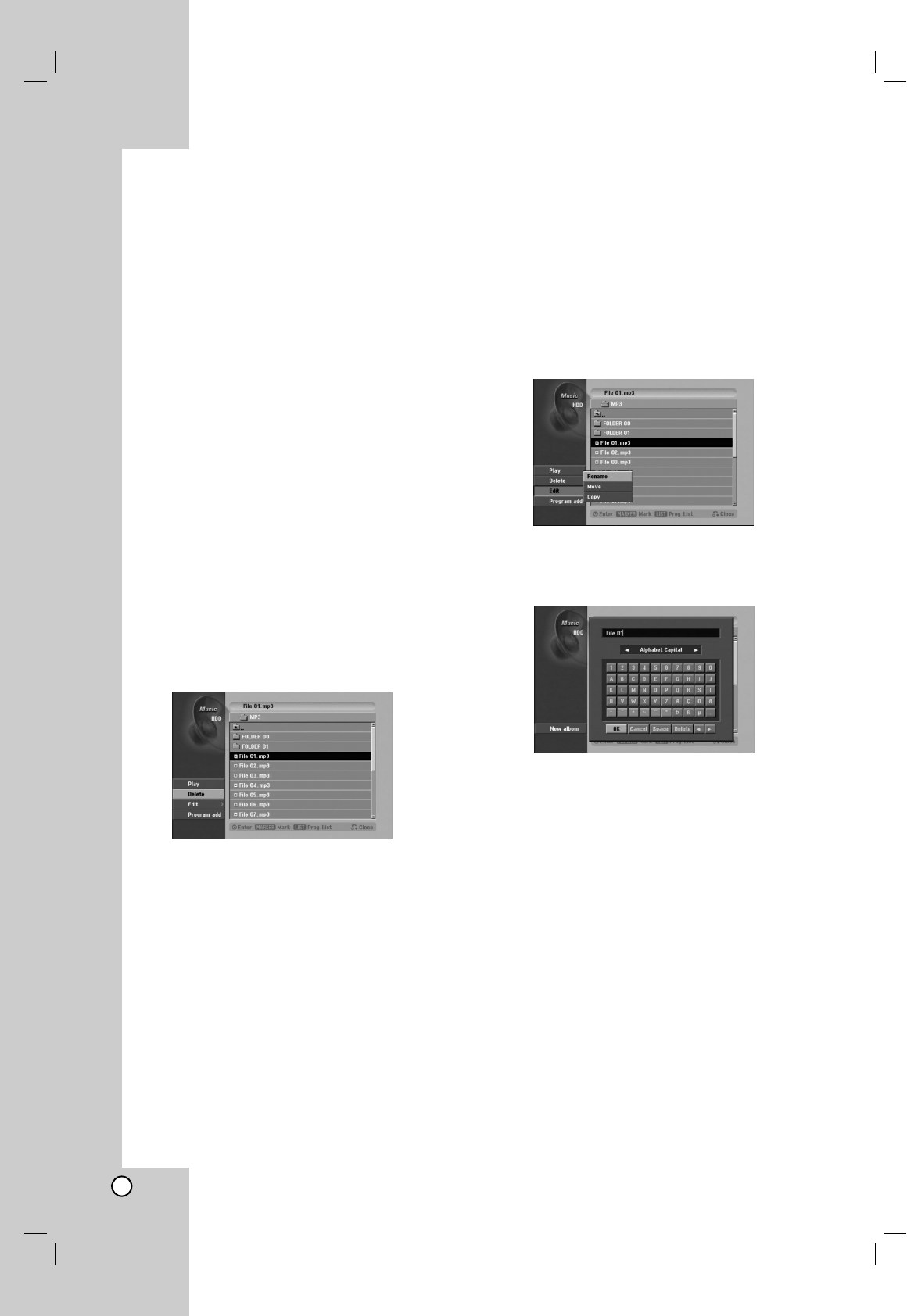
36
Editing a MP3/WMA, JPEG,
Editing a MP3/WMA, JPEG,
DivX file
DivX file
These descriptions are MP3 file’s operation for
example, other kind’s files are operated same way.
Notes:
•The MP3/WMA, and DivX files on the disc or HDD
cannot be copied or moved to Memory Card.
•The DivX file(s) in the memory card is not
available.
Erasing a file(s)/folder(s) from the HDD
or Memory Card
You can erase MP3/WMA, JPEG or DivX file(s)/
folder(s) on the HDD or Memory Card.
1. Select a file you wish to erase on the menu.
You can select all files and folders on the menu by
pressing CLEAR button. To cancel the selections,
press CLEAR again.
Selecting multiple files (folders)
1. Press MARKER.
Acheck mark appears on the file or folder.
Press MARKER again to cancel the marked file
or folder.
2. Repeat step 1 to mark additional file (folders).
2. Press ENTER.
The menu options appear on the menu.
3. Select [Delete] option then press ENTER.
The selected file(s) is deleted from HDD or
Memory Card.
Naming a file on the HDD or Memory
Card
You can name MP3/WMA files on the HDD or Memory
Card independently. Names can be up to 32
characters long.
1. Select a file you wish to rename on the menu.
2. Press ENTER.
The menu options appear on the menu.
3. Select [Edit] option then press ENTER.
Edit options appears.
4. Select [Rename] option then press ENTER.
Keyboard menu appears.
To enter characters, see page 48.
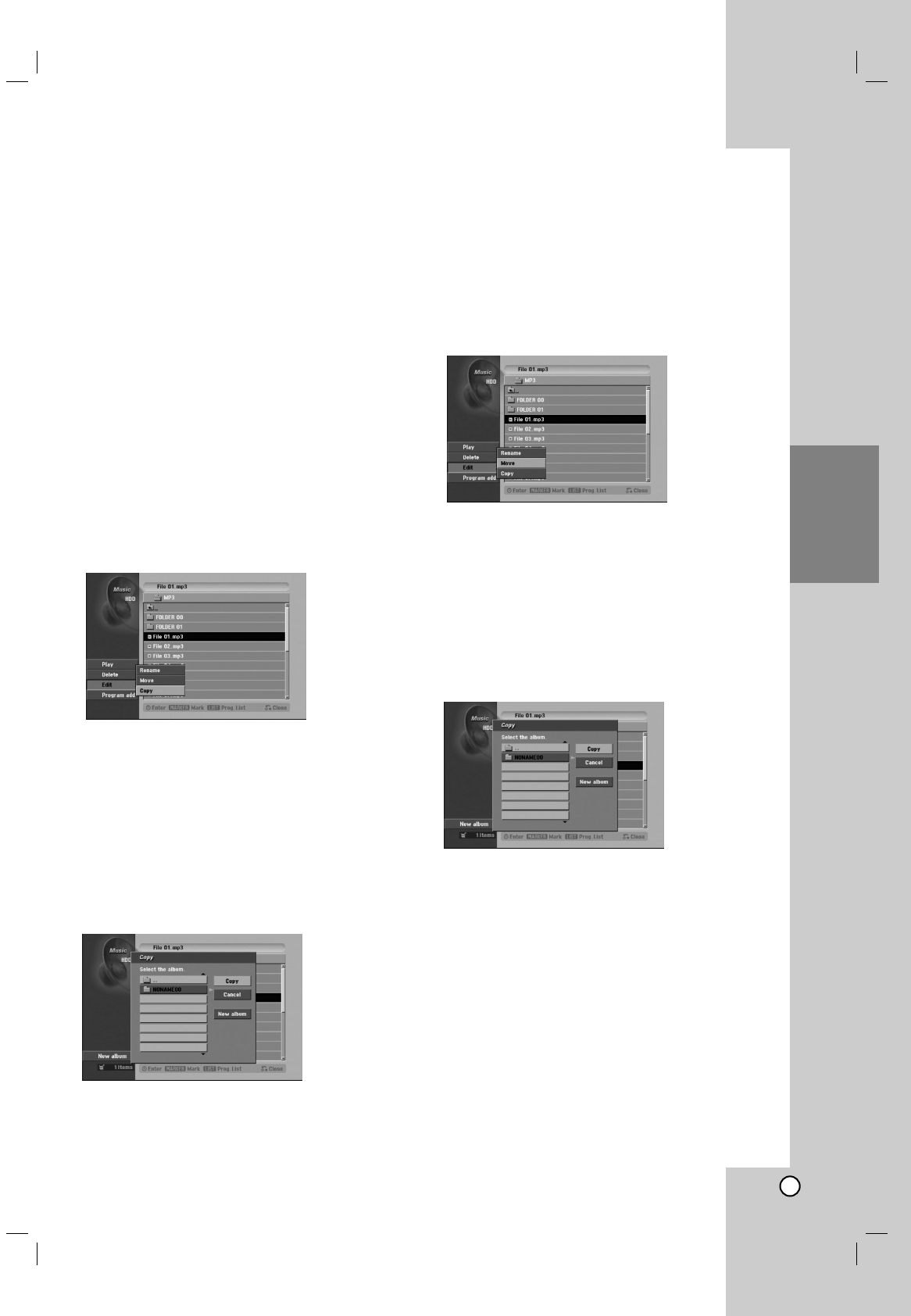
37
Playback
Copying a file(s) to another media or
folder
You can copy a file(s)/folder(s) to another media or
folder.
1. Select a file you wish to copy on the menu.
You can select all files and folders on the menu by
pressing CLEAR button. To cancel the selections,
press CLEAR again.
Selecting multiple files (folders)
1. Press MARKER.
Acheck mark appears on the file or folder.
Press MARKER again to cancel the marked file
or folder.
2. Repeat step 1 to mark additional file (folders).
2. Press ENTER.
The menu options appear on the menu.
3. Select [Edit] option then press ENTER.
Edit options appears.
4. Select [Copy] option then press ENTER.
Copy menu appears.
5. You can select a album (folder) to copy.
1. After selecting a media then press ENTER.
The album (folder) list appears.
2. Select a folder.
Also, you can create new album (folder). Select
[New Album] option on the Copy menu then
press ENTER.
“NONAME##” folder is created.
6. Select [Copy] option then press ENTER to begin
copying.
Moving a file(s)
You can move a file(s)/folder(s) to another media or
folder. After moving, the file(s)/folder(s) are deleted
from the current location.
1. Follow steps 1-3 as shown left.
2. Press ENTER.
The options appear on the left side of the menu.
3. Select [Move] option then press ENTER.
Move menu will appear.
4. You can select a album (folder) to move.
1. After selecting a media then press ENTER.
The album (folder) list appears.
2. Select a folder.
Also, you can create new album (folder). Select
[New Album] option on the Move menu then
press ENTER.
[NONAME##] folder is created.
5. Select [Move] option then press ENTER to begin
moving.

38
Recording
About DVD recording
About DVD recording
Notes:
•This recorder cannot make recordings on CD-R or
CD-RW discs.
•Our company takes no responsibility for recording
failure due to power outages, defective discs, or
damage to the Recorder.
•Fingerprints and small scratches on a disc can
affect playback and/or recording performance.
Please take proper care of your discs.
Disc types and recording formats, modes,
and settings
This recorder can play five different kinds of DVD
discs: pre-recorded DVD-Video discs, DVD-RW,
DVD-R, DVD+RW and DVD+R discs. The disc format
for DVD-R, DVD+R, DVD+RW discs is always “Video
format”—the same as pre-recorded DVD-Video discs.
This means that once finalized, you can play a
DVD-R, DVD+R, or DVD+RW in a regular DVD
player.
By default, the DVD-RW disc format is Video
Recording (VR) format, though you can change this to
Video format, if required. (Reinitializing the disc will
erase the contents of the disc.)
The recording mode is closely related to the disc
format. If the disc format is Video Recording format,
then the recording mode is VR mode; if the disc
format is Video mode, then the recording mode is
Video mode (except for DVD-Video, which is not
recordable, and so does not have a recording mode).
Within the recording modes (which are fixed for them
whole disc) are the record settings. These can be
changed as required for each recording and
determine the picture quality and how much space the
recording will take up on the disc.
About HDD recording
About HDD recording
Recording to the internal hard disk drive (HDD) is
basically similar to recording to a VR mode DVD-RW
disc. You have the full choice of recording quality
options, including the manual mode, and of course
you can record, erase and re-record as many times as
you like. The capacity of the hard disk drive means
that you can store many hours of video on it, even in
the higher quality recording modes. To help you
organize the contents, the HDD is divided into ten
genre. You can name and use these genres as you
like—for example, you might have a genre for movies,
another for TV shows, and one for camcorder
recordings.
Notes:
•The maximum number of titles that can be
recorded on the HDD is 255.
•Using the HDD allows you to record a maximum of
48 hours continuously.
Notes for recording
The recording times shown are not exact because
the recorder uses variable bit-rate video
compression. This means that the exact recording
time will depend on the material being recorded.
When recording a TV broadcast, if the reception is
poor or the picture contains interference, the
recording times may be shorter.
If you record still pictures or audio only, the
recording time may be longer.
The displayed times for recording and time
remaining may not always add up to exactly the
length of the disc.
The recording time available may decrease if you
heavily edit a disc.
If using a DVD-RW disc, make sure you change the
recording format (Video mode or VR mode) before
you record anything on the disc. See page 24 (Disc
Format) for how to do this.
When using a DVD-R or DVD+R disc, you can keep
recording until the disc is full, or until you finalize the
disc. Before you start a recording session, check
the amount of recording time left on the disc.
When using a DVD-RW disc in Video mode,
recording time available will only increase if you
erase the last title recorded on the disc.
The Delete Title option in the Title List (Original)
menu only hides the title, it does not actually erase
the title from the disc and increase the recording
time available (except for the last recorded title on a
DVD-RW disc in Video mode).
Overwrite recording is available using DVD+RW
discs.
When using a DVD+R/RW, the recorder will execute
the Menu-making operation to update the new title
and editing when removing the disc from the recorder.
So you must remove the disc after selecting the
recorder’s operation mode to DVD mode.
Recording time and picture quality
There are four preset recording quality modes:
HQ – Highest quality setting, gives about 1 hour of
recording time on a DVD (4.7GB).
SQ – Default quality, sufficient for most applications,
gives about 2 hours of recording time on a DVD
(4.7GB).
LQ – Slightly lower video quality, gives about 4 hour
of recording time on a DVD disc (4.7GB).
EQ – Lowest video quality, gives about 6 hour of
recording time on a DVD (4.7GB).
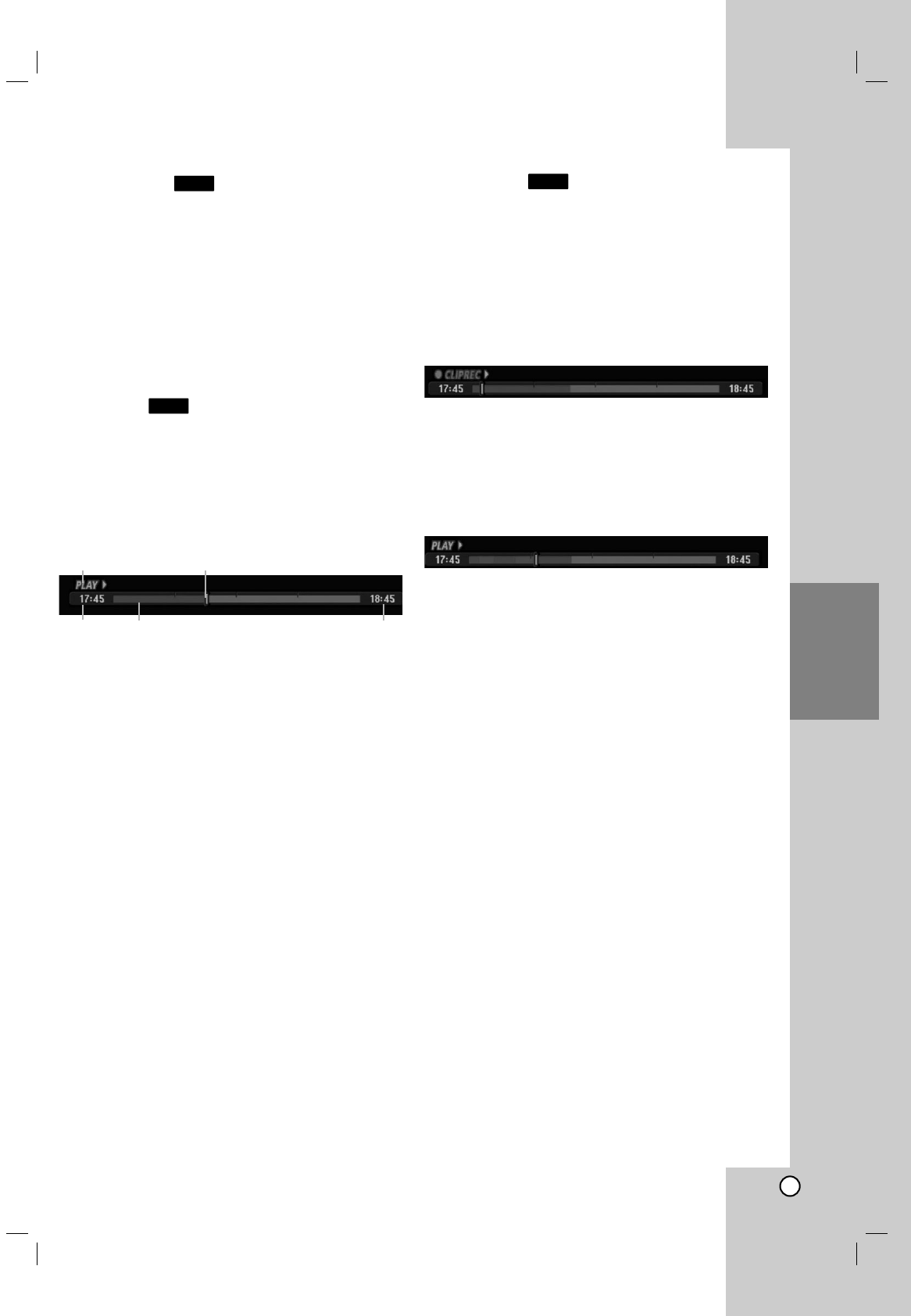
39
Recording
T
Timeshift
imeshift
Do not miss a scene from a live broadcast. If the
telephone rings while you are watching your favorite
live broadcast, just press “TIMESHIFT” and “PAUSE”
before answering the phone. The timeshift function will
be activated and the broadcast is then recorded for
later viewing.
After the phone call or viewing interruption, press
“PLAY” or “SCAN” to watch the program.
Press “STOP” to return to the live broadcast.
Timeshift (Pause, Live TV/Playback)
Operation
You can store a program in the HDD storage cache
temporarily.
Press TIMESHIFT while watching a TV program.
The Progress Bar display appears on the screen as
shown below. The Progress Bar changes to timeshift
icon after 5 seconds.
1. Indicates playback mode.
2. Indicates current Timeshift position.
3. Indicates Timeshift start time.
4. Indicates Timeshift elapsed time.
5. Indicates the time that is one hour from Timeshift
start time.
Tips:
•You can use trick play functions (Slow, Scan, etc.)
during timeshift. Refer to Playback Operation on
pages 25-28.
•You can edit the cached clip during Timeshift to
retain the program on the HDD. Refer to Clip
Record on the right.
Notes:
•There is not free space on the HDD, the oldest
timeshift section of the cache will be incrementally
deleted.
•If no button is pressed for 6 hours, the Timeshift
will stop automatically.
Marker Search in Timeshift mode
You can mark one in Timeshift mode. Press MARKER
at the desired point during Timeshift.
Press SEARCH to recall the marked scene.
Clip Record
You can edit during Timeshift to store the program on
the HDD (Hard Disk Drive).
1. During Timeshift, use pause step, search and
slow-motion to find the starting point.
2. Press REC at the starting point of the section you
want to record.
Progress of the edit is indicated in red on the
Progress Bar.
3. Use pause step, search and slow-motion to find
the ending point.
4. Press REC at the ending point of the section you
want to record.
Normal playback continues.
5. Repeat steps 1 and 4 to make several Clip
Records of a program.
6. Press STOP to stop Timeshift.
Confirm message will appear.
7. Use b /Bto select [Yes] then press ENTER. Or,
press STOP again.
The current broadcast is displayed on the screen.
Notes:
•Selected sections are recorded on the HDD.
•If you want to stop Clip recording, press the STOP
button. If you press POWER to stop Clip
recording, the program may not be recorded on
the HDD.
•Clip records cannot be made for sections lasting
less than 5 seconds.
Jump to Start or End during Timeshift
1. Press ENTER during timeshift. The menu will
appear.
2. Press bband playback starts from the very
beginning of the timeshift.
Press BBand jumps to the very end of the timeshift
then goes to pause mode.
To Exit the Timeshift
1. Press STOP to exit Timeshift function.
Confirm message will appear.
2. Use b /Bto select [Yes] then press ENTER.
The current broadcast is displayed on the screen.
HDD
HDD
HDD
34 5
12
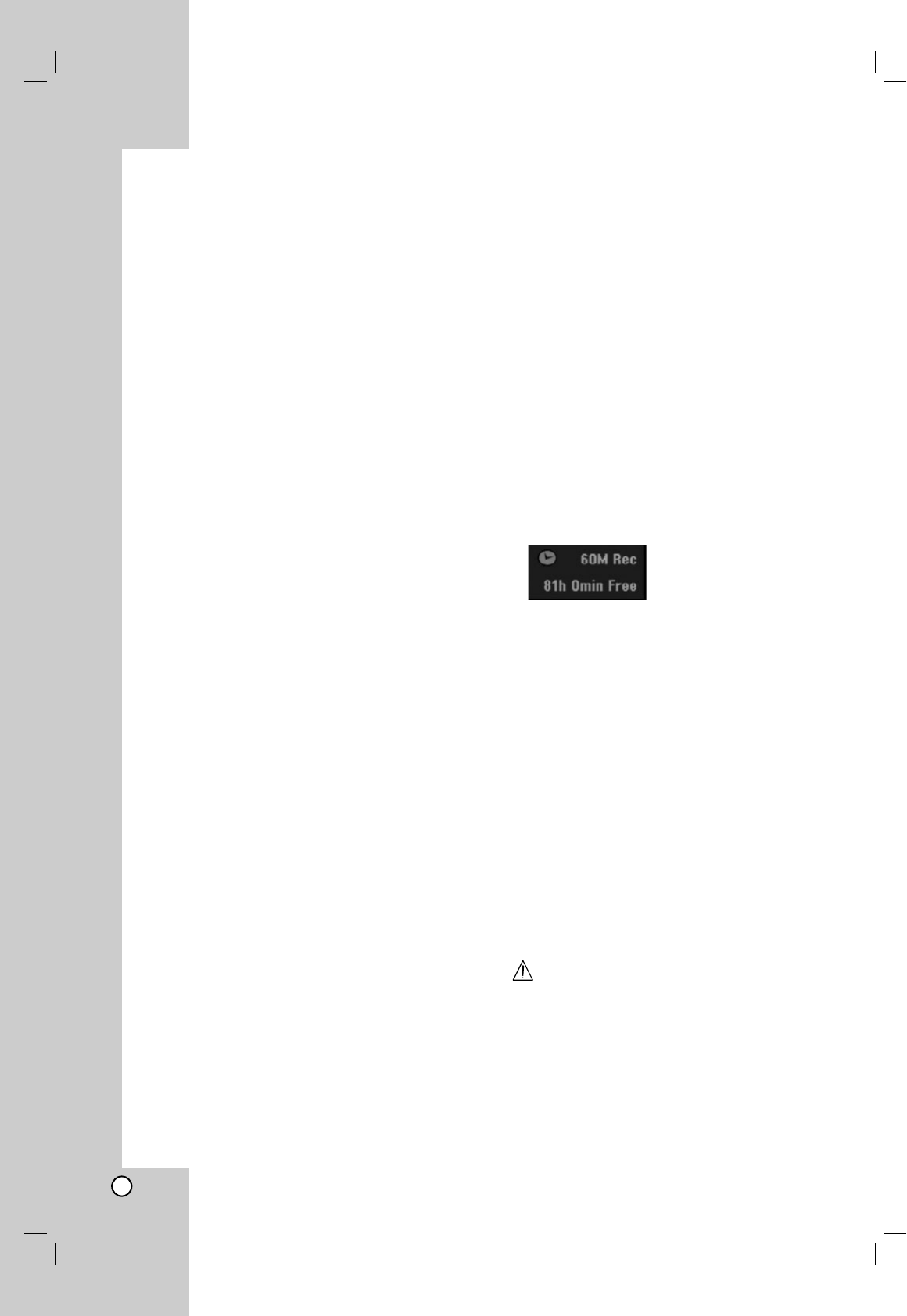
40
Basic Recording from a TV
Basic Recording from a TV
Follow the instructions below to record a TV program.
Recording starts immediately and continues until the
disc is full or you stop the recording.
Note:
You must load a recordable disc for DVD recording.
1. Press HOME.
The HOME menu appears.
2. Select a media (HDD or DISC) to record TV
program then press ENTER.
3. Select [TV (HDD)] or [TV (DVD)] option then press
ENTER.
Also make sure that the TV input is set to this
recorder.
If you load a completely blank disc, the recorder
takes a short while to initialize the disc.
4. Set a recording mode as necessary by pressing
REC MODE repeatedly. (HQ, SQ, LQ, EQ)
5. Use v/ Vbuttons to select the TV channel to
record.
Changing TV Audio Channel
You can select the audio channel (language) to listen
by pressing AUDIO during viewing TV program. The
current audio channel is displayed on-screen.
Stereo or mono broadcast:
Stereo →Left →Right →Mono
Bilingual broadcast:
Main →Sub →Main+Sub
If the sound is of poor quality when set to Stereo,
you can often improve it by changing to Mono (Left
or Right).
6. Press REC (z) once.
Recording will start. (The REC indicator lights in
the display window.)
Recording continues until you press STOP (x)
or the disc or HDD is full.
To record for a fixed length of time, see Instant
Timer Recording on right.
7. Press STOP (x) to stop recording.
To Pause the Recording
1. Press PAUSE/STEP (X) to pause recording.
2. When you want to continue recording, press
PAUSE/STEP (X).
To record one TV program while
watching another
1. Press TV/DVD to select the TV mode during
recording. The TV indicator appears.
2. Using the TV, select the channel to be viewed.
Instant T
Instant Timer Recording
imer Recording
Instant Timer Recording allows you to make a
recording easily of a preset length without using the
program timer.
1. Follow steps 1-4 as shown left (Basic Recording
from a TV).
2. Press REC (z) repeatedly to select the recording
time length.
Recording starts after the first press. Each
subsequent press increases the recording time
within free space (maximum 240 minutes).
The recording time is displayed on the TV screen.
At the end of the recording, the recorder will stop
recording and shut off.
Checking the Recording Time
Press REC (z) once to check the recording time. The
recalled setting will automatically return to the TV
screen for a moment.
Also, remaining time of recording is shown in the
display window.
To Extend the Recording Time
The recording time can be extended anytime by
pressing REC (z).
Each subsequent press increases the recording time
within free space (maximum 240 minutes).
Caution
If the recorder is unplugged (or there is a power
failure) while the recorder is recording, the recording
will be lost.
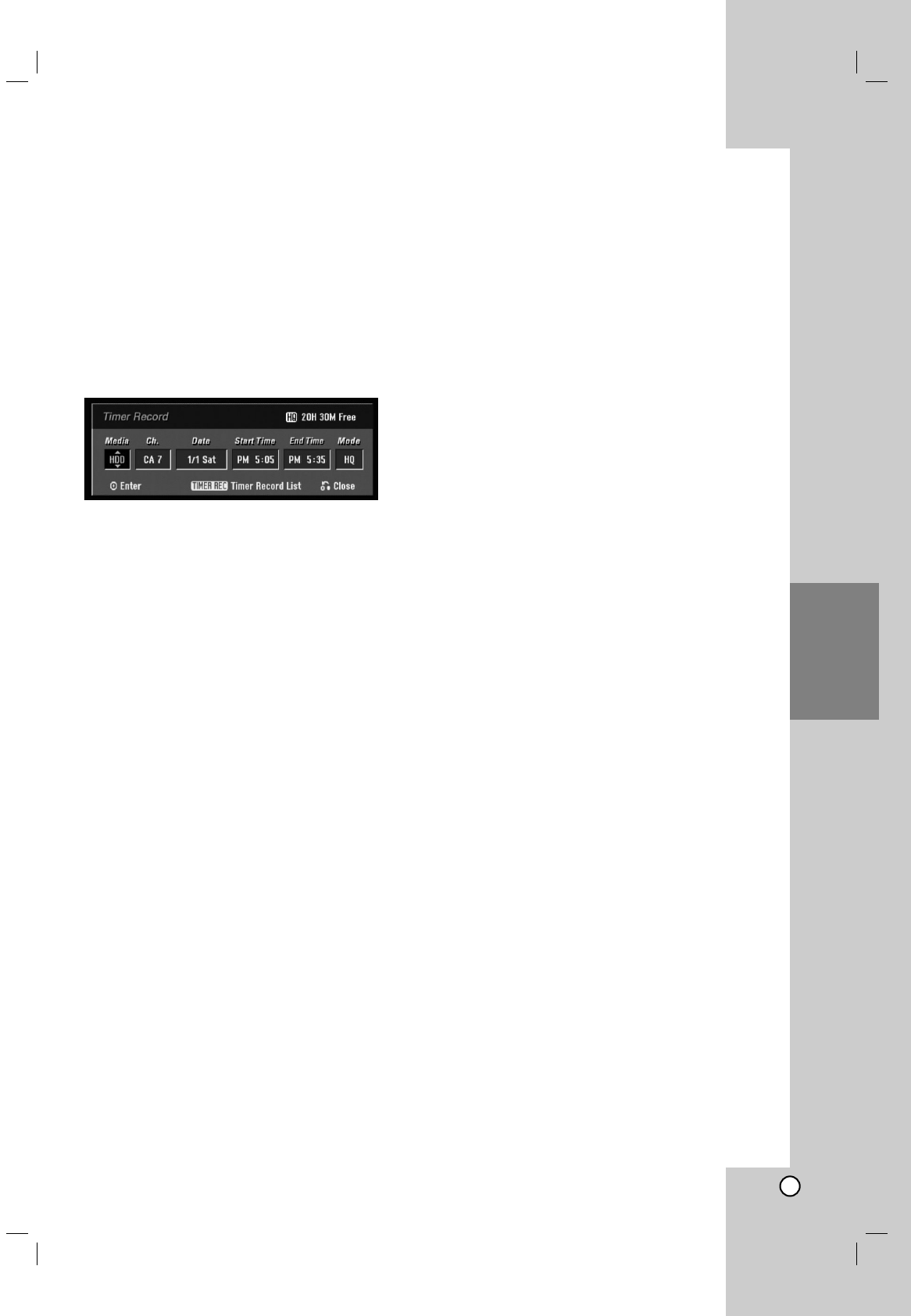
41
Recording
T
Timer Recording
imer Recording
This recorder can be programmed to record up to 8
programs within a period of 1 month. For unattended
recording, the timer needs to know the channels to be
recorded, the starting and ending time.
Note:
If you use a completely blank disc for timer recording,
you must format the disc before starting timer
recording. (Refer to “Disc Format” on page 22.
1. Press TIMER REC.
The Timer Record menu will appear.
[Media] Choose a media to record (HDD or
DVD).
[Ch.] Choose a memorized program number, or
one of the external inputs from which to record.
[Date] Choose a date up to
1 month
in advance.
[Start Time] Set the start time.
[End Time] Set the end time.
[Mode] Choose a record mode.
HQ, SQ, LQ, EQ or AT (Auto)
AT(Auto) mode determines how much time is
available on the disc or tape and switches
record mode, if necessary, to complete
recording the program.
2. Enter the necessary information for your timer
recording(s).
b /B (left/right) – move the cursor left/right
v /V (up/down) – change the setting at the
current cursor position
Press RETURN (O) to exit the Timer Record
menu.
Press ENTER after filling in all the program
information.
Press TIMER REC to display Timer Record List.
3. Press ENTER, the program will be memorized by
the recorder.
To check the programming, the Timer Record List
will appear.
Check field’s [Rec. OK] on the Timer Record List
indicates that the timer recording is programmed
correctly.
4. Press RETURN (O) to exit the Program List.
5. Make sure that you load a recordable disc for DVD
recording and press POWER to switch your unit to
Standby.
Notes:
•The timer indicator lights in the display window
when the recorder is in standby with the timer
active.
•You must press POWER to stop the timer
recording.
•If you set a timer recording to record to DVD but
there isn’t a recordable DVD loaded at the time of
the recording, the Recovery Recording feature will
automatically record the program to the HDD for
you.
•The Recorder will automatically power off when
the Timer Recording ends.
Simultaneous recording and
Simultaneous recording and
playback
playback
Playback and recording for both DVD and built in hard
disk drive (HDD) are completely independent. For
example, you can record to either the DVD or HDD
source and play back video from the other source at the
same time.
1. Start recording.
2. Press HOME to display the Home Menu screen.
3. Use the v/ V/ b/ Band ENTER buttons to
select a different media type that you want to play
back.
4. Start Playback.
The recording will continue while playing back the
media from the other mode.
Notes:
•You can’t use simultaneous playback and
recording while copying or Timer recording.
•You cannot edit programs during simultaneous
recording and playback.
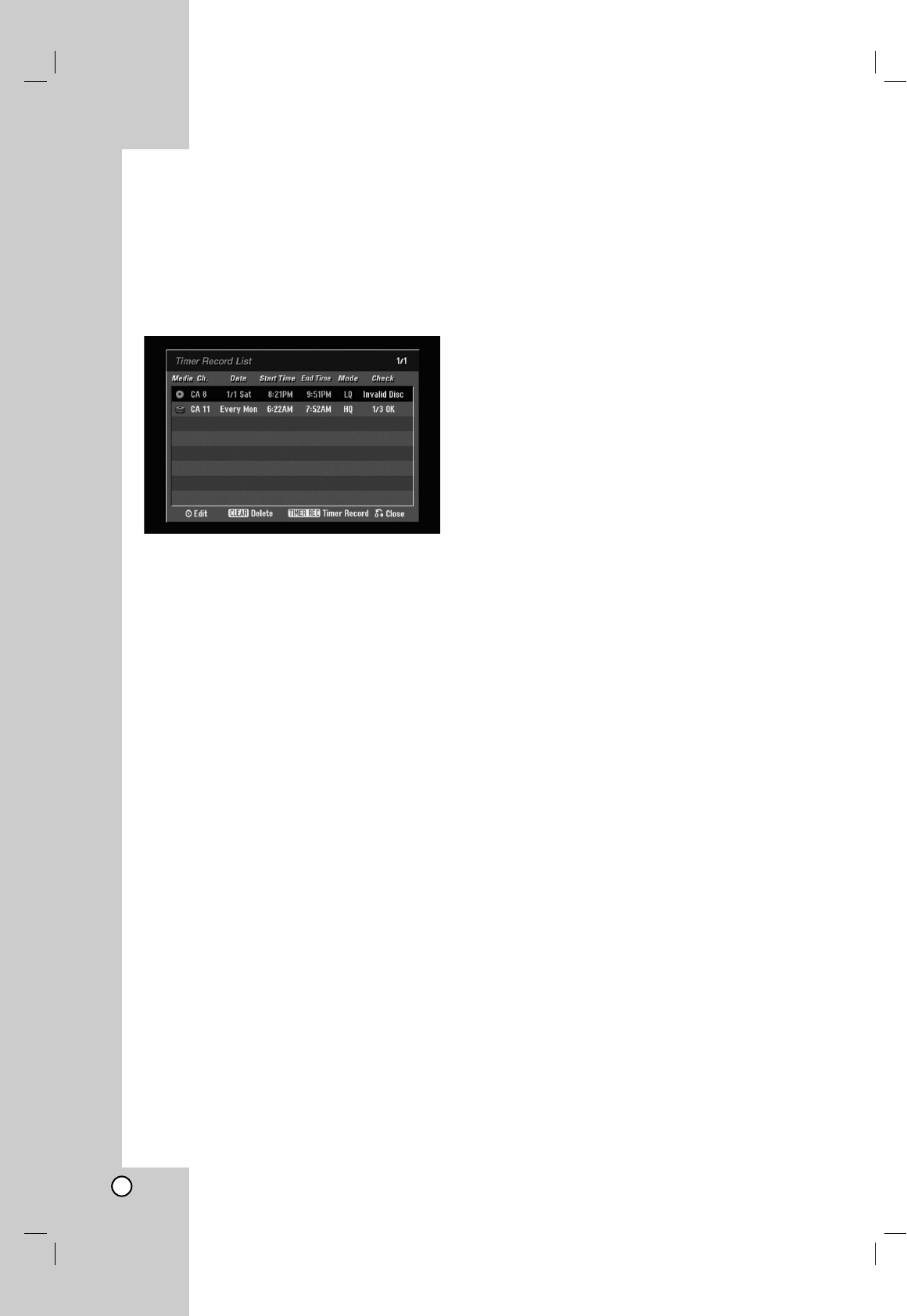
42
Checking T
Checking Timer Recording
imer Recording
Details
Details
Programming can be checked whenever the recorder
is turned on. Press TIMER REC twice.
Use v/ Vto select a timer recording.
Press ENTER to edit the selected program.
Timer Record menu appears.
Canceling a Timer Recording
You can clear a timer setting anytime before the
recording actually starts.
Use v/ Vto select a program you want to erase on
the Timer Recorder List. If you want to erase the
program, press CLEAR.
Stopping a Timer Recording in Progress
After a timer recording has started, you can still
cancel the program.
Press POWER.
Timer Recording Troubleshooting
Even though the timer is set, the recorder will not
record when:
There is no disc loaded and there is not free space
on the HDD.
Anon-recordable disc is loaded and there is not
free space on the HDD.
[Disc Protect] option is set to [ON] in the Setup
menu and there is not free space on the HDD. (see
page 23).
Power is turned on.
There are already 99 titles (DVD-RW, DVD-R,
DVD+R), 49 titles (DVD+RW) recorded on the disc
and there are already 255 titles recorded on the
HDD.
You cannot enter a timer program when:
Arecording is already underway.
The time you’re trying to set has already passed.
There are already 8 timer programs set.
If two or more timer programs overlap:
The earlier program takes priority.
When the earlier program finishes, the later
program starts.
If two programs are set to start at exactly the same
time, the program entered first takes priority.
If the disc is damaged, the recording may not
complete successfully. In this case even though the
Check field shows “Rec. OK”, it may not be.
Recording from an External
Recording from an External
Input
Input
Recording from External Components
You can record from an external component, such as
a camcorder or VCR, connected to any of the
recorder’s external inputs.
1. Make sure that the component you want to record
from is connected properly to the recorder. See
page 14.
2. Choose a media (HDD or DVD) to record using
HOME menu. (see page 15).
3. Press INPUT repeatedly to select the external
input to record from.
Tuner: Built-in tuner
AV1: AUDIO/VIDEO IN1 mounted on back panel
AV2: INPUT 2 (VIDEO, AUDIO (L/R), S-VIDEO
IN) mounted on front panel
DV: DV IN mounted on front panel
4. Select the recording mode as necessary by
pressing REC MODE repeatedly. (HQ, SQ, LQ, or
EQ)
5. Press REC (z) once.
Recording will start. (The REC indicator lights in
the display window.)
Recording continues until you press STOP (x)
or the disc is full.
To record for a fixed length of time, see [Instant
Timer Recording] on page 40.
6. Press STOP (x) to stop recording.
Note:
If your source is copy-protected using CopyGuard,
you will not be able to record it using this recorder.
See Copyright on page 51 for more details.

43
Recording
Recording from DV Input
Recording from DV Input
Before DV dubbing
You can connect a DV-equipped camcorder to this
recorder using a single DV cable for input and output
of audio, video, data and control signals.
This recorder is only compatible with DV-format
(DVC-SD, DV25) camcorders. Digital satellite tuners
and Digital VHS video recorders are not compatible.
You cannot connect more than one DV camcorder
at a time to this recorder.
You cannot control this recorder from external
equipment connected via the DV IN jack (including
two recorders).
It may not always be possible to control the
connected camcorder via the DV IN jack.
Digital camcorders can usually record audio as
stereo 16-bit/48kHz, or twin stereo tracks of 12-
bit/32kHz. This recorder can only record one stereo
audio track. Set [DV Rec Audio] option to [Audio 1]
or [Audio 2] as required (see page 22).
Audio input to the DV IN jack should be 32 or
48kHz (not 44.1kHz).
Picture disturbance on the recording may occur if
the source component pauses playback or plays an
unrecorded section of tape, or if the power fails in
the source component, or the DV cable becomes
disconnected.
Recording from a Digital Camcorder
You can record from a digital camcorder connected to
the DV IN jack on the front panel of this recorder.
Using the recorder’s remote, you can control both the
camcorder and this recorder.
Before recording, make sure that the audio input for
the DV IN jack is set up (see page 22).
Tips:
•The source signal must be DVC-SD format.
•Some camcorders cannot be controlled using this
recorder’s remote.
•If you connect a second recorder using a DV
cable, you cannot control the second DVD from
this one.
•You cannot control this unit remotely from a
component connected to the DV IN jack.
•You cannot record date and time information from
a DV cassette.
1. Make sure your digital camcorder is connected to
the front panel DV IN jack. See page 14.
2. Select [TV(HDD)] or [TV(DVD] option on the
HOME menu then press ENTER. (see page 15).
3. Check that the DV audio input is as you require.
You can choose between Audio 1 (original audio)
and Audio 2 (overdubbed audio).
DV Input is set from the [DV Rec Audio] in
sub-menu of the Setup menu. See [DV
Recording Audio] on page 22 for more
information.
4. Press INPUT repeatedly to select the DV input.
DV appears in the display window and on the TV
screen.
5. Find the place on the camcorder tape that you
want to the recording to start from.
For best results, pause playback at the point from
which you want to record.
Depending on your camcorder, you can use this
recorder’s remote to control the camcorder
using the STOP, PLAY and PAUSE functions.
6. Press REC (z) once to start recording.
Recording is automatically stopped if the
recorder detects no signal.
You can pause or stop the recording by
pressing PAUSE/STEP (X) or STOP (x).
You cannot control the camcorder from this
remote control during recording.
In Video mode, the final frame of the recording
may remain displayed on screen for a while
after recording stops.
For timer recording to work properly on this
recorder, the digital camcorder must also be
switched on and in operating.
Troubleshooting
If you cannot get a picture and/or audio through the
DV IN jack, check the bullet points:
Make sure the DV cable is properly connected.
Try switching off the connected equipment then
switch back on.
Try switching the audio input.
Note:
Depending on the connected camcorder, you may not
be able to control it using the remote control supplied
with this recorder.
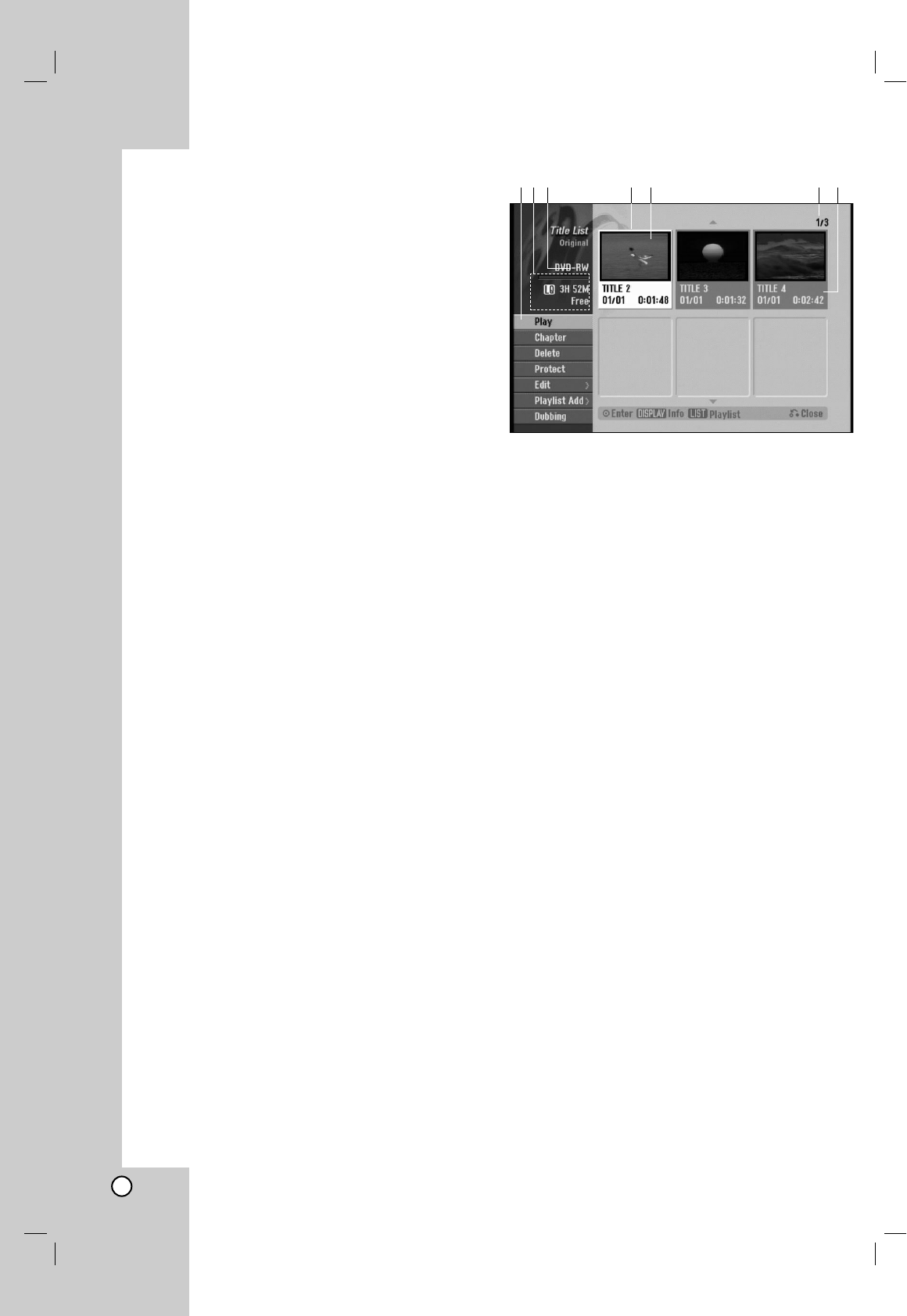
44
T
Title List and Chapter List
itle List and Chapter List
Menu Overview
Menu Overview
Using the Title List menu you can edit video content.
The editing features available in the Title List menu
depend on whether you are editing video on DVD, or
the HDD, and whether you’re editing Original content,
or a Playlist.
There are two ways to edit VR mode DVD-RW discs.
You can directly edit the Original content of the disc,
or you can create and edit a Playlist. The Playlist
doesn’t actually change any of the content on the
disc, but just controls how the content is played back.
Editing material recorded on the HDD is similar to
editing the Original content of a VR mode DVD-RW,
with similar commands for erasing and naming titles,
as well as fine control over the content of chapters
within titles for DVD disc.
Note:
During recording, if you display the Title List menu for
the HDD, some of the titles may appear with a mark.
These titles were recorded with a Line Input setting
different to the current setting of the recorder.
During recording, these titles cannot be played.
1. Press MENU/LIST to display the Title List menu.
Playback should be stopped when you do this.
You can also access it using HOME menu,
select [TITLE LIST] option then press ENTER.
When selecting titles, use the v/ Vbuttons to
display the previous/next page if there are more
than six titles.
If you are editing a VR mode disc, press
MENU/LIST to switch between Original and
Playlist menu.
On the left side of the screen are the menu options.
The main part of the screen shows thumbnails of the
titles (or chapter) on the DVD or HDD. You can
change these thumbnails using the THUMBNAIL
button—see Changing Title Thumbnails on page 45.
Press DISPLAY to display the information of selected
title on the Title List menu.
After selecting a title or chapter on the [Title List] or
[Chapter List] menu, then press ENTER. The menu
options appears on the left side of the menu.
Use v/ Vto select a option then press ENTER to
confirm your selection.
2. To exit the Title List menu, press RETURN (O)
repeatedly.
1. Menu options: To display menu option, select a
title or chapter then press ENTER. The options
displayed differ depending on the disc type.
[Chapter] Displays Chapter List of the title.
[Combine] Combines two titles or chapters into
one (page 49).
[Delete] Deletes the title or chapter. (page 47)
[Delete Part] Deletes a part of the Title (page
47).
[Divide] Divides a title into two (page 49).
[Dubbing] Copies the title to another media.
(page 52)
[Full Play] Starts playback of the selected title
including the hidden chapters.
[Hide (Show)] Hides (or Shows) the selected title
or chapter. (page 50)
[Move] Moves a chapter on the Chapter List-
Playlist menu to a position on the menu.
(page 50)
[Play] Start playback of the selected title or
chapter. The hidden titles and chapters on the
DVD+R/RW cannot be play back.
[Playlist Add] Adds the title or chapter to the
Playlist. (page 46)
[Protect] Protects accidental recording, editing or
deleting of the title. (page 50)
[Rename (Title Name)] Edits the title name.
(page 48)
[Sort] Lists the programs on the Title List menu
by Date, Title, or Category. (page 48)
[Title] Displays Title List of the chapter.
[Undo]/[Redo] Un-do/Re-do the last deletion/
action. (page 48)
2. Indicates the record mode, free space, and
elapsed time progress bar.
3. Current media
4. Currently selected title.
5. Thumbnail
6. Shows the selected title number and total number
of titles.
7. Shows the title name, recorded date, and
recording length.
123 4 5 6 7
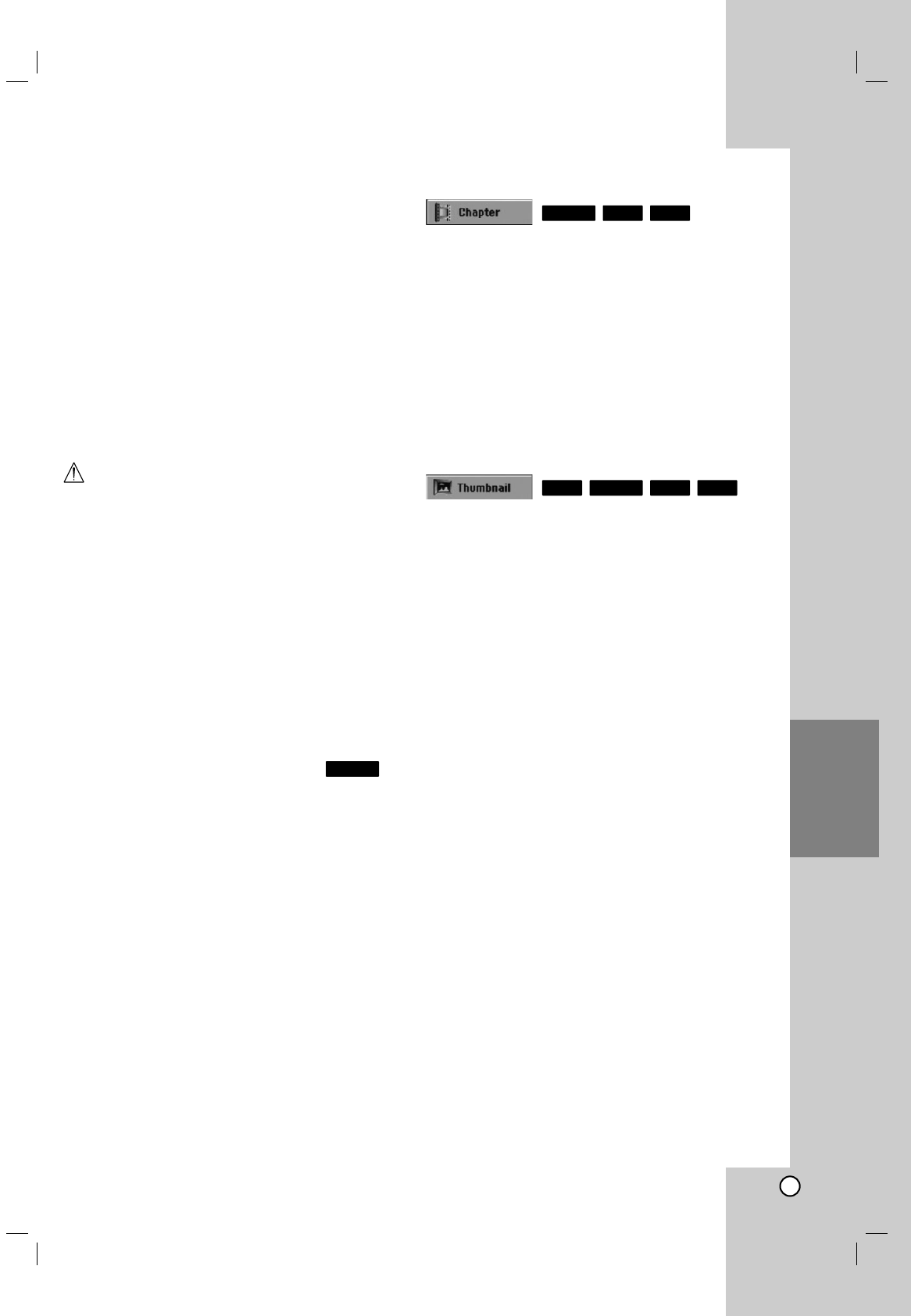
45
Editing
HDD, VR Mode: Original and
HDD, VR Mode: Original and
Playlist Editing
Playlist Editing
Titles, Chapters and Parts
Titles in the disc’s original content contain one or
more chapters. When you insert a disc’s title into the
Playlist, all the chapters within that title also appear. In
other words, chapters in the Playlist behave exactly as
chapters on a DVD-Video disc do. Parts are sections
of Original or Playlist titles. From the Original and
Playlist menu you can add or delete parts. Adding a
chapter or title to the Playlist creates a new title made
up of a section (ie., chapter) of an Original title.
Deleting a part removes part of a title from the
Original or Playlist menu.
Caution
When editing using the Delete, Add and Move
functions, the start and end frames may not be
exactly as set in the start and end point display.
During Playlist playback, you may notice a
momentary pause between edits. This is not a
malfunction.
Is editing a DVD like editing a video
tape?
No. When you edit a video tape you need one video
deck to play the original tape and another to record
the edits. With DVD, you edit by making a ‘Playlist’ of
what to play and when to play it. On playback, the
Recorder plays the disc according to the Playlist.
About word ‘Original’ and ‘Playlist’
Throughout this manual, you will often see the words
Original and Playlist to refer to the actual content and
the edited version.
Original: content refers to what’s actually recorded
on the disc.
Playlist: content refers to the edited version of the
disc — how the Original content is to be played.
Adding Chapter Markers
Adding Chapter Markers
You can create chapters within a title by inserting
chapter marks at the desired points.
Note:
Chapter markers are inserted at regular intervals
automatically. You can change this interval from the
Initial Setup menu (see [Auto Chapter] on page 22).
During recording or playing back, at the point you
want to start a new chapter, press CHP ADD.
Achapter marker icon appears on the TV screen.
Changing T
Changing Title Thumbnails
itle Thumbnails
Each title displayed in the Title List menu is
represented by a thumbnail picture taken from the
start of that title or chapter.
If you prefer, select a different still picture from within
a title.
Press THUMBNAIL to make the currently displayed
picture the one that appears in the Title List menu.
The still picture that you choose appears in both the
Original or Playlist menu.
Tip:
You can also change the thumbnail picture of the title
on the Chapter List menu. Select a chapter on the
Chapter List menu then press THUMBNAIL. The
thumbnail picture of the title that includes the chapter
is changed.
+R+RW-RWVR
HDD
+R+RW-RWVR
-RWVR
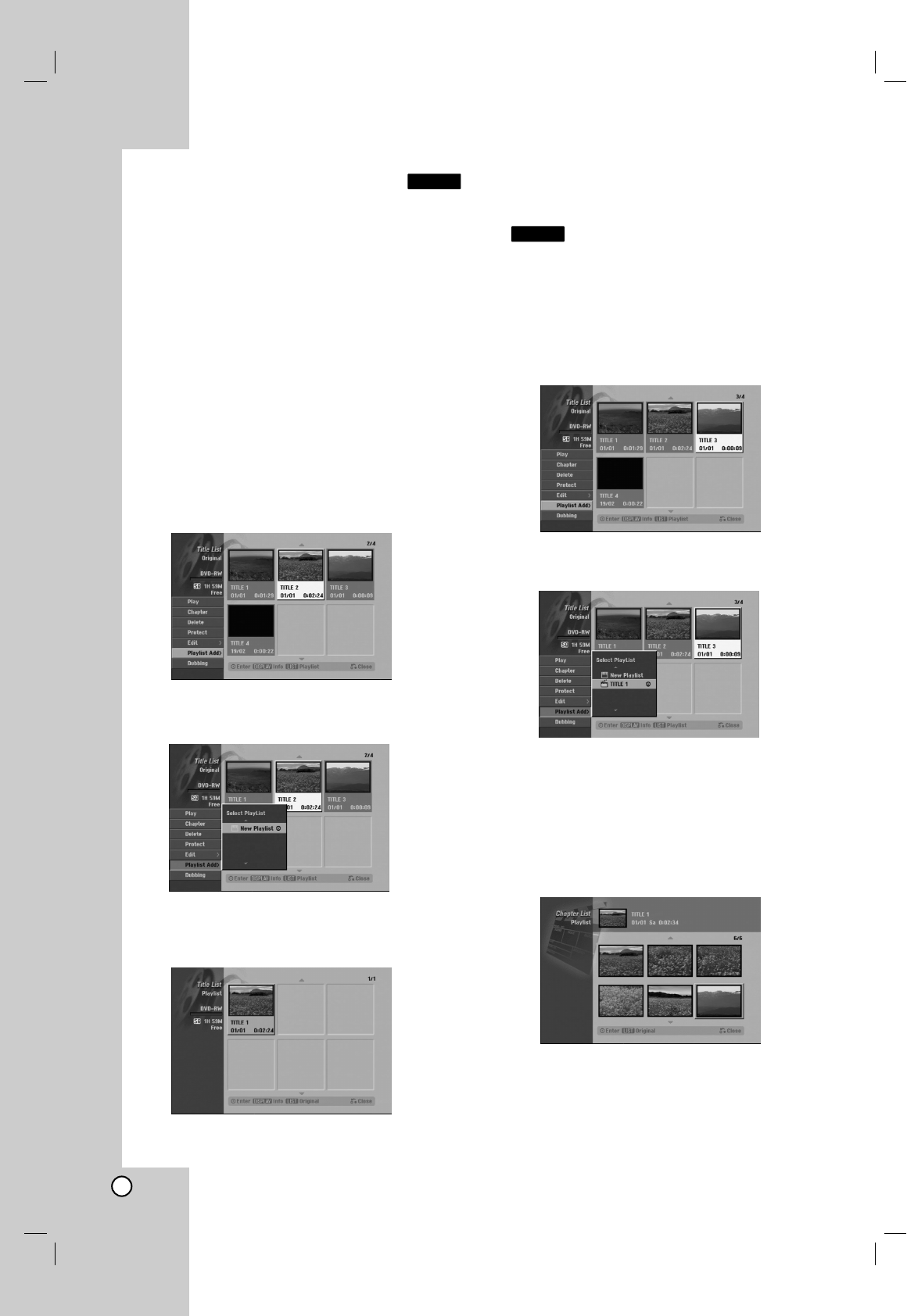
46
Making a New Playlist
Making a New Playlist
Use this function to add an Original title or chapter to
the Playlist. When you do this, the whole title is put
into the Playlist (you can delete bits you don’t need
later — see Deleting an Original or Playlist
title/chapter on page 47).
The title appears in the Playlist complete with the
chapter markers that appear in the Original. However,
if you add more chapter markers to the Original later,
these are not automatically copied over into the
Playlist title.
You can add up to 999 chapters to one disc . If you
only want to add a chapter of a title, use the Adding a
title/chapter to the Playlist on this page.
1. Choose a title or chapter on the Title List-Original
menu or Chapter List-Original menu to put into the
Playlist, then press ENTER.
The menu options appears on the left side of the
menu.
2. Use v/ Vto select [Playlist Add] option then press
ENTER.
3. Select [New Playlist] then press ENTER.
The new title appears in the updated Playlist. All
chapters of the title are added to the Playlist.
Adding
Adding Additional
Additional
T
Title/Chapters to the Playlist
itle/Chapters to the Playlist
You can add an Original title or chapter to add to a
Playlist title even if it is already registered.
1. Choose a title or chapter on the Title List-Original
menu or Chapter List-Original menu to put into the
Playlist, then press ENTER.
The menu options appears on the left side of the
screen.
2. Use v/ Vto select [Playlist Add] from menu
options then press ENTER.
3. Choose a Title List-Playlist that is already
registered to insert a title or chapter, then press
ENTER.
4. Repeat steps 1-3 to add additional title or chapter
on the Playlist.
You can view the added chapters on the Chapter
List-Playlist menu.
5. Press RETURN (O) to exit, or MENU/LIST to go
back to the Title List-Original menu.
-RWVR
-RWVR

47
Editing
Deleting an Original or
Deleting an Original or
Playlist T
Playlist Title/Chapter
itle/Chapter
When you erase a title or chapter from the Playlist
menu, you only remove it from the Playlist; the
title/chapter remains in the Original menu.
If you choose to delete a title or chapter from the
Original (title/chapter) menu, the title or chapter is
actually deleted from the disc and the remaining time
available for recording increases. Titles/chapters
deleted from the Original are also removed from the
Playlist.
Note:
It may not be possible to delete chapters that are less
than 5 seconds long.
1. Use b/ B/ v/ Vto choose a chapter or title you
want to delete on the Title List or Chapter List
menu then press ENTER.
The menu options appears on the left side of the
screen.
2. Select [Delete] option from the options on the
menu.
Example: Title List (HDD)
3. Press ENTER to confirm.
The confirm message for deleting will appear.
4. Use b/ Bto select [Yes] then press ENTER.
The selected chapter or title is deleted.
After pressing ENTER, the new, updated menu is
displayed.
5. Repeat steps 1 - 4 to continue to delete from the
menu.
6. Press RETURN (O) repeatedly to exit the menu.
Notes:
•When DVD+RW recording, the deleted title’s name
is changed to ‘Deleted Title’.
•If more than two titles are repeatedly deleted, the
titles are combined into one.
•When you are deleting a title or chapter, only the
last one on DVD+R/RW increases remaining
recording time.
Deleting a Part
Deleting a Part
You can delete a part which you do not want in the
title.
1. Use b/ B/ v/ Vto choose a title you want to
delete on the Title List menu then press ENTER.
The options appears on the left side of the menu.
2. Select [Delete Part] option then press ENTER.
Title Edit (Delete Part) menu appears on the TV
screen.
[Start Point] icon is highlighted.
Example: Title Edit (Delete Part) (HDD)
3. Starts playback and use pause step, search and
slow-motion to find the starting point.
4. Press ENTER at the starting point of the section
you want to delete.
‘End Point’ icon is highlighted.
The part is indicated on the Progress Bar.
5. Use pause step, search and slow-motion to find
the ending point.
6. Press ENTER at the ending point of the section
you want to delete.
You can cancel the selected point, use v/Vto
select [Cancel] icon then press ENTER.
Tip:
With HDD recordings, you can delete additional part.
Select [Next Part] icon on the menu then press
ENTER, then repeat steps 3-6.
7. If you finish to edit, select [Done] icon then press
ENTER.
The selected part is deleted from the title and Title
List menu appears.
When recording in VR mode, the confirm message
for deleting will appear. Use b/Bto select [Yes]
then press ENTER.
Note:
It may not be possible to delete parts that are less
than 3 seconds long.
-RWVR
HDD
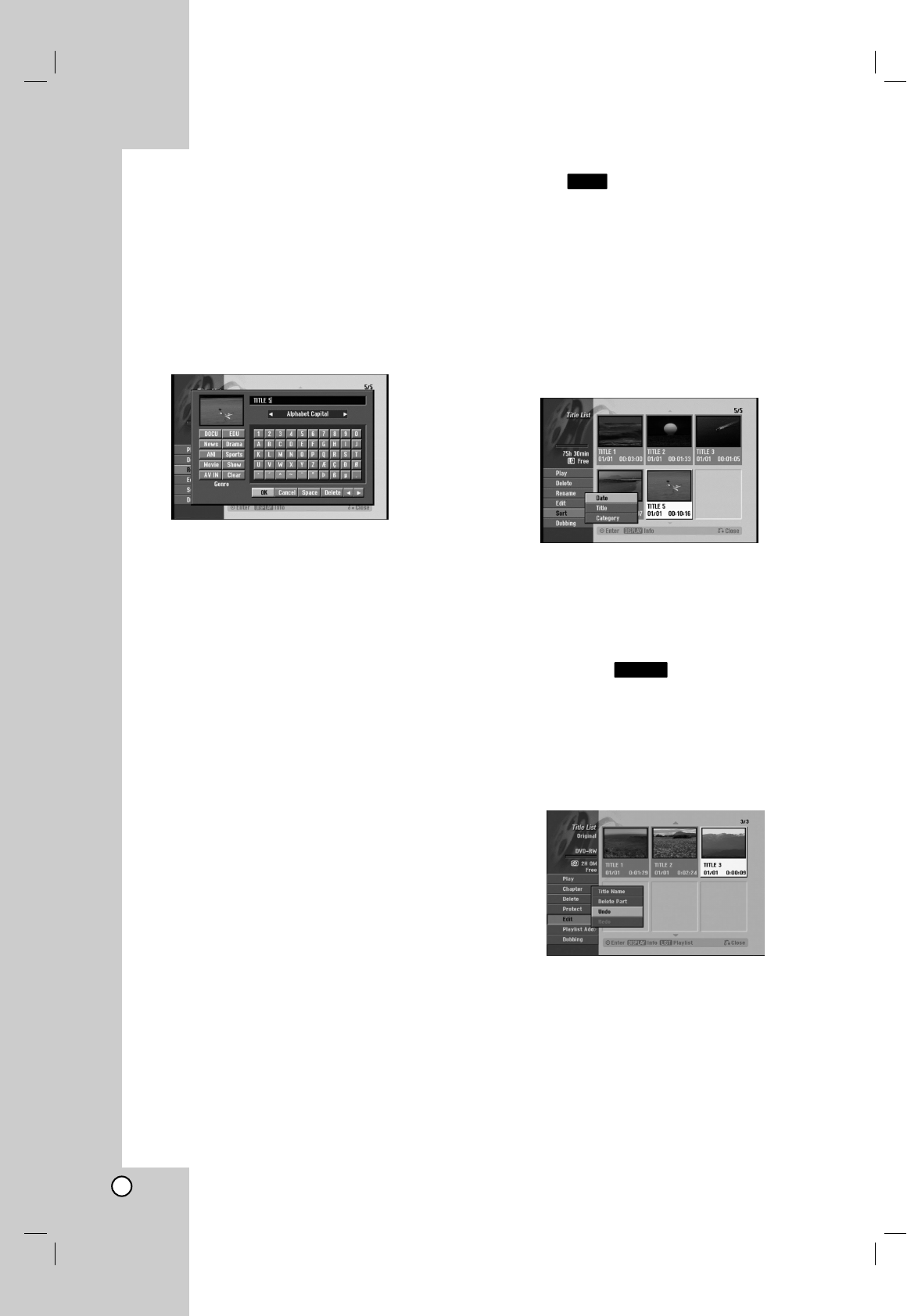
48
Naming a T
Naming a Title
itle
You can name Original and Playlist titles independently.
Names can be up to 32 characters long.
1. Choose the title you want to name on the Title List
menu, then press ENTER.
The menu options appears on the left side of the
menu.
2. Use v/Vto select [Rename (Title Name)] option
then press ENTER.
Keyboard menu appears.
3. Enter a name for the title. Use b/ B/ v/ Vto
select a character then press ENTER to confirm
your selection.
Use MENU/LIST button to change keyboard
type.
OK: Select to finish.
Cancel: Cancels all entered characters.
Space: Inserts a space at the cursor position.
Delete: Deletes the previous character at the
cursor position.
b / B:Moves cursor to left or right.
Tip:
Remote control buttons for entering a name
N(PLAY): Inserts a space at the cursor position.
X(PAUSE/STEP): Deletes the after character at
the cursor position.
x(STOP), CLEAR: Deletes the previous
character at the cursor position.
./ >:Moves cursor to left or right.
Numbers (0-9): Enters the corresponding
character at the cursor position.
Note:
You can add the genre only for HDD title name.
4. Choose [OK] then press ENTER to fix the name
and return to the previous menu screen.
5. Press RETURN (O) repeatedly to exit the menu.
Notes:
•Names can be up to 32 characters long.
•For discs formatted on a different recorder, you will
see only a limited character set.
•When recording on DVD-R, DVD+R or DVD+RW
discs, the entered name is displayed on the DVD
player only after finalization.
Sort
Sort
This function allows you to access show listings
organized by Date, Title, or Category on the Title List-
HDD menu. So you can find title you want to watch
easily.
1. Choose any title on the Title List-HDD menu, then
press ENTER.
The menu options appears on the left side of the
menu.
2. Use v/Vto select [Sort] option then press ENTER.
Sort options appears.
3. Use v/ Vto select [Date], [Title] or [Category]
option then press ENTER.
After pressing ENTER, the sorted menu is
displayed.
Undoing/Redoing the Last
Undoing/Redoing the Last
Deletion
Deletion
If you make a mistake while deleting, you can undo it.
There is one level of undo (in other words, you can
undo the last one deletion you made).
Use v / Vto select [Undo] option then press ENTER.
It doesn’t matter whether you are currently in the
menu screen; the last deletion is undone.
Notes:
•You can’t undo a recording.
•
You can’t undo anything after ejecting the disc from
the recorder or switching the recorder into standby
mode.
•You can still undo a deletion even after exiting the
menu display.
Tip:
You can redo the last undo action using the [Redo]
option.
-RWVR
HDD
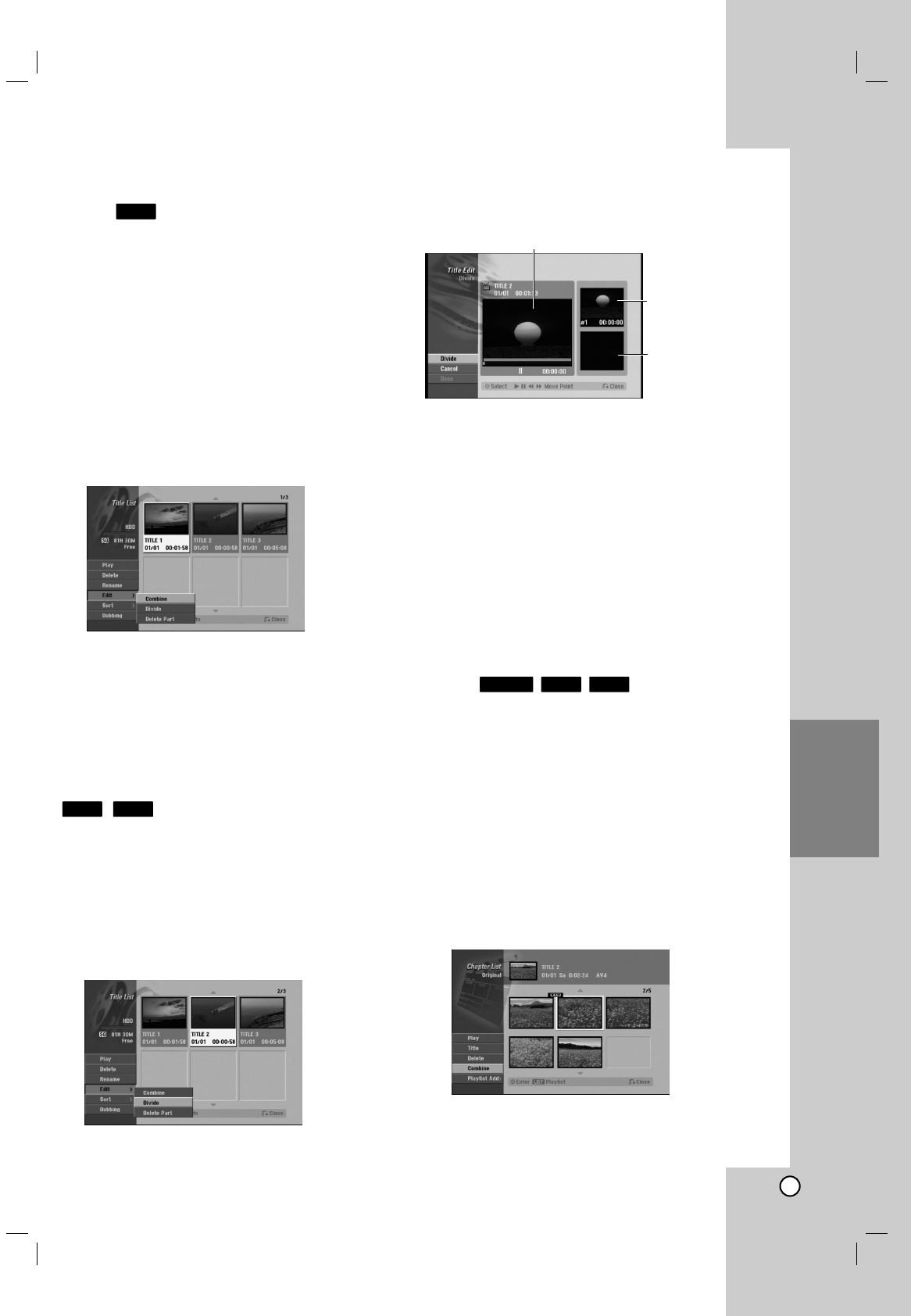
49
Editing
Combining T
Combining Two T
wo Titles Into
itles Into
One
One
Use this function to combine two adjacent Original-
HDD titles into one.
Notes:
•This function is not available if there is only one
titles within the HDD.
•If there are more than 60 titles on the HDD, you
cannot combine the titles.
1. On the Title List-HDD menu, select the first title of
the two titles you want to combine then press
ENTER.
The menu options appears on the left side of the
screen.
2. Select [Combine] option then press ENTER.
3. Select the second title of the two titles you want to
combine then press ENTER.
Confirm message appears.
4. Use b/ Bto select [Yes] then press ENTER.
After pressing ENTER, the updated menu is
displayed.
Divide One T
Divide One Titles Into T
itles Into Two
wo
Use this command to split a title up into two new titles.
1. On the Title List menu, select a title you want to
divide then press ENTER.
The menu options appears on the left side of the
screen.
2. Select [Divide] option.
Example: Title List (HDD)
3. Press ENTER.
Title Edit (Divide) menu appears. [Divide] option is
highlighted.
4. Use play, pause step, search and slow-motion to
find the point you want to divide the title.
5. Select [Divide] option then press ENTER at the
point.
To reset the point, select [Cancel] option then
press ENTER. Repeat from step 3.
6. Choose [Done] option then press ENTER to fix the
dividing point.
The title is divided into two new titles. It take up to
4 minutes to divide.
Note:
You cannot select dividing point less than 3 seconds.
Combining T
Combining Two Chapters Into
wo Chapters Into
One
One
Use this function to combine two adjacent Playlist or
Original chapters into one.
Note:
This function is not available if there is only one
chapter within the title.
1. On the Chapter List menu, select the second
chapter of the two chapters you want to combine
then press ENTER
The menu options appears on the left side of the
screen.
2. Use v/ Vto select [Combine] option.
The combine indicator appears between the two
chapters you want to combine.
3. Press ENTER.
+R+RW-RWVR
+RWHDD
HDD
The first title’s
thumbnail
Current picture
The second title’s
thumbnail
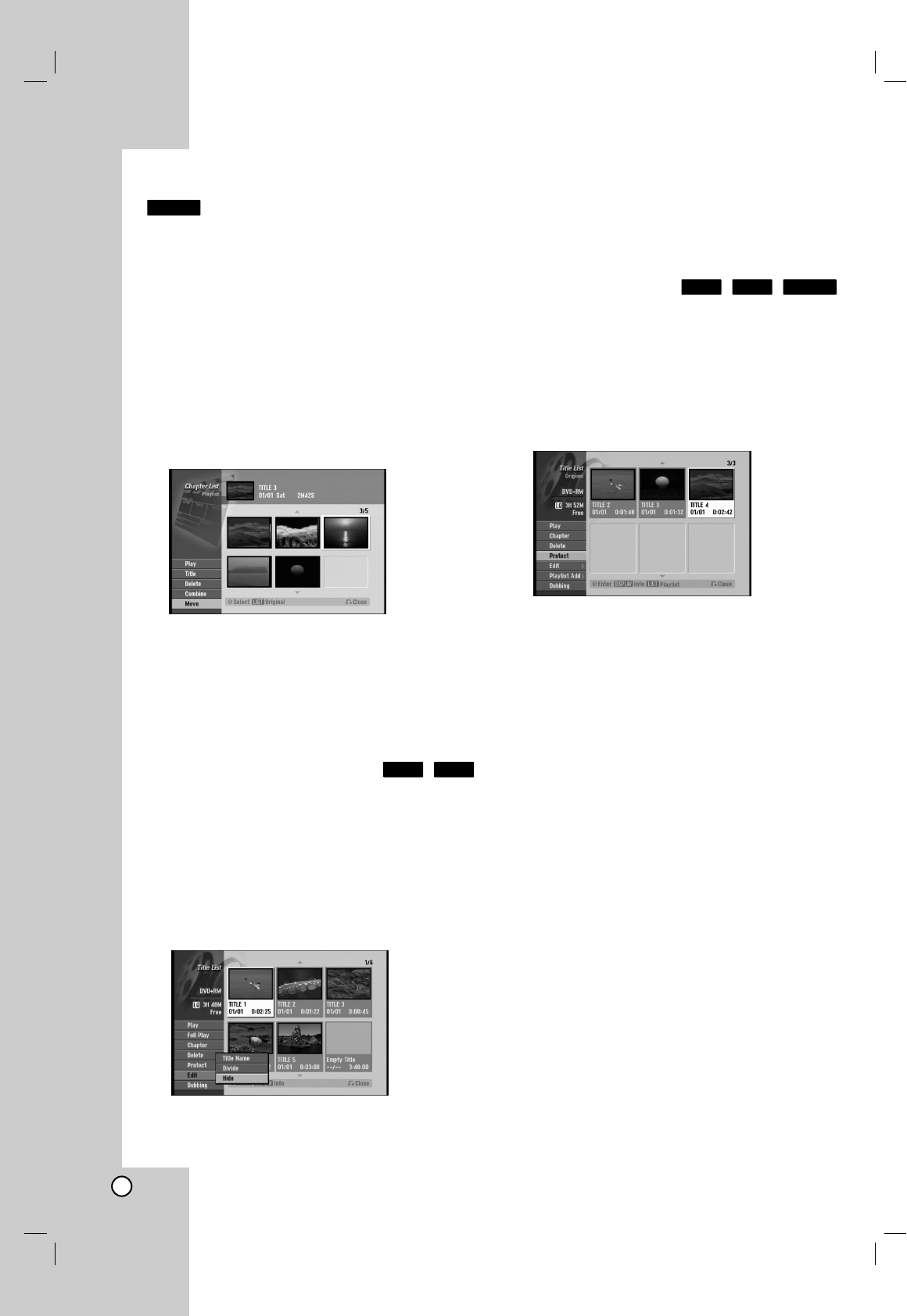
50
Moving a Playlist Chapter
Moving a Playlist Chapter
Use this function to re-arrange the playing order of
Playlist chapters on the Title List-Playlist menu.
Note:
This function is not available if there is only one
chapter.
1. Select a chapter on the Chapter List-Playlist menu.
2. Press ENTER.
The menu options appears on the left side of the
menu.
3. Use v/ Vto select [Move] option from Playlist
options then press ENTER.
4. Use b/ B/ v/ Vto choose the place you want to
move the chapter to then press ENTER.
Confirm message appears.
5. Use b/ Bto select [Yes] then press ENTER.
After pressing ENTER, the updated menu is
displayed.
Hide a Chapter/T
Hide a Chapter/Title
itle
You can skip playing chapters or titles without deleting
from the disc.
1. Use vVbBto choose a chapter or title you want
to hide on the Title List or Chapter List menu, then
press ENTER.
Options appear on the left side of the screen.
2. Select [Hide] option.
Example: Title List (DVD+RW)
3. Press ENTER to confirm.
The chapter’s or title’s thumbnail will dim.
Tip:
If you select a hidden chapter or title on the Title List
or Chapter List menu, you can ‘show’ it by choosing
[Show] option on the menu. After doing that, you are
able to see the chapter or title.
Protect a T
Protect a Title
itle
Use this function to protect against accidental
recording, editing or deleting of the title.
1. Press MENU/LIST to display the Title List menu.
2. Use vVbBto choose a title you want to protect
then press ENTER.
Options appear on the left side of the screen.
3. Select [Protect] from the options.
4. Press ENTER to confirm.
The lock mark will appears on the title’s thumbnail.
Tip:
If you select a title that has already been protected on
the Title List menu, you can ‘unprotect’ it by choosing
[Protect] option from the Title List menu options. After
doing that, you can edit and delete the title.
-RWVR
+R+RW
+R+RW
-RWVR

51
Dubbing
Dubbing
Before Dubbing
Before Dubbing
Use the copying features of this recorder to:
Back up important recordings stored on the HDD to
a DVD.
Make a DVD copy of a recording on the HDD to
play in another player.
Transfer video from a DVD to the HDD for editing.
Transfer edited video from the HDD to DVD.
The simplest method of copying is to use the One
Touch Copy feature. Using this you can very simply
copy the title that’s currently playing from HDD to
DVD, or the other way around.
Note:
If the title’s length is less than 5 seconds, the dubbing
is not available. (from HDD to DVD)
Restrictions on copying
Some video material is copy-once protected. This
means that it can be recorded to HDD, but it cannot
then be freely copied again. If you want to transfer
copy-once protected material from HDD to DVD, you’ll
need to use a VR mode DVD-RW disc compatible
with CPRM Ver. 1.1, and the following restrictions
apply:
After copying a copy-once protected title to DVD it is
automatically erased from the HDD. It is not therefore
possible to copy a locked title that is copy-once
protected.
You can identify copy-once protected material during
playback by displaying disc information on-screen.
Amedia in NTSC format cannot be copied.
What is ‘CPRM’?
CPRM is a copy protection system (with scramble
system) only allowing the recording of ‘copy once’
broadcast programs. CPRM stands for Content
Protection for Recordable Media.
This Recorder is CPRM compatible, which means that
you can record copy-once broadcast programs, but
you cannot then make a copy of those recordings.
CPRM recordings can only be made on DVD-RW
discs formatted in VR mode, and CPRM recordings
can only be played on players that are specifically
compatible with CPRM.
Copyright
Recording equipment should be used only for lawful
copying and you are advised to check carefully what
is lawful copying in the area in which you are
making a copy. Copying of copyright material such
as films or music is unlawful unless permitted by a
legal exception or consented to by the rights owner.
This product incorporates copyright protection
technology that is protected by method claims of
certain U.S. patents and other intellectual property
rights owned by Macrovision Corporation and other
rights owners. Use of this copyright protection
technology must be authorized by Macrovision
Corporation, and is intended for home and other
limited viewing uses only, unless otherwise
authorized by Macrovision corporation. Reverse
engineering or disassembly is prohibited.
Notice for Progressive Scan Use
CONSUMERS SHOULD NOTE THAT NOT ALL HIGH
DEFINITION TELEVISION SETS ARE FULLY
COMPATIBLE WITH THIS PRODUCT AND MAY
CAUSE ARTIFACTS TO BE DISPLAYED IN THE
PICTURE. IN CASE OF 525 PROGRESSIVE SCAN
PICTURE PROBLEMS, IT IS RECOMMENDED THAT
THE USER SWITCH THE CONNECTION TO THE
‘STANDARD DEFINITION’ OUTPUT. IF THERE ARE
QUESTIONS REGARDING OUR TV SET
COMPATIBILITY WITH THIS MODEL 525p HDD/DVD
RECORDER, PLEASE CONTACT OUR CUSTOMER
SERVICE CENTER.
Fast copying
Copying between DVD and HDD is a completely
digital process and therefore involves no loss of
quality in the audio or video. This means that you can
transfer back and forth without having to worry about
the quality getting worse with each copy ‘generation’.
It also means that copying can be carried out at the
maximum speed possible.
When copying from HDD to DVD, the speed of
copying depends on the recording mode and the kind
of DVD disc you’re using.
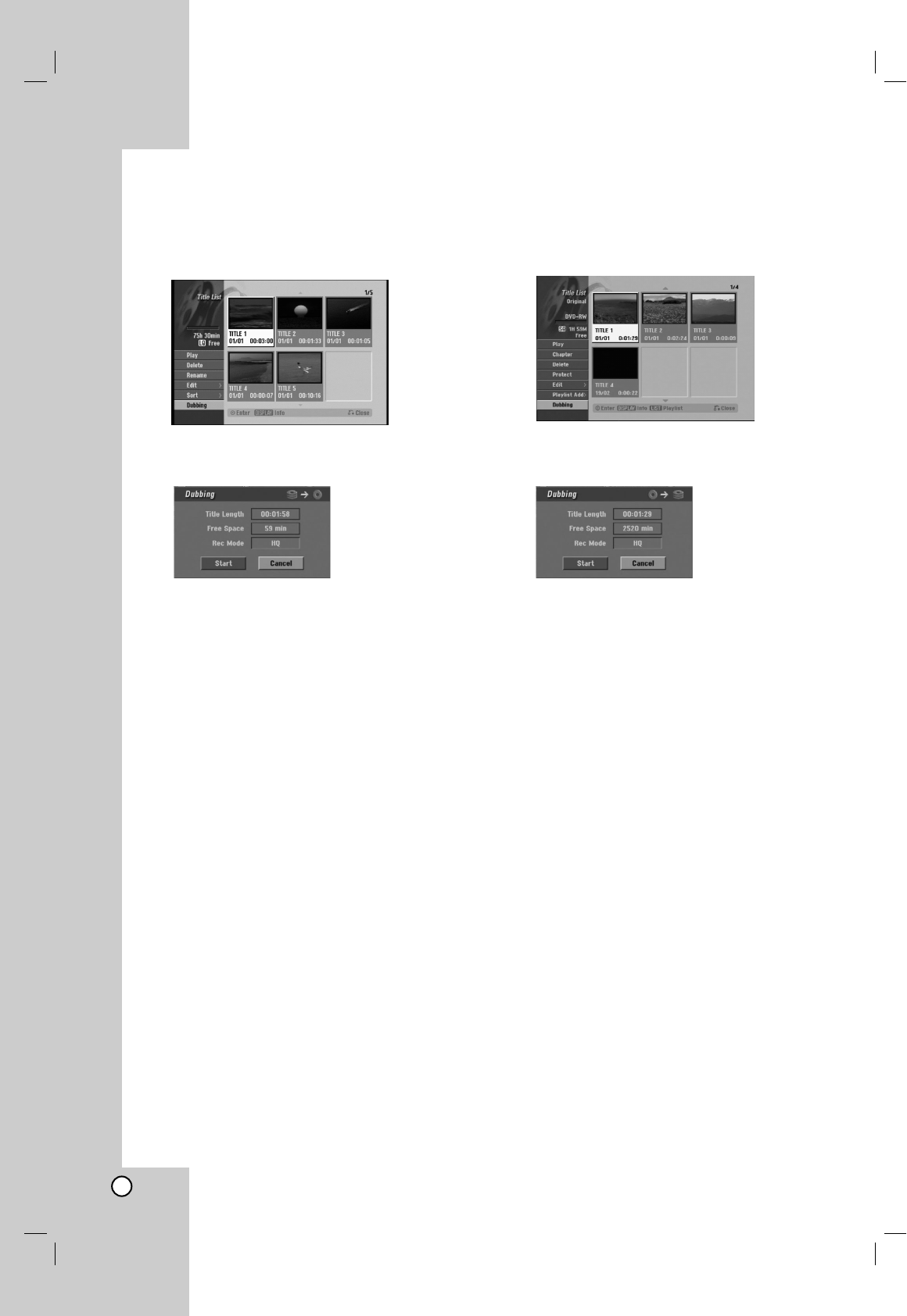
52
Dubbing from HDD to DVD
Dubbing from HDD to DVD
1. On the Title List-HDD menu, select a title you want
to dub then press ENTER.
The menu options appears on the left side of the
screen.
2. Use v/ Vto select [Dubbing] option then press
ENTER.
Dubbing menu appears.
3. Use b/ Bto select record mode (HQ, SQ, LQ,
EQ, or Fast), then press V.
‘Start’ icon is highlighted.
Fast: See page 51 for more information on Fast
copying.
4. When [Start] icon is highlighted, press ENTER.
Dubbing starts.
5. To stop dubbing at any other time, press
STOP (x).
Notes:
•The recording time of [Fast] mode could be varied
depending on data size of source.
Approximated Time (Example: 4x DVD disc):
– 1 hour contents of LQ: 5-6 minutes
– 1 hour contents of HQ: 12-15 minutes
•Stopping dubbing in [Fast] mode partway through
will cancel the recording and any data recorded up
to that point will be lost.
•If the remaining space on the disc is insufficient,
the [Fast] mode is not available.
•The [Fast] mode is not available for edited HDD
title.
Dubbing from DVD to HDD
Dubbing from DVD to HDD
1. On the Title List menu, select a title you want to
dub then press ENTER.
Menu options appears on the left side of the
screen.
2. Use v/ Vto select [Dubbing] option then press
ENTER.
Dubbing menu appears.
3. Use b/ Bto select record mode (HQ, SQ, LQ,
EQ, or Fast), then press V.
[Start] icon is highlighted.
Fast: Only available when copying VR mode disc
to HDD. (See page 51 for more information on
Fast copying.)
4. When [Start] icon is highlighted, press ENTER.
Dubbing starts.
5. To stop dubbing at any other time, press
STOP (x).
Notes:
•Depending on the conditions of the recording
equipment or the disc itself, the dubbing may not
be capable.
•Stopping dubbing in [Fast] mode partway through
will cancel the recording and any data recorded up
to that point will be lost.
•The recording time of [Fast] mode can take up to
19 minutes.
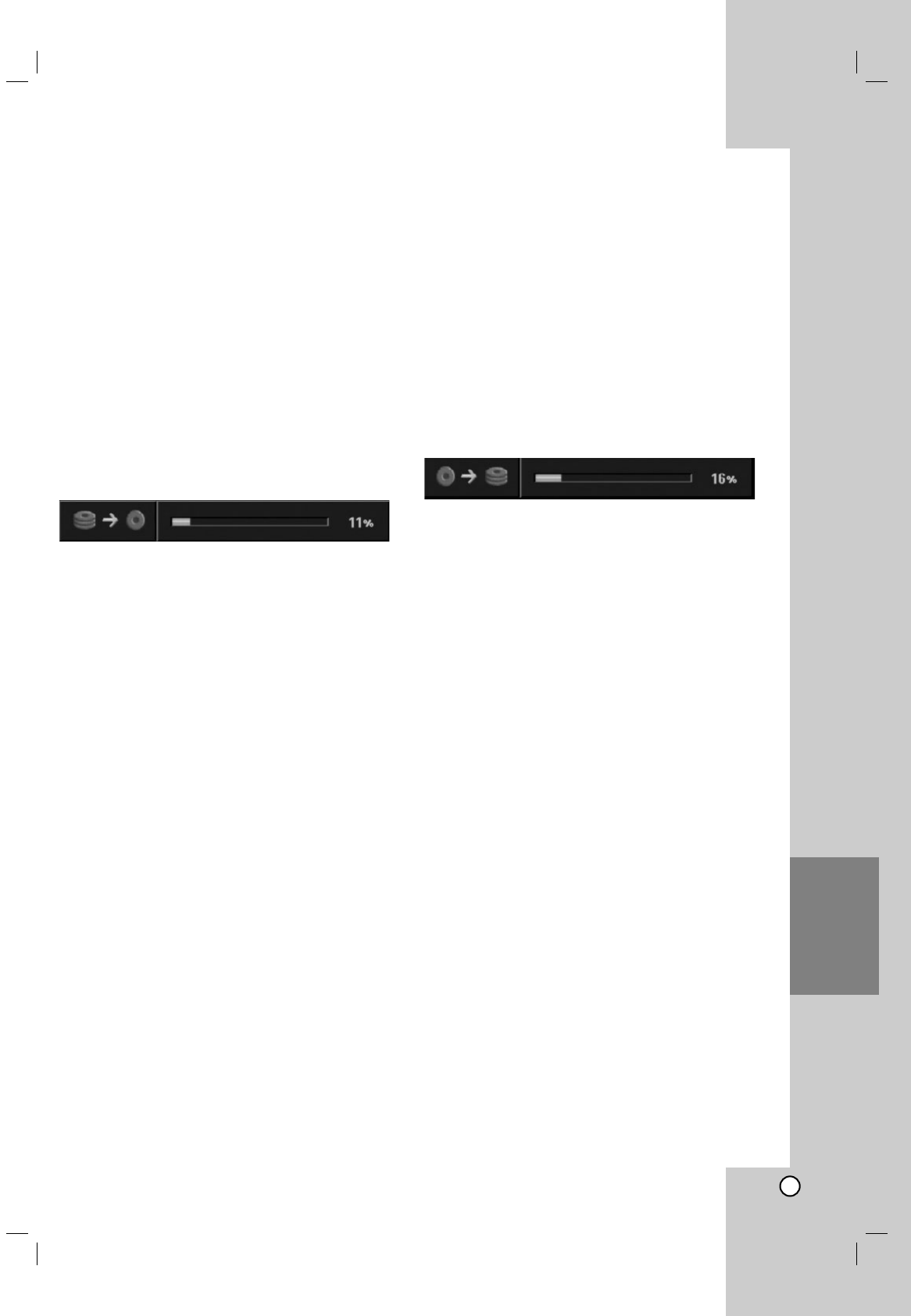
53
Dubbing
One T
One Touch Copy
ouch Copy
(HDD to DVD)
(HDD to DVD)
The One Touch Copy feature copies the currently
playing title from the HDD to DVD. The whole title is
copied, regardless of where in the title you start
copying. The recorder copies at the maximum speed
possible.
For One Touch Copy to work, make sure that a
recordable DVD disc is loaded.
During HDD playback, press DUBBING to copy the
current title to DVD.
The on-screen display indicates that the title is being
copied. Playback continues while copying.
You cannot use the One Touch Copy function to
copy a title if any part of the title is copy-once
protected.
One T
One Touch Copy
ouch Copy
(DVD to HDD)
(DVD to HDD)
One Touch Copy from DVD to HDD copies a single
title to the HDD in real time. When you start copying,
playback jumps back to the start of the title, then
continues through to the end of the title, when
recording automatically stops. The copy will be made
in the recording mode (HQ, SQ, LQ, EQ) that is
currently set.
During DVD playback, press DUBBING to copy the
current title to HDD.
Playback starts again from the beginning of the
current title. The on-screen display indicates that the
title is being copied.
Notes:
•Video CD cannot be copied to HDD.
•The copying stops when then recorder detects a
badly scratched or copy protected part.
•If some part of the title being copied is copy-
protected, copying will start, but the copy-
protected portions will not be copied.
•During Playlist title’s playback, One Touch Copy is
not available.
Tip:
To stop dubbing at any other time, press STOP (x).
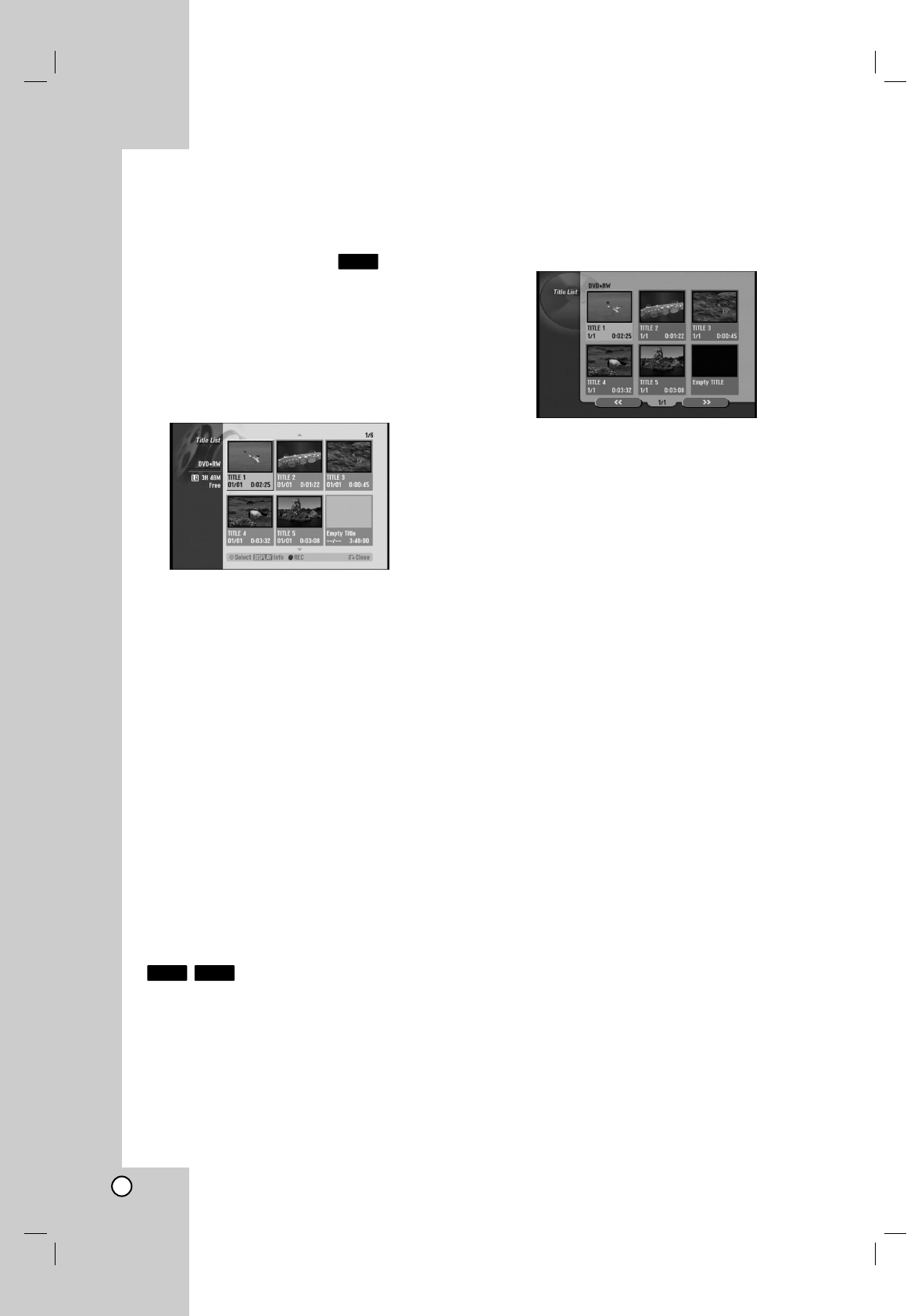
54
Reference
Additional Information
Additional Information
Overwriting Recording
To overwrite a new video recording on a previously
recorded title, follow these steps. This feature is not
available for DVD+Rs, that always record at the end
of the Disc.
1. Select input source you want to record (TV
channel, AV1-4, DV).
2. Press MENU/LIST to display the Title List menu.
3. Use vVbBto choose a title you want to
overwrite.
4. Press REC (z) to start overwrite recording.
Overwrite recording starts from the start point of
the title.
5. Press STOP (x) to stop the overwrite recording.
The new title is created and updated menu is
displayed.
Notes:
•This function is not available for a protected title.
•If the overwrite is longer than the recording
length of the current title, the next title is
overwritten. But if next title is protected, the
overwriting stops at the starting point of the
title.
•If the selected title’s recording length is less than
10 seconds, the next title is overwritten. But if the
next title is protected, overwriting stops.
Viewing Title List menu displayed on
other DVD Recorders or Players
You can view the Title List menu displayed on the
other DVD player that is capable of playing DVD+RW
or DVD+R discs.
1. Insert DVD+R or DVD+RW disc recorded already.
2. Press TITLE in Play mode.
Title List menu will appear as shown below.
Tip:
You can remove the Title List menu by pressing
STOP (x).
3. To play back a title, select the title you want then
press ENTER or N(PLAY).
Playing Your Recordings on Other DVD
Players (Finalizing a Disc)
Most regular DVD players can play finalized discs
recorded in Video mode, finalized DVD+R or
DVD+RWs. A small number of players can also play
DVD-RW discs recorded in VR mode, finalized or not.
Check the manual that came with the other player to
check what formats of discs it will play.
Finalizing ‘fixes’ the recordings and editings in place
so that the disc can be played on a regular DVD
player or computer equipped with a suitable DVD-
ROM drive.
Finalizing a Video mode disc creates a menu screen
for navigating the disc. The menu can be accessed by
pressing MENU/LIST or TITLE.
To finalize a disc, refer to “Finalize”on page 23.
Notes:
•Unfinalized DVD+RW is playable on regular DVD
players.
•The edited contents of a DVD+RW disc is
compatible on regular DVD players only after
finalization.
•Any edited contents of the DVD+R disc are not
compatible on regular DVD players. (Hide, chapter
combine, added chapter mark, etc.)
•How long finalization takes depends on the type of
disc, how much is recorded on the disc, and the
number of titles on the disc.
•DVD+R DL disc can take up to 30 minutes to
finalize.
+R+RW
+RW
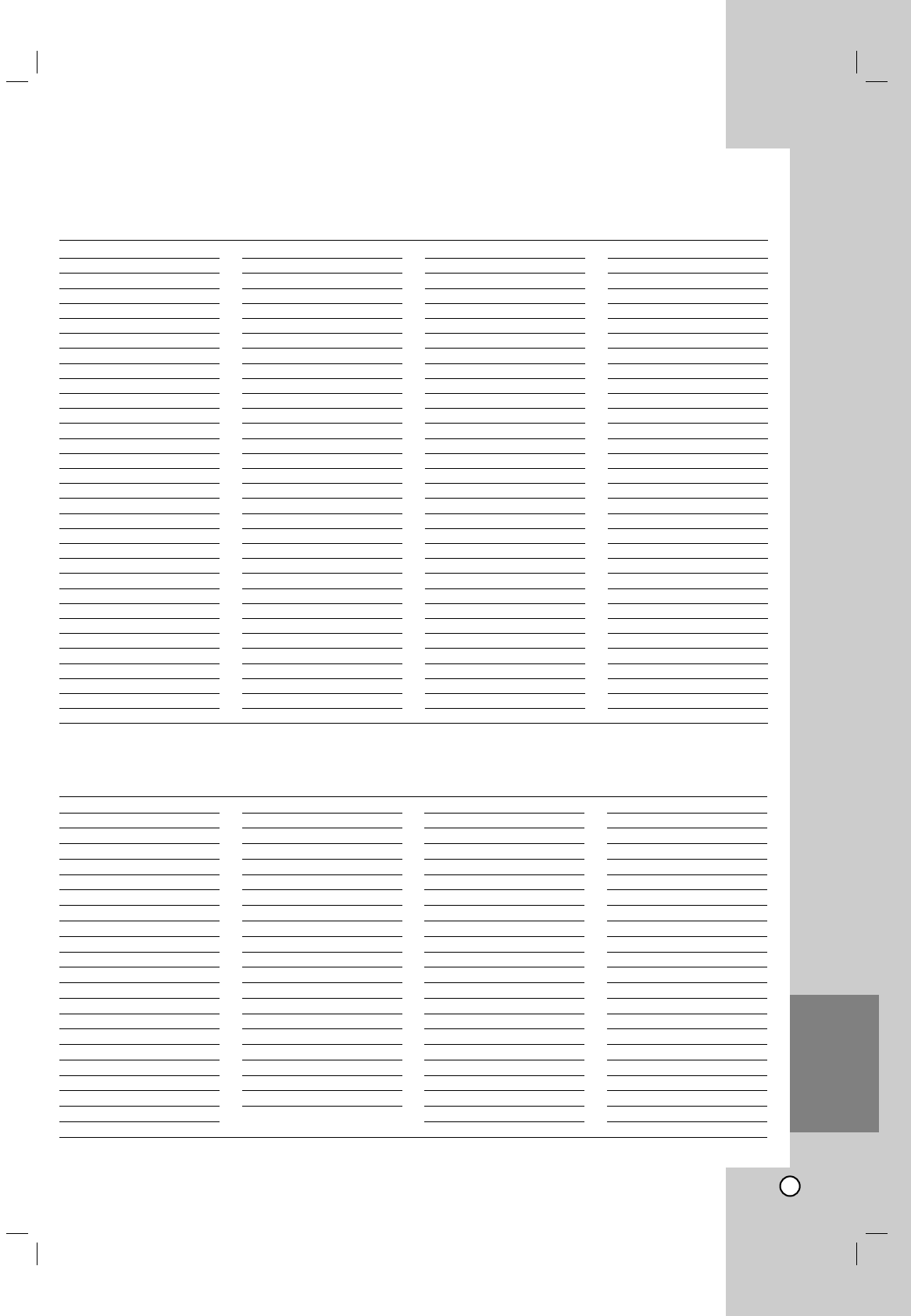
55
Reference
Area Code
Afghanistan AF
Argentina AR
Australia AU
Austria AT
Belgium BE
Bhutan BT
Bolivia BO
Brazil BR
Cambodia KH
Canada CA
Chile CL
China CN
Colombia CO
Congo CG
Costa Rica CR
Croatia HR
Czech Republic CZ
Denmark DK
Ecuador EC
Egypt EG
El Salvador SV
Area Code
Ethiopia ET
Fiji FJ
Finland FI
France FR
Germany DE
Great Britain GB
Greece GR
Greenland GL
Islands HM
Hungary HU
India IN
Indonesia ID
Israel IL
Italy IT
Jamaica JM
Japan JP
Kenya KE
Kuwait KW
Libya LY
Luxembourg LU
Area Code
Malaysia MY
Maldives MV
Mexico MX
Monaco MC
Mongolia MN
Morocco MA
Nepal NP
Netherlands NL
Netherlands Antilles AN
New Zealand NZ
Nigeria NG
Norway NO
Oman OM
Pakistan PK
Panama PA
Paraguay PY
Philippines PH
Poland PL
Portugal PT
Romania RO
Russian Federation RU
Area Code
Saudi Arabia SA
Senegal SN
Singapore SG
Slovak Republic SK
Slovenia SI
South Africa ZA
South Korea KR
Spain ES
Sri Lanka LK
Sweden SE
Switzerland CH
Thailand TH
Turkey TR
Uganda UG
Ukraine UA
United States US
Uruguay UY
Uzbekistan UZ
Vietnam VN
Zimbabwe ZW
Area Codes
Area Codes
Choose an area code from this list.
Language Code
Abkhazian 6566
Afar 6565
Afrikaans 6570
Albanian 8381
Ameharic 6577
Arabic 6582
Armenian 7289
Assamese 6583
Aymara 6588
Azerbaijani 6590
Bashkir 6665
Basque 6985
Bengali; Bangla 6678
Bhutani 6890
Bihari 6672
Breton 6682
Bulgarian 6671
Burmese 7789
Byelorussian 6669
Cambodian 7577
Catalan 6765
Chinese 9072
Corsican 6779
Croatian 7282
Czech 6783
Danish 6865
Dutch 7876
English 6978
Esperanto 6979
Estonian 6984
Faroese 7079
Language Code
Fiji 7074
Finnish 7073
French 7082
Frisian 7089
Galician 7176
Georgian 7565
German 6869
Greek 6976
Greenlandic 7576
Guarani 7178
Gujarati 7185
Hausa 7265
Hebrew 7387
Hindi 7273
Hungarian 7285
Icelandic 7383
Indonesian 7378
Interlingua 7365
Irish 7165
Italian 7384
Japanese 7465
Javanese 7487
Kannada 7578
Kashmiri 7583
Kazakh 7575
Kirghiz 7589
Korean 7579
Kurdish 7585
Laothian 7679
Latin 7665
Latvian, Lettish 7686
Language Code
Lingala 7678
Lithuanian 7684
Macedonian 7775
Malagasy 7771
Malay 7783
Malayalam 7776
Maltese 7784
Maori 7773
Marathi 7782
Moldavian 7779
Mongolian 7778
Nauru 7865
Nepali 7869
Norwegian 7879
Oriya 7982
Panjabi 8065
Pashto, Pushto 8083
Persian 7065
Polish 8076
Portuguese 8084
Quechua 8185
Rhaeto-Romance 8277
Rumanian 8279
Russian 8285
Samoan 8377
Sanskrit 8365
Scots Gaelic 7168
Serbian 8382
Serbo-Croatian 8372
Shona 8378
Sindhi 8368
Language Code
Singhalese 8373
Slovak 8375
Slovenian 8376
Somali 8379
Spanish 6983
Sudanese 8385
Swahili 8387
Swedish 8386
Tagalog 8476
Tajik 8471
Tamil 8465
Tatar 8484
Telugu 8469
Thai 8472
Tibetan 6679
Tigrinya 8473
Tonga 8479
Turkish 8482
Turkmen 8475
Twi 8487
Ukrainian 8575
Urdu 8582
Uzbek 8590
Vietnamese 8673
Volapük 8679
Welsh 6789
Wolof 8779
Xhosa 8872
Yiddish 7473
Yoruba 8979
Zulu 9085
Language Codes
Language Codes
Use this list to input your desired language for the following initial settings:
Disc Audio, Disc Subtitle, Disc Menu.
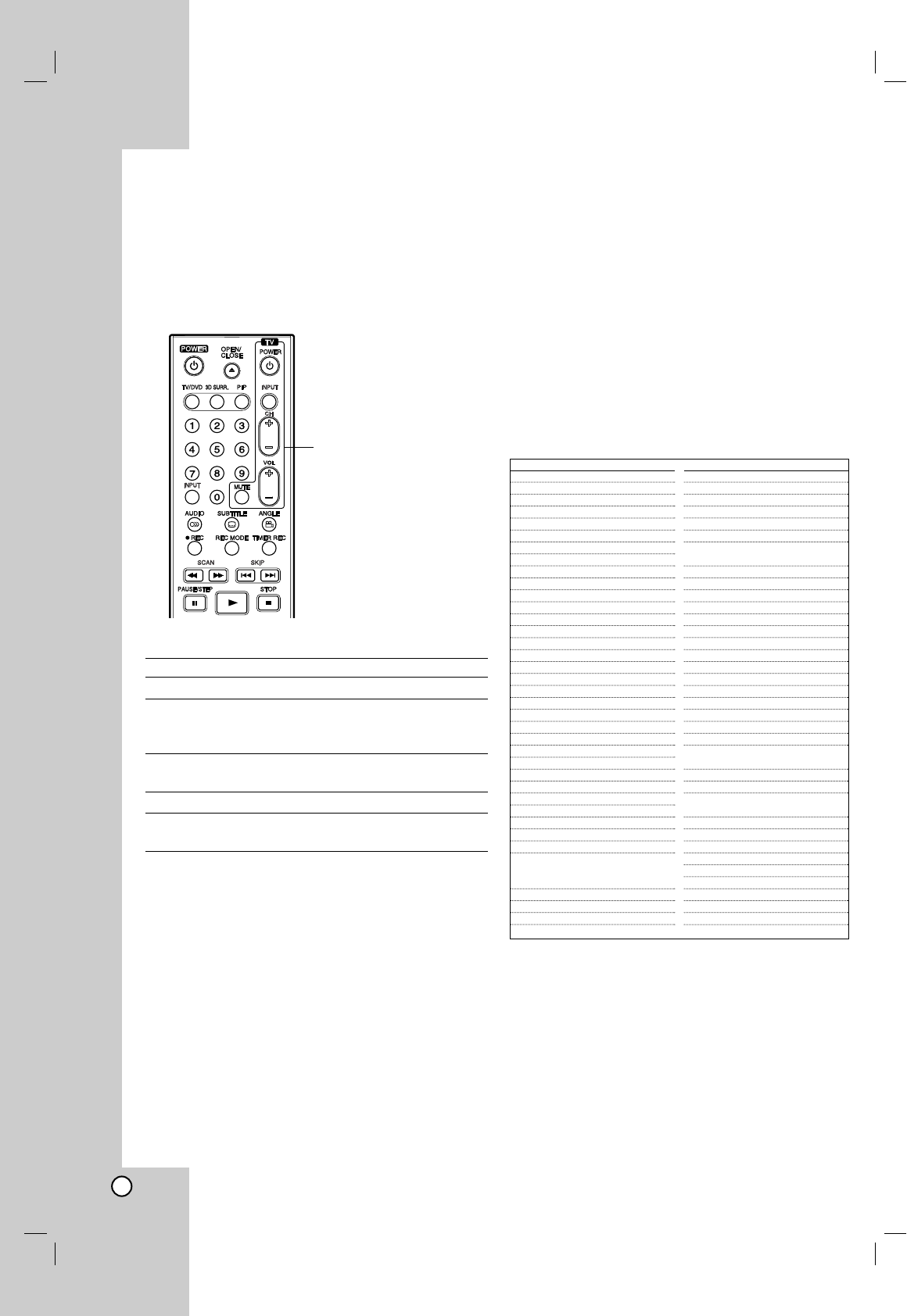
56
Controlling
Controlling Y
Your TV with the
our TV with the
Supplied Remote Control
Supplied Remote Control
You can control the sound level, input source, and
power switch of your LG TV with the supplied remote.
You can control your TV using the buttons below.
By pressing You can
POWER Turn the TV on or off.
AV Switch the TV’s input source
between the TV and other input
sources.
PR +/– Scans up or down through
memorized channels.
VOL +/– Adjust the volume of the TV.
MUTE Temporarily turns TV sound OFF,
press again to restore.
Controlling other TVs with the remote
You can control the sound level, input source, and
power switch of non-LG TVs as well. If your TV is
listed in the table below, set the appropriate
manufacturer code.
1. While holding down TV POWER button, press the
number buttons to select the manufacturer code
for your TV (see the table below).
2. Release TV POWER button.
Code numbers of controllable TVs
If more than one code number is listed, try entering
them one at a time until you find the one that works
with your TV.
Notes:
•Depending on your TV, some or all buttons
may not function on the TV, even after entering
the correct manufacturer code.
•If you enter a new code number, the code number
previously entered will be erased.
•When you replace the batteries of the remote, the
code number you have set may be reset to the
default setting. Set the appropriate code number
again.
TV Control
Buttons
Manufacturer Code Number
ADMIRAL 16,33,37,44,45
AIWA 70
AKAI 01
AMARK 09
AOC 01
BELL & HOWELL 33
BROKSONIC 18,19
CANDLE 51
CCE 07
CENTURION 08
CINERAL 43
CITIZEN 49,50,51,52,53,54,55
CORONADO 09
CROWN 09
CURTIS MATHES 01,03,08,33,35,37,44
DAEWOO 16,38,39,40,41,42,43
DAYTRON 01,08
EMERSON 01,09,16,17,18,19
FISHER 28,29
FUNAI 46,47
GENERAL ELECTRIC 03,10,11,13,37,44
GRADIENTE 01,56,57,63,67
HITACHI 09,14,15,43
JC PENNEY 01,08,10,27,35
JVC 20,21,63,67
KIOTE 43
KMC 09
KTV 01,08,09,31
LG (GOLDSTAR) 01,07,08,09,35,39,40
LODGENET 33
LOGIK 33
LXI 09,24,25,26,27,28,29
MAGNAVOX 01,02,04,05,06,
07,08,09,20,
34,35,43,51,61,62,65
MAJESTIC 33
MARANTZ 01,32
MEMOREX 33
MGA/MITSUBISHI 01,08,32,34
Manufacturer Code Number
MONTGOMERY
01,06,08,09
WARD
23,24,32,33,34
NEC 01,08
NOBLEX 07
PACKARD BELL 43
PANASONIC 07,11,13,25,35,36
PHILCO 01,06,07,08,09,
15,38,43,58
PHILIPS 06,07,43,61,62,65
PIONEER 30
PORTLAND 09
PROSCAN 03,37,44
QUASAR 11,13
RADIO SHACK 16,17,23
RCA 01,03,37,44,69
REALISTIC 16,17,23
SAMPO 08
SAMSUNG 01,08,09,25,68
SANYO 28,29
SCOTT 01,08
SEARS 09,25,26,27,28,29
SEMP 64
SHARP 09,22,23,24,60,66
SIGNATURE 2000 01,06,08,09,10,
23,24,33,34
SONY 12,62
SOUNDESIGN 51
SYLVANIA 01,04,05,06,07,
08,35,51
SYMPHONIC 46,47
TATUNG 11
TEKNIKA 07,09,16,33,51
TELERENT 09,33
THOMSON 69
YORX 08
TOSHIBA 01,25,26,27,64
WARDS 01,06,08,09,10,33,34
XR1000 48
ZENITH 01, 02,33,59
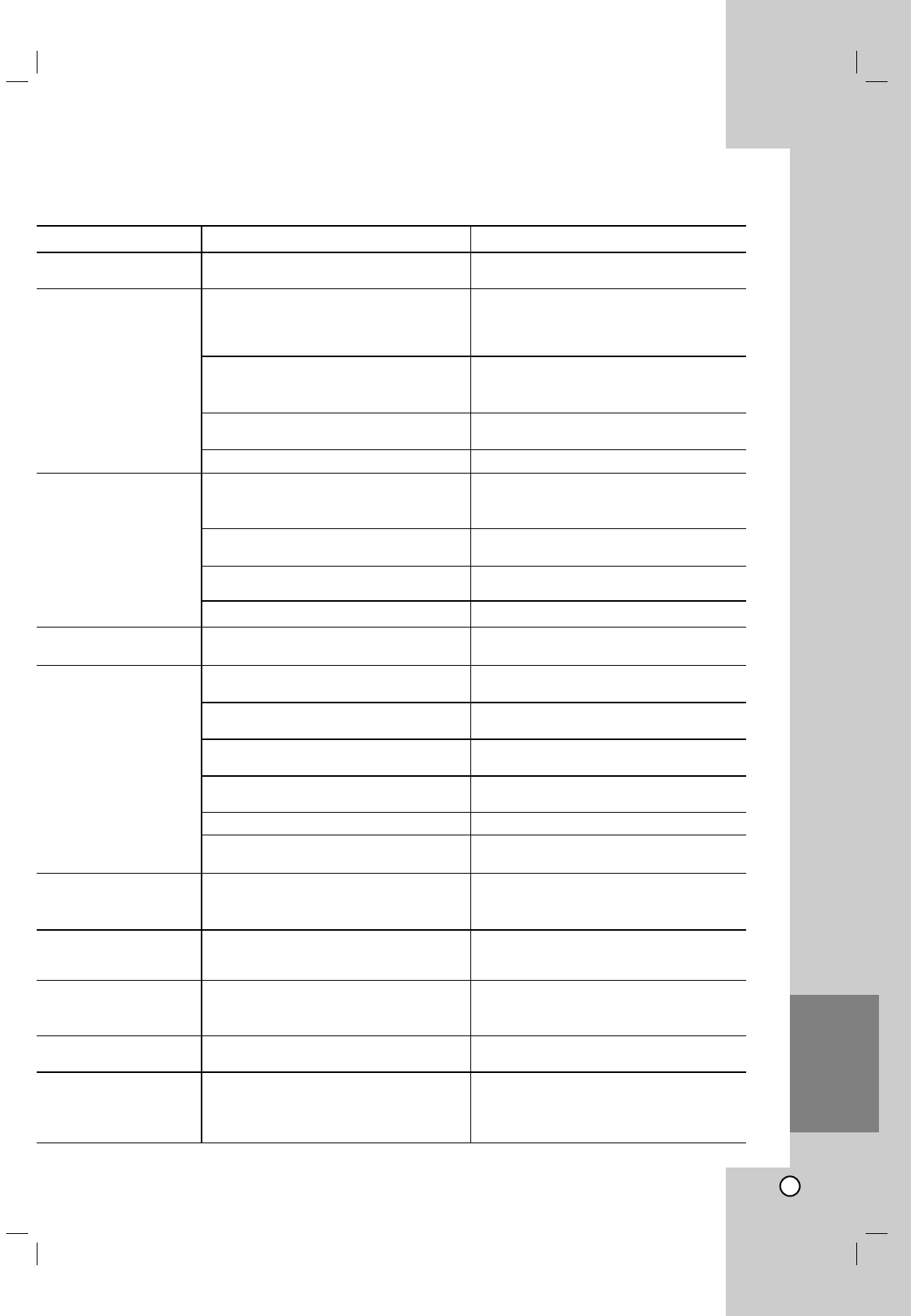
57
Reference
Symptom
No power.
No picture.
No sound.
The playback picture is
poor.
The recorder does not
start playback.
The picture from the
external input is
distorted
Some channels are
skipped over when
using v/ V.
The picture or sound of
broadcasting channel is
weak or missing.
Camcorder image is not
shown.
Camcorder image via
A/V input or DV IN to
recorder is not shown
on TV screen.
Cause
The power cord is disconnected.
TV/DVD mode for the recorder is set
to TV.
The TV is not set to receive recorder
signal output.
The video cable is not connected
securely.
The connected TV power is turned off.
The equipment connected with the
audio cable is not set to receive
recorder signal output.
The audio cables are not connected
securely.
The power of the equipment connected
with the audio cable is turned off.
The audio connecting cord is damaged.
The disc is dirty.
No disc is inserted.
An unplayable disc is inserted.
The disc is placed upside down.
The disc is not placed within the
guide.
The disc is dirty.
The Rating level is set.
The video signal from the external
component is copy-protected.
Those channels are not stored in the
recorder.
Antenna or cables are loose.
Camcorder is off.
The recorder’s source is incorrect.
Solution
Plug the power cord into the wall
outlet securely.
Press TV/DVD on the remote control
repeatedly to choose DVD mode. TV
indicator disappears in the display
window.
Select the appropriate video input mode
on the TV so the picture from the
recorder appears on the TV screen.
Connect the video cable securely.
Turn on the TV.
Select the correct input mode on the
audio receiver so you can listen to the
sound from the recorder.
Connect the audio cable securely.
Turn on the equipment connected
with the audio cable.
Replace it with new one.
Clean the disc.
Insert a disc. (Check that the disc
indicator in the display window is lit.)
Insert a playable disc. (Check the disc
type, color system, and regional code.)
Place the disc with the playback side
down.
Place the disc on the disc tray
correctly inside the guide.
Clean the disc.
Cancel the Rating function or change
the rating level.
You cannot connect via this recorder.
Connect the component directly to
your TV.
Restore channels. See page 16.
Tighten connections or replace cable.
Turn camcorder on and operate
properly.
Use INPUT to select input channel
(AV1, AV2, DV, etc.)
T
Troubleshooting
roubleshooting
Check the following guide for the possible cause of a problem before contacting service.
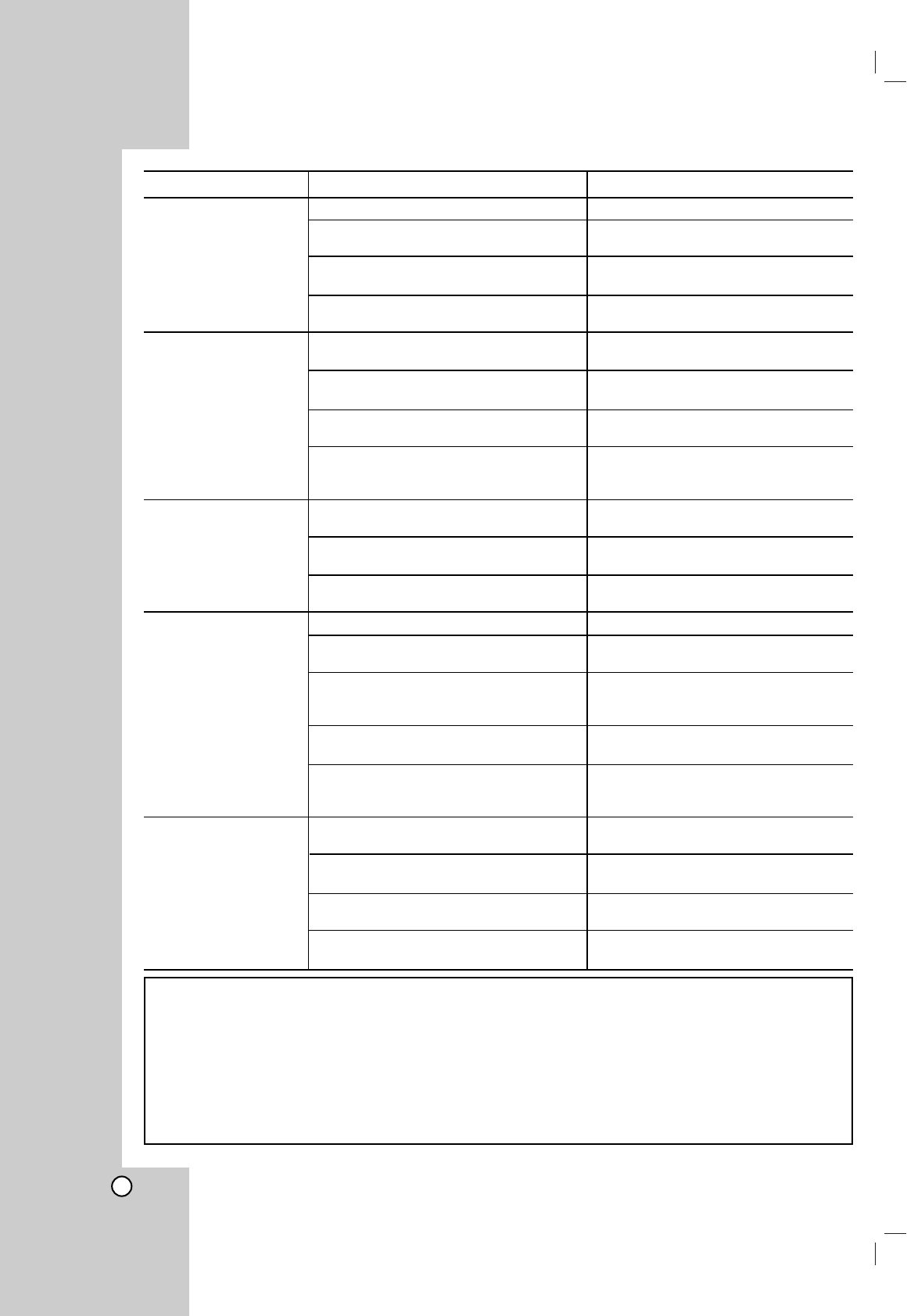
58
Symptom
Cannot play a disc
recorded using this
recorder on another
player.
Cannot record or did
not record successfully.
Timer recording is not
possible.
Stereo Audio Record
and/or Playback is not
present.
The remote control
does not work properly.
Cause
The disc was recorded in Video mode.
Some players will not play even a
finalized disc recorded in Video mode.
The disc was recorded in VR mode.
Discs recorded with copy-once material
cannot be played on other players.
The remaining blank space on the
disc is insufficient.
The source you are trying to record is
copy protected.
When setting the recording channel, the
channel is tuned on the TV’s own tuner.
When recording to a Video mode disc,
programs that are copy-once
protected cannot be recorded.
Clock in recorder is not set to correct
time.
Timer has been programmed
incorrectly.
Timer record indicator light does not
appear after programming timer.
TV is not Stereo-compatible.
Broadcast program is not in stereo
format.
The recorder A/V Out jacks are not
connected to TV A/V In jacks.
The recorder Audio/Video Out is not
selected for viewing at the TV.
The recorder’s TV audio channel is
set to mono.
The remote control is not pointed at
the remote sensor of the recorder.
The remote control is too far from the
recorder.
There is an obstacle in the path of the
remote control and the recorder.
The batteries in the remote control
are exhausted.
Solution
Finalize the disc. (page 23)
No solution.
The other player must be RW
compatible in order to play it.
No solution.
Use another disc.
You cannot record the source.
Select the channel on the recorder’s
built-in TV tuner.
Use a VR mode formatted disc for
copy-once material.
Set clock to correct time. See [Clock
Set] on page 16.
Reprogram Timer. See [Timer
Recording] on page 41.
Reprogram Timer.
No solution.
No solution.
Make A/V connections. Stereo is
available only via A/V output from the
recorder.
Select AUX or A/V source as TV
input.
Set TV audio channel mode to Stereo.
See “Changing TV audio channel” on
page 42.
Point the remote control at the remote
sensor of the recorder.
Operate the remote control within
7 m.
Remove the obstacle.
Replace the batteries with new ones.
Reset the Recorder
If you observe any of the following symptoms...
When the Recorder is plugged in, but the power
will not turn on or off.
When the display window does not working.
When the Recorder does not operate normally.
You can reset the Recorder as follows :
Press and hold the POWER button for more
than five seconds. This will force the Recorder
to power off.
Press the POWER button again to turn the
Recorder back on.
Unplug the power cord and then plug the power
cord again after more than five seconds.

59
Reference
Specifications
Specifications
General
Power requirements AC 120V, 60 Hz
Power consumption 45W
Dimensions (approx.) 430 X 49 X 350 mm (w x h x d) without foot
Mass (approx.) 4.6 kg
Operating temperature 5˚C to 35˚C
Operating humidity 5 % to 90 %
Signal system NTSC
Recording
Recording format DVD Video Recording, DVD-VIDEO
Recordable media HDD (250GB), DVD-ReWritable, DVD-Recordable, DVD+ReWritable,
DVD+Recordable, DVD+Recordable (Double Layer)
Recordable time DVD (4.7GB): Approx. 1 hour (HQ mode), 2 hours (SQ mode),
4 hours (LQ mode), 6 hours (EQ mode)
DVD+R DL (8.5GB): Approx. 3 hour (HQ mode),
3 hours 40 minutes (SQ mode),
7 hours 10 minutes (LQ mode), 10 hours 30 minutes (EQ mode)
HDD (250GB): Approx. 66 hours 30 minutes (HQ mode),
129 hours (SQ mode), 239 hours (LQ mode), 356 hours (EQ mode)
Video recording format
Sampling frequency 27MHz
Compression format MPEG 2 (VBR support)
Audio recording format
Sampling frequency 48kHz
Compression format Dolby Digital
Playback
Frequency response DVD (PCM 48 kHz): 8 Hz to 20 kHz, CD: 8 Hz to 20 kHz
DVD (PCM 96 kHz): 8 Hz to 44 kHz
Signal-to-noise ratio More than 100 dB (AUDIO OUT connector)
Harmonic distortion Less than 0.008% (AUDIO OUT connector)
Dynamic range More than 95 dB (AUDIO OUT connector)
Inputs
AERIAL IN Aerial input, 75 ohms
VIDEO IN 1.0 Vp-p 75 ohms, sync negative, RCA jack x 2 / SCART x 2
AUDIO IN 0 dBm more than 47 kohms, RCA jack (L, R) x 2 / SCART x 2
DV IN 4 pin (IEEE 1394 standard)
Outputs
VIDEO OUT 1 Vp-p 75 Ω, sync negative, RCA jack x 1 / SCART x 2
COMPONENT VIDEO OUT (Y) 1.0 V (p-p), 75 Ω, negative sync, RCA jack x 1
(PROGRESSIVE SCAN) (Pb)/(Pr) 0.7 V (p-p), 75 Ω, RCA jack x 2
Audio output (digital audio) 0.5 V (p-p), 75 Ω, RCA jack x 1
Audio output (optical audio) 3 V (p-p), 75 Ω, Optical connector x 1
Audio output (analog audio) 2.0 Vrms (1 KHz, 0 dB), 600 Ω, RCA jack (L, R) x 1 / SCART x 2
Accessory
Video cable . . . . . . . . . . . . . . . . . . . . . . . . . . . . .1 Audio cable (L, R) . . . . . . . . . . . . . . . .1
RF Coaxial Cable . . . . . . . . . . . . . . . . . . . . . . . . .1 Remote control . . . . . . . . . . . . . . . . . .1
Batteries . . . . . . . . . . . . . . . . . . . . . . . . . . . . . . .2
Design and specifications are subject to change without notice.

3834RV00???